Google Slides

Create Effective Presentation Outlines: A Step-by-Step Guide with Tips & Examples
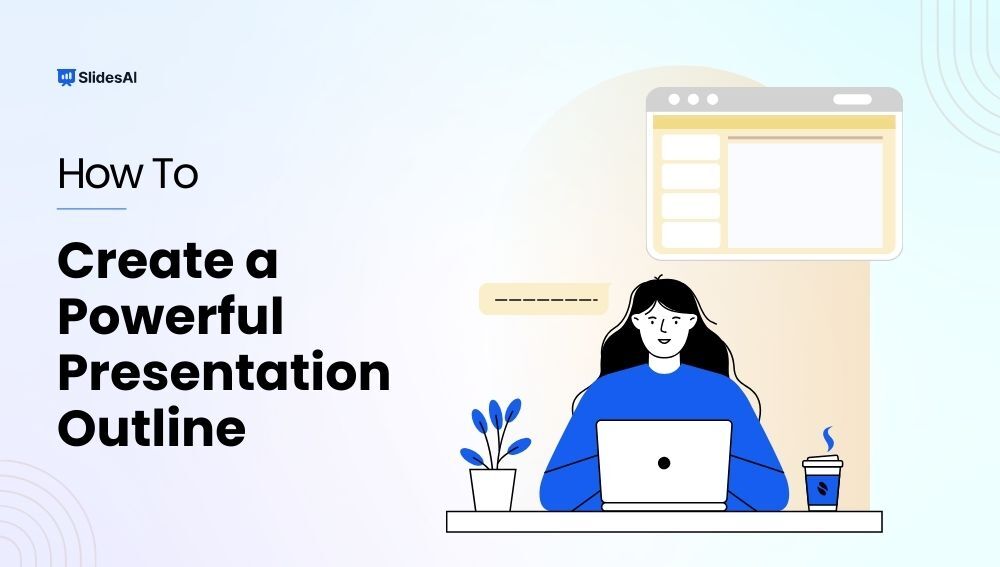
Table of Contents
What is a presentation outline.
A presentation outline is like a roadmap for organizing your thoughts and delivering your message smoothly during a presentation. It helps you structure your content logically, ensuring that your audience can follow along easily. By providing a clear framework, an outline enhances the clarity and effectiveness of your presentation.
Importance of Presentation Outline
1. Clarity and Focus
Using an outline keeps your presentation organized and focused, preventing you from going off track. It ensures that your presentation has a clear purpose and that all the information you share is relevant to your main points.
2. Logical Structure
A well-crafted outline ensures that your presentation flows logically, guiding your audience smoothly from one point to the next. This helps your audience follow your train of thought and understand your message more easily.
3. Enhanced Delivery
Having a clear outline can boost your confidence and make your delivery smoother. With a structured plan, you’re less likely to forget important points or ramble on, resulting in a more professional presentation.
4. Time Management
An outline helps you manage your time better by estimating how long each part of your presentation will take. This ensures that you stay within the allotted timeframe, keeping your presentation on track and engaging for your audience.

Create presentation slides with AI in Seconds in Google Slides
10M+ Installs
Works with Google Slides

How to Build Strong Presentation Outline s?
1. Purpose of Presentation
Understanding why you’re giving your presentation is crucial for planning its structure. Identifying your goal means thinking about what you want your audience to get out of it. This clarity forms the basis of your whole presentation. There are six potential reasons you might be presenting:
- Sharing information
- Teaching something new
- Making it enjoyable
- Inspiring action
- Convincing people of something
- Motivating them
Thinking about your goal will help you make a presentation that really grabs attention. Answering these questions can help you figure out what your goal is:
- What do I want people to learn or understand from my presentation?
- How will my presentation make a difference to those listening?
- What do I want people to do after my presentation?
Once you have the answers, you’ll have a good idea of what your presentation should cover and where to start.
2. Consider Color and Design
How you present your pitch matters just as much as what you say. Take a moment to think about the fonts and colors you’ll use on your slides. Research suggests that red can convey excitement and grab your audience’s attention, while white gives off a sense of simplicity and clarity.
3. Establishing Structure: Arrange Your Ideas in a Logical Order
When crafting your presentation, it’s important to structure your ideas in a clear and logical sequence. Start with an introduction to set the stage, followed by the main body where you delve into your key points, and wrap it up with a conclusion to summarize your main ideas.
4. Engaging Your Audience
When you’re getting ready for your presentation, think about how you can start off in a way that grabs everyone’s attention. You could ask a thought-provoking question, share an interesting story, or begin with a meaningful quote. The main thing is to get your audience interested right from the beginning and set the tone for the rest of your talk.
5. Adding Visuals
Give some thought to whether you want to include pictures, videos, or other visual stuff in your presentation. Even if your outline doesn’t mention exactly what visuals to use, you can suggest where they might fit in to help explain your ideas.
6. Encouraging Action
Come up with a clear and compelling message to encourage your audience to take action. Whether it’s encouraging customers to try out a new product or inviting people to join a demo, make sure they understand what’s in it for them. And if your presentation doesn’t really need a specific call to action, just wrap up by summarizing your main points and saying thanks for listening.
Alternatively, you can skip the hassle of crafting a presentation outline manually – try SlidesAI for seamless assistance .

Strategies for Crafting an Engaging Presentation
1. Understanding Your Audience
Take some time to know your audience by researching beforehand. This helps you adjust your presentation to connect with them better.
2. Enhance with Quotes, Testimonials, or Data
Make your presentation more interesting by adding extra info like quotes, testimonials, or data. It can make your audience more engaged and reinforce your message.
3. Visualize Your Concepts
How you show your ideas matters a lot. Tools like SlidesAI can help you express your concepts clearly and effectively.
4. Highlight Key Takeaways
Figure out the most important points you want your audience to remember. This makes it easier for them to recall and understand your message.
5. Seek Feedback
Ask for feedback to improve your presentation. It’s a good way to make sure it connects better with your audience.
Presentation Outline Example
Topic: The Impact of Social Media on Mental Health
Target Audience: College students
Time Limit: 15 minutes
I. Introduction (2 minutes)
Attention Grabber : Briefly discuss a real-life example of how social media can negatively impact mental health (e.g., cyberbullying, unrealistic beauty standards).
Introduce the topic : Clearly state the topic and its significance (e.g., “Today, I’ll be talking about the increasing impact of social media on mental health, particularly among young adults like yourselves”).
Preview : Briefly outline the key points that will be covered (e.g., “We’ll explore the positive and negative aspects of social media use, discuss common mental health concerns associated with it, and offer some tips for healthy social media habits”).
II. Main Body (10 minutes)
Positive aspects of social media:
Connection and community : Highlight how social media can help people connect with friends and family, build communities based on shared interests, and combat feelings of loneliness.
Information and self-expression : Discuss how social media can be a source of information, news, and inspiration, and provide a platform for self-expression and creativity.
Negative aspects of social media:
Social comparison and envy : Explain how constant exposure to curated online profiles can lead to social comparison, feelings of inadequacy, and envy.
Cyberbullying and harassment : Discuss the prevalence of cyberbullying and online harassment, their potential to significantly impact mental health, and the importance of online safety.
Addiction and anxiety : Explain how excessive social media use can lead to addiction, anxiety, and sleep disturbances.
III. Conclusion (3 minutes)
Summary : Briefly recap the key takeaways discussed in the presentation.
Call to action : Encourage the audience to be mindful of their social media usage and offer practical tips for developing healthy habits, such as setting time limits, curating their feed, and prioritizing real-life interactions.
Question and Answer : Allocate time for audience questions and address them thoughtfully.
- No design skills required
- 3 presentations/month free
- Don’t need to learn a new software

This is just a sample outline, and you can adapt and modify it based on your specific topic, audience, and time constraints. Remember, a well-structured and engaging presentation will effectively communicate your message and leave a lasting impression on your audience.
Frequently Asked Questions
How can ai help you create a presentation outline .
With the assistance of AI tools like ChatGPT and Gemini, crafting outlines becomes a breeze. Furthermore, you can utilize user-friendly online AI presentation tools such as SlidesAI to effortlessly generate your presentations.
Why is putting your outline on a slide a good idea?
Using a presentation outline can be helpful. It makes things clearer, boosts the speaker’s confidence, and helps manage information better. It also keeps the audience more engaged. But, if your presentation is fast-paced, casual, or focused on a specific area of expertise, you might want to keep the outline short and sweet. Just pick what works best for your situation and audience.
What is the format of the presentation outline?
There are various formats, but a common approach is using bullet points, numbered lists , or headings and subheadings. Choose the format that best suits your content and visualizes your information.
How can I adapt my presentation outline for different audiences?
Adapt your presentation outline by tailoring:
- Content : Depth, complexity, and examples based on audience expertise.
- Language : Formality, jargon, and storytelling to match audience and occasion.
- Visuals : Complexity and style to suit audience understanding.
- Delivery : Pace, volume, and even body language to audience energy.
- Focus : Highlight information most relevant to specific interests.
How long should a presentation outline be?
There’s no set rule; it depends on the complexity of your topic and presentation length.
Can I use a mind map to create a presentation outline?
Yes, mind maps can be a good way to visually brainstorm and organize presentation ideas.
What tools can I use to create a presentation outline?
You can use pen and paper, a word processing software like Microsoft Word, or dedicated outlining tools. Presentation software like PowerPoint also offers built-in outlining features.
Save Time and Effortlessly Create Presentations with SlidesAI

How to Write an Effective Presentation Outline
- By Herwin Jose
- April 17, 2024
Key Takeaways:
- A presentation outline is a structured plan that helps you organize and deliver a well-structured presentation.
- Creating an outline is important for organizing your ideas, ensuring clarity, and engaging your audience.
- Identify your objective, gather content, organize ideas, add supporting details, create an introduction, develop the body, and summarize with a conclusion.
- Tips for creating a compelling outline include keeping it concise, using bullet points, visualizing with headings and subheadings, including engaging elements, and practicing and revising.
What Is a Presentation Outline
A presentation outline is a structured plan that helps you organize and deliver a well-structured and engaging presentation. It serves as a roadmap, guiding you through the content, flow, and key points of your presentation. By creating an outline, you can ensure that your ideas are organized, your message is clear, and your audience remains engaged.
Importance of Presentation Outline

A presentation outline plays a crucial role in ensuring the success of your presentation. Here are some key reasons why having a well-crafted outline is important:
- Organization: A presentation outline will help you structure your thoughts and ideas in a logical and coherent way. It ensures that your presentation flows smoothly and that your main points are effectively conveyed to the audience.
- Clarity: By outlining the main ideas and supporting details of your presentation, you can clarify your message and avoid confusion. It helps you stay focused and deliver a clear and concise presentation.
- Engagement: An outline allows you to plan engaging and interactive elements , such as visual aids, examples, and audience participation. It helps you maintain your audience’s interest throughout the presentation.
Without an outline, your presentation may lack coherence and direction, leaving your audience confused and disengaged. By creating an outline, you can strategically plan the flow of information, ensuring that each point builds upon the previous one.
Elements of an Effective Presentation Outline
A well-crafted presentation outline consists of several key elements. In this section, we will discuss the essential components that make up an effective outline, including the introduction, body, and conclusion. Discover how to structure your outline to create a cohesive and impactful presentation.
- Introduction: The introduction sets the stage for your presentation and grabs the attention of your audience. It should include a compelling opening statement, an overview of what will be covered, and a clear thesis statement that highlights the main purpose of your presentation. By crafting a strong introduction, you can captivate your audience from the start.
- Body: The body of your presentation outline is where you will present your main ideas, supporting evidence, and arguments. Break down your content into logical sections or subsections, making it easy for your audience to follow along. Each point should be clearly articulated and supported by relevant examples or data. Use headings and subheadings to create a structured flow of information.
- Conclusion: The conclusion is your opportunity to wrap up your presentation and leave a lasting impression on your audience. Summarize the main points discussed in the body of your presentation and reiterate your key message. You can also provide a call to action or offer a thought-provoking question that encourages further reflection or engagement. A strong conclusion ensures that your presentation ends on a high note.
Tips for Creating a Compelling Presentation Outline

Crafting a presentation outline requires careful consideration of various elements. To enhance your outline and ensure a compelling presentation, it’s important to organize your ideas effectively, incorporate visual content strategically, and engage your audience from start to finish. Here are some practical tips and techniques to help you create an outline that captivates your audience:
Outline Organization
Start by identifying your main points and structuring your presentation in a logical order. Use headings and subheadings to create a clear hierarchy of ideas. This will help your audience follow along and comprehend the flow of your presentation.
Structure your Content
With your main ideas and supporting evidence in hand, it’s important to structure your content in a logical and coherent manner. This can be done by organizing your ideas into sections or segments that flow smoothly from one to the next.
“A well-structured presentation will capture the attention of your audience and keep them engaged throughout.” – John Smith, Speaker and Presentation Expert
Incorporate Visual Content
Visuals can significantly enhance the impact of your presentation. Consider using images, graphs, charts, and videos to support your key points. Visual content not only adds interest but also helps reinforce your message and make it more memorable.
Engage Your Audience
A successful presentation is interactive and engages the audience throughout. Incorporate interactive elements such as polls, Q&A sessions, or group activities to encourage participation. This will not only keep your audience engaged but also make your presentation more memorable and impactful.
“A well-structured presentation outline acts as a roadmap to guide both the presenter and the audience. It helps maintain a logical flow of ideas and ensures that key messages are effectively communicated.” – Jane Smith, Presentation Expert
Learn from Presentation Outline Examples
Take inspiration from real-life examples of effective presentation outlines. Analyze how others have organized their content, used visuals, and engaged their audience. By studying successful presentation outlines, you can gain valuable insights and ideas to enhance your own.
Pay Attention to Color and Design
Creating a presentation outline is crucial when it comes to making a good presentation. Start by brainstorming ideas on color and design that will create an impact. Using a presentation outline template helps in organizing your thoughts and structuring the main body of your presentation. When creating your outline, make sure to include a slide for each point you want your audience to take away. Consider the font and design of your presentation slides to ensure your audience stays engaged.
Including a Call to Action
To ensure your presentation design is on point, you should make a presentation outline that includes a call to action. When you have created your presentation outline, you can use presentation templates to help you make a presentation that is both visually appealing and engaging for your audience.
When writing a presentation outline for a new product, it’s a good idea to answer these questions:
What should be included in your outline to make a creative presentation? How can you make a presentation that leaves a lasting impact on your audience? By including a call to action as a part of your outline, you can create an effective presentation that encourages your audience to take action after the presentation is over.
Review, Revise, and Refine
Once you have created your initial outline, review it carefully. Ensure that it aligns with your presentation goals, effectively communicates your message, and maintains a logical flow. Revise and refine as needed, keeping your audience’s perspective in mind.
Step-by-Step Guide to Create an Effective Presentation Outline

Creating a presentation outline is an essential step in delivering a successful and impactful presentation. A well-structured outline helps you organize your thoughts, maintain a logical flow, and ensure that you cover all the key points you want to communicate to your audience.
Brainstorm and Define Your Objectives:
Start by brainstorming ideas and determining the main objectives of your presentation. Consider what information you want to convey, the key messages you want to deliver, and the desired outcomes you want to achieve.
Identify Your Main Points:
From your brainstorming session, identify the main points you want to address in your presentation. These should be the key ideas or concepts that support your objectives and help you effectively convey your message to the audience.
Organize Your Thoughts:
Once you have identified your main points, organize them in a logical sequence that flows naturally. Consider using headings and subheadings to create a hierarchical structure that guides your audience through the presentation.
Add Supporting Content:
Think about the supporting content that you need to include for each main point. This can be facts, statistics, examples, case studies, or visuals that help reinforce your message and provide additional context to your presentation.
Summarize Key Takeaways:
At the end of each main point or section, summarize the key takeaways or messages you want your audience to remember. These should be concise and impactful statements that leave a lasting impression.
Review and Refine:
Once you have created a draft of your presentation outline, take the time to review and refine it. Ensure that the structure is clear, the content is well-organized, and the flow is logical. Make any necessary adjustments or additions to improve the overall effectiveness of your outline.
1. What is a presentation outline?
A presentation outline is a roadmap or blueprint that helps you organize your ideas and content for a presentation. It outlines the structure, flow, and key points of your presentation, ensuring a logical and cohesive delivery.
2. How can I engage my audience throughout my Business presentation?
To engage your audience throughout your presentation, consider using storytelling techniques , interactive elements, or thought-provoking questions. Encourage audience participation through activities, discussions, or Q&A sessions. Use visual aids, such as images, videos, or graphs, to enhance understanding and maintain interest. Finally, deliver your content with enthusiasm, clarity, and confidence.
3. What are the three basic parts of a presentation outline?
When creating a presentation outline, it is crucial to include three essential components. The first part is the introduction, which sets the stage for the presentation and provides background information. Following the introduction is the body, where the main points and supporting details are discussed in depth. Finally, the outline should include a conclusion that summarizes the key points and reinforces the main message.
4. What are the 5 pieces of presentation Outline? The 5 key pieces of an outline include the introduction, main points, supporting information, visuals, and conclusion. Each section plays a vital role in delivering a clear and impactful message to the audience.
Execute Your Presentation Outlines With PREZENTIUM
Are the endless hours crafting presentation outlines leaving you exhausted and your slides less than stellar? PREZENTIUM is set to change your presentation game.
Our Overnight Presentation Service ensures that your basic presentation outline submitted in the evening is transformed into an impressive final presentation by the next business day.
Impressive Presentations: Dazzle your audience with our top-tier templates and meticulously designed slides. Dedicated Expertise: Our adept team is on standby to join meetings, refine your notes into presentations, and ideate designs that make your message shine. Solid Content: We’re committed to problem-solving, structuring your presentation, and crafting content that engages and connects with your audience.
Bid farewell to the drudgery and embrace effectiveness. Craft an impressive presentation with PREZENTIUM now!
Why wait? Avail a complimentary 1-on-1 session with our presentation expert. See how other enterprise leaders are creating impactful presentations with us.
12 Reasons Why Business Communication Is Important
8 tips on how to improve communication skills, 11 tips on how to make a good presentation.
December 4, 2023
How to create a presentation outline (with examples)
Four methods to create a presentation outline and example outlines for inspiration
Co-founder, CEO
Like it or not, if you work in an office environment or go to school, you'll probably have to make a presentation at some point. But creating a great presentation can be challenging, especially when you're short on time or suffering from writers' block.
Luckily, there are lots of ways to get a head start on your presentation outline, and in this article we'll walk through four options for creating a presentation outline and show you several examples of great presentation outlines.
Why should I write a presentation outline?
An outline helps you organize your ideas in a clear and logical way . Instead of getting bogged down on details like formatting or word choice, an outline presents the overarching story of your presentation with just a few main points. This helps to make sure you have a cohesive narrative before you dive in to the nitty gritty work of wordsmithing individual bullet points or selecting the perfect slide theme.
If this sounds like a lot of work, it often is! But spending time writing a great outline will save you time and effort down the road because it will be easier to organize your work and create each slide when you understand how it fits in to the broader presentation.
Here are four ways you can get a start on creating your next presentation outline.
Method 1: Create your outline from scratch
Creating an outline from scratch may sound intimidating if you have never written a presentation outline before, but this is the most straightforward way to get started.
Start by jotting down the three main points you want to make in your presentation. Once you have your main ideas in order, write down a few supporting details and examples for each point.
Then, add an introduction (find an interesting image, quote, or question to help grab the audience's audience) and a conclusion (decide on the best way to summarize the takeaways from your presentation) to the outline, and you are ready to go.
This method is great for those who prefer to have complete control over their presentation and want to create a custom outline that works best for their needs.
Method 2: Create a presentation outline using an AI presentation maker
If you're short on time or looking for a quick way to get a first draft of a presentation outline that you can then refine, using an AI presentation maker is a great option.
Plus AI lets you type a short prompt like "Create a presentation that provides an overview of the Norwegian oil industry," and it will automatically generate an outline of a presentation for you. After Plus creates the outline, you can change the titles of slides, rearrange slides, and remove any pieces of the outline that are not necessary.

From there, once your outline is created, you can click the "Generate presentation" button, choose a template, and let the AI create the first draft of your entire presentation.
This method is a good option for those who want to create a polished presentation without getting stuck with a blank piece of paper. Instead, it frees you up to take a first draft presentation and customize it for your needs.
Method 3: Create a presentation outline using ChatGPT
ChatGPT is an AI chatbot that can help with a wide variety of tasks - everything from acting as a therapist, to sharing recipes, to helping you come up with presentation ideas and creating content for a presentation .
To have ChatGPT help you generate a presentation, you can take two different approaches:
- Use a custom GPT that has been trained to help people create presentations or
- Ask the general ChatGPT interface to "Create a presentation outline for me on the topic of [XYZ]."
Both approaches will yield similar results, but a custom GPT like Plus AI presentation maker will be more fine-tuned to helping people create presentations. It will also provide additional functionality like providing a visual preview of the slides and feedback on how to improve your presentation.
Method 4: Create a presentation outline using a template
Last but not least, using a template is a good way to speed up the process of creating a new presentation outline. Similar to using an AI presentation maker, a template can give you a first draft of an outline that is easier to edit and refine than starting from scratch.
Presentation templates often come pre-designed with example text and images, so all you have to do is fill in your own content. For example, this TED Talk presentation template provides some instructions on how to create an outline for a TED Talk-style slide deck.
The secret to using this method is to find the closest template to the type of presentation you want to create. You should use detailed search terms to and look across multiple sites and resources to find one that matches the content and style that you would like.
Once you have your template, start by reviewing the overall outline or structure and tweak it to meet your needs. Then, you can fill in the specific content (e.g., text and images) with your materials to make it your own to quickly make a beautiful presentation.
Presentation outline examples
Basic presentation outline example.
Let's take a look at a presentation outline and accompanying notes for a persuasive presentation on encouraging people to meditate every day:
I. Introduction
- Hook - find a striking image and tell a story
- Thesis statement - everyone should meditate for 10 min per day
II. Main point 1 - Meditation is one of the easiest ways to improve your health
- Physical health
- Mental health
III. Main point 2 - Meditation is backed up by thousands of years of practice and research
- One anecdote from antiquity
- One anecdote from recent research
IV. Main point 3 - You can get started with meditation today
- Basic technique
- Tips for newcomers
V. Conclusion
- Summarize key points
- Call to action
As you can see, this is a relatively lightweight plan for the presentation, but it provides an easy-to-understand framework that we can fill in with slides.
There are rough notes on specific content for the different points in the presentation, but we don't need to write out everything in fine detail, just the broad strokes.
Pitch deck outline example
Now let's review an outline for a pitch deck that someone might use to present their startup idea to prospective investors. This is for a startup that uses autonomous food trucks to deliver meals to people's homes and workplaces.
I. Problem statement - "Food delivery sucks, and here's why"
- Hook - pictures of typical food delivery headaches (e.g., late/no show, bad selection, etc)
II. Value prop - "FoodDrive revolutionizes the food delivery model"
- Compare value chain of FoodDrive to traditional restaurant and delivery service
- Show how $50 order gets allocated to different people
III. The product - "Customers love our trucks"
- Picture of food truck and menu
- Customer quotes and reviews
IV. Why now? - "Our self-driving technology is ready for prime-time"
V. Business model - "Each truck can generate $2-3M of revenue per year with a 60% gross margin"
- Show high-level financial forecasts on unit basis
VI. Competitive landscape - "FoodDrive's closest competitors don't come close"
- Comparison table with delivery services, in-house delivery, eating out-of-home, etc.
VII. Go to market strategy - "We've tested FoodDrive in 2 markets so far. Here's how we win in new markets"
- Overview of social media strategy
- Case study on new market launch
VIII. Team - "Our team has experience in autonomous vehicles, food delivery, and quick service restaurants"
IX. Traction - "We generate $5M of revenue per year with our 2 trucks, and we can ramp up new trucks immediately"
- Show revenue growth chart with focus on time to ramp new trucks to productivity
X. Fundraising goal - "We are raising $50M to expand FoodDrive to 10 more markets"
- Highlight key milestones we aim to reach with additional funding
Even though a pitch deck is a specialized type of presentation that often requires specific content, it's helpful to start with an outline to build out the 'story' behind the content. That way, you have a cohesive story rather than a set of disparate slides.
How can I create a presentation from an outline?
Once you have your presentation outline written, it's time to start writing your slides. Since you already know the main points you are trying to make in your presentation, the main decisions here are
- What type of visual style you want to follow
- How many slides you want in your presentation
- How you will present or share the slides
To get a head start on creating a first draft of your presentation, you could enter your outline into an AI presentation maker.
This will provide a first draft of the slides so that you can focus on making sure they tell a cohesive story or tweaking individual slides to leave a memorable impression.
Other tips and tricks for great presentations
Here are some resources to help you create great presentations:
- Make slides look good - Here are six tips for making visually appealing slides.
- Number of slides - Here is a calculator that can help you calculate how many slides you need for a presentation depending on how long you need to present.
- Unique presentation ideas - Here are 250 ideas for presentation topics that will help you create a great presentation.
Creating a presentation outline can be one of the most time-consuming parts of the creative process for making a new slide deck. Luckily, there are many tools and templates that can help you kickstart this process.
With these four methods, you can choose the one that works best for your needs and get started on your presentation outline today.
And once you have your outline, make sure to try out a tool like Plus AI presentation maker to quickly get your slides as well!

Latest posts
Latest post.

Everything you need to know about Pecha Kucha
An overview of Pecha Kucha, example Pecha Kucha presentations, and tips for your next presentation

PowerPoint Karaoke
Overview of PowerPoint Karaoke, rules, and free slide decks for PowerPoint Karaoke
Why Chatbots Aren’t Working
Four reasons chatbots are not the right interface for AI
More resources

How to end a presentation
Not quite sure how to wrap up your slideshow? We’ll explain what you need to successfully end your presentation along with a tool for creating the slides.

How to start a presentation
Looking for a good way to start a presentation? We’ll walk you through several types of example openings you can use to get your audience’s attention.

How to convert YouTube to PowerPoint
Have a video that would make the perfect presentation? We’ll show you how to convert YouTube video content to PowerPoint a couple different ways using Plus AI.

How to Outline a Presentation: A Complete Guide From a Pro
- Filed under: Public speaking articles , Speaking tips , Speech preparation
When you’re writing an important speech, you must start with a clear outline. However, I find that many speakers are uncertain of how to write a good outline for their presentation. This is why I decided to write a guide for you, in hopes that learning to perfect your outlines will help you give better presentations in the future.
How do you outline a presentation? Always start with your introduction and end with your powerful closing. Flesh out the body by listing topics in the order that you want to cover them in. Never skimp on the important details of your speech. Remember that an outline is only a draft.
I know at this point that you still have questions, and that you still be confused at how to write the best outline for your speech. But writing a good outline for your presentation does not have to be stressful! This is my complete guide from a pro for you, in hopes that you can take the stress out of this important step.
Table of Contents
How to Outline a Presentation
Outlining a presentation can be done with a regular piece of paper, or on a word processing program on your computer. If you are hosting a PowerPoint presentation, you may prefer to do the entire thing from the comfort of your computer. But if you do decide to write your outline on a piece of paper, make sure you use a pencil and eraser so that you can make changes as you go along.
The very first step in creating an outline is to ask yourself what the purpose of your presentation is.
Write your main message or a one-sentence summary of your thesis at the top of your outline when you get started. This may help you stay on task, and it will keep the purpose of your speech right in your eye’s sight. After all, you don’t want to stray too far off the main topic of your presentation !
Remember, a quality outline is meant to enhance the purpose of your presentation. If you do not write a proper outline, you may risk not properly conveying the right message to your audience.
Or you may even forget to cover essential points that you wanted to talk about. A thorough outline is especially important if you are planning to speak without notes.
You should remember to properly summarize what you want to say with every sentence of your outline. After all, this is not a full script, so a summary is all you really need. Remember to rehearse and practice with your outline, so that you can remember what you have written.
Start With a Strong Beginning
Your introduction is where you start strong by grabbing your audience’s attention from the very beginning. But if that makes you feel stressed out, just remember to stay calm! Creating a great first impression from the beginning of your speech is not as difficult as you might be worrying.
When you create a strong beginning, you should try some of the following:
- Start with an attention-grabbing statement that captures your audience from the start. If you have a few ideas but are not sure what to use, try running your ideas by a trusted friend or mentor.
- Give a strong signal that you are beginning your speech. You don’t want your audience unsure of whether you’ve actually begun or not.
- Give the main thesis statement about the purpose of your presentation.
- You could start by giving a brief preview of all of the things that you are going to talk about in the body of your speech.
- Talk about your credentials at the beginning. However, you should make sure to find a way to do it that is entertaining. You don’t want to risk boring your audience from the very beginning of your speech!
- Thank your audience from the very beginning! This is not only a good way to begin your speech, but a good way to end it, as well.
- If there are any current events or famous historical events that relate to the purpose of your presentation, you can start by talking about these. However, pick only one so that you do not draw your introduction out too long.
- Ask your audience a question at the beginning. You could draw out their interest by answering this question at a later point in your speech.
- Whenever possible, make sure you begin your speech on a positive note . This sets a good tone for the rest of the presentation.
- Start by telling a story that relates to your presentation. A good reason to start with a story is that it helps you form a strong connection with your audience from the beginning. Write some of the main details of your story in your outline so that you remember them.
Be reminded thought, that sometimes it is wise to write your introduction last as only you know what you’ll be introducing. This way, you’ll also avoid including something in your introduction that you won’t be actually talking about.
Once you have written out your introduction, you have completed the first step in creating an excellent outline for your presentation.
Create a Powerful Ending
In my experience, it can be easier to create ending before you flesh out the body of your presentation. However, it is up to you if you prefer to create your outline in a different order.
If you are a regular reader, you might have realized that I already posted an in-depth article here about how to end a presentation in a powerful way . Right now we are going to talk about the same thing in somewhat less detail.
Recommended books
How to Deliver a TED Talk: Secrets of the World's Most Inspiring Presentations
Jeremy Donovan
Resonate: Present Visual Stories that Transform Audiences
Nancy Duarte
Confessions of a Public Speaker
Scott Berkun
Talk Like TED: The 9 Public-Speaking Secrets of the World's Top Minds
Carmine Gallo
The Checklist Manifesto: How to Get Things Right
Atul Gawande
The First 20 Hours: How to Learn Anything... Fast!
Josh Kaufman
Just like with your beginning, make sure that you’ve made it obvious you are ending. After all, few things are more awkward than your audience sitting there long after you’ve finished, feeling confused about whether they should leave or not.
If the point of your speech is to motivate your audience to do something, you might consider ending your speech with a call to action . A call to action is simply an instruction that you give your audience about something you want them to do.
You could also potentially end your presentation with a powerful quote or an entertaining story . And if you have a unique tagline that exists to help promote your personal brand, consider ending with it.
But if you are planning to have a question and answer period at all, make sure you are not directly ending with one. Plan to wrap up your question and answer period before delivering your speech’s closing at the end.
This is because ending with a question and answer period is not only not memorable, but a negative question from an audience member can leave a bad taste in everyone’s mouth . This is not the last thing you want your audience members to remember as they’re leaving!
And as always, you should thank your audience at the end of your speech. This will make them feel valued, and impressed with your gratefulness.
Flesh Out the Body of Your Presentation
So, you’ve got your beginning and ending all figured out, but now what else do you do with your outline? This is the stage where you work on the body of your speech. That is, you will want to think about what you want to say in between your beginning and end. Here are some speech writing tips I have written about previously.
Write the main points of your outline in order
It may be easier for you to write bullet points or even a numbered list. List your main points in order of what you want to talk about. If at first glance the topics don’t seem to flow, it is okay to re-arrange them.
You can also decide at this point if there is anything you want to add or subtract. If you feel like you’ve made a mistake, don’t worry! It is okay to make any changes along the way.
Add sub-points and transitions to your topics
Add sub-points to your main points in order to further flesh out your outline. Even if you want to keep it simple, sub-points may help you to stay on track and remember what you were going to say.
You can also add to the ideas that your main points present. Make sure that the transitions from one point to another flow smoothly from one thing to the next.
Don’t forget the essential details!
Are there any special details that you need to remember for your presentation? Put these in your outline so that you don’t forget them. This can include important names, dates, and locations that you need to remember.
Write down how long will it take
If your speech is supposed to cover a certain amount of time, try listing times for each of your main points. This may help you not go over or under your time.
Also, take a look at these articles:
- 11 Great Tips How to Write a Great Persuasive Speech
- How to Deliver a Perfect Elevator Speech
How to Outline a PowerPoint Presentation?
You may be thinking that you don’t need an outline for your PowerPoint presentation. However, don’t rely on your slides alone ; you need a proper outline, too. An outline for a PowerPoint presentation should also include images that you intend to use for your slides.
Fortunately, the PowerPoint program itself also allows you to view an outline of your slides. This can help give you a visual of your overall presentation.
Remember, This is Only a Draft!
If your outline isn’t the way you want it to be, remember that it is only your very first rough draft. Your outline doesn’t have to be perfect, because it is not your final product. While you should work hard to make your outline as good as possible, you don’t need to stress about it.
And remember that if you finish your outline, and you are not satisfied with how it looks? It is okay for you to scrap it and start all over again. There is no reason that you should stick with an outline that you don’t feel confident about.
An outline is a great place to start whether you intend to read from a full script, read from cue cards, or speak without notes. If you are an avid reader of Speak and Conquer, you’ll remember that I recommend creating an outline in many of my articles.
Get Feedback From Others About Your Outline
There is no reason that you have to go any of this by yourself. If you have a friend or mentor who is experienced with public speaking , why not ask them to take a look at your outline for you? They may see something that needs to be changed that never even occurred to you.
You could also give a practice round of your speech in front of a friend, family member, or mentor. Give them a chance to make suggestions about whether or not there’s anything that you should change. After all, it’s better for you to realize if something needs to be done differently before the actual day of the presentation.
If you don’t have someone who you can rehearse in front of in person, try recording your presentation in front of a video camera . Show it to someone you trust via email or social media. If they have any suggestions for change, you can alter your outline accordingly.
Why is a Presentation Outline so Important, Anyway?
While reading this article, you may be wondering why you even need an outline for your presentation. This may be especially puzzling to you if you are planning to give a speech without notes . But I find that an outline can be incredibly useful no matter what kind of presentation you are planning to give to your audience.
Like I said before, the main point of an outline is to enhance the main purpose of your speech further. But I’m also going to give you a list of some more reasons why I believe an outline is absolutely essential.
Some other good reasons for creating an outline for your presentation are:
- You will have an easy visual to look at the order of the topics you are talking about. This way, you can see if anything looks out of place.
- The proper outline will help to keep your speech organized.
- You will be able to look at the connections between your ideas . This may even help you realize you need to add or subtract certain things from your speech.
- A good outline will help you remember to t ouch on every important point that you need to cover in your presentation.
- Outlining helps you see whether or not your main points and sub-points flow smoothly . If you create your outline and realize that some of your points do not flow, you can easily re-write key parts.
- Using an outline instead of a full script will give you more freedom to improvise during your presentation. This is why creating an outline is a great first strategy if you are speaking without notes, or trying to memorize a speech in a short period of time.
- If you’re not sure where to start preparing for your speech, then writing a loose outline is a good first step to help you out.
- Practicing with an outline will help enhance your memory about the main points and sub-points of your presentation.
No matter what kind of presentation you are planning to give, a solid outline with help you be prepared and ready to go.
Conclusion: How do you make an outline for a talk?
Today, I have compiled a thorough guide about writing a quality outline. We discussed creating a good beginning, ending, and body of your presentation. We have even talked about why a good outline is important, too. If you have any other tips to share about creating an outline for your presentation, make sure to share them in the comments section.
If you are looking to improve your public speaking and presentation skills, check out the rest of my articles on Speak and Conquer. The purpose of my site is to help you succeed in becoming a better public speaker. For example, I have covered popular topics such as how to memorize a speech in less than an hour , and how to use hand gestures effectively during a presentation .
Related Questions
What software should I use to outline my speech? Preferably, you should have a program that allows you to use bullet points or numbered lists. Bullet points and lists are a good place to start when you are outlining. Microsoft Word, Word Processor, or Notepad are acceptable for basic outlines.
How do I decide what the purpose of my speech is? Decide if you are there to inform, educate, motivate, or entertain your audience. When you have narrowed it down to just one of those, you will be able to decide the main idea of your speech. You should preferably speak about a topic that you are well-educated about.
How do I write a speech? Start with a purpose, and then create a detailed outline. Flesh out the points and sub-points from your outline. Decide very early on if you want to give your speech with or without notes. Revise your drafts as much as possible until you have created a full speech. If you are going to speak with notes, write some of the information from your outline onto cue cards.
Useful reading
- 16 secret ways how to speak to a bored audience
- How to Use Your Voice Effectively in a Presentation?
- 13 Effective Ways How to Make Speech Pauses
Posts about public speaking you may also like

How to speak with confidence in public?
No matter what your field of expertise is, public speaking can make or break your career. If that sentence fills you with self-doubt, you’re not

How to Speak to a Large Audience?
When it comes to speaking in front of a large audience, there are all sorts of chicken and egg issues. If you just tell yourself

9 effective Ways How to Teach Public Speaking to Kids
There are a lot of kids who are getting anxious when their parents force them to go out and meet other people. This is because
- Tags: Effective speaking , Good speech , Pauses in speech , Speech preparation process , Speech skills , Speech tips , Unprepared speech , Unprepared speech topics
Recommended gear

Best Portable Speakers For The Presentations

Best Video Cameras for Public Speakers

Best rresenter remotes for public speakers

Best Portable Thumb Drives And Hard Drives for the Presentations
Who is janek tuttar.
My name is Janek Tuttar , and I am the founder and author of Speak and Conquer website.
I have been teaching public speaking at Estonian Entrepreneurship University of Applied Sciences
Here, I am sharing the wisdom of how to cope in different public speaking situations.
More information about Janek »

Share this post

Hi! My name is Janek Tuttar, and I am the founder and author of SpeakAndConquer.com.
I have been teaching and blogging about public speaking since spring 2007. Here, I am sharing the wisdom of how to cope in different public speaking situations.
Send me an e-mail: [email protected]
LEGAL INFORMATION
This site is owned and operated by Janek Tuttar. SpeakAndConquer.com is a participant in the Amazon Services LLC Associates Program, an affiliate advertising program designed to provide a means for sites to earn advertising fees by advertising and linking to Amazon.com.
This site also participates in other affiliate programs and is compensated for referring traffic and business to these companies.

Best teleprompters

Best Computer Mice for the Presentations

Best Laptop Backpacks for Public Speakers
- Strategy & planning
How to make a presentation outline: a step-by-step guide
Georgina Guthrie
May 24, 2024
Whether you’re building a house, baking a cake, or creating a killer presentation — having a plan in place before you begin work will make the task much easier. Planning saves time and enhances the quality of your work. This is especially true for business presentations, which is why you should always start with a presentation outline.
A presentation outline is a streamlined version of your talk, capturing the general direction and key points. Its purpose is to shape your thinking, organize your thoughts, and ensure your material is presented logically.
In this article, we’ll explore what a presentation outline is, how storytelling can engage your audience, and how to create a flawless outline. Let’s dive in.
Defining your presentation’s goal
What are you trying to achieve with your presentation? A good starting point is to think about the overall purpose.
Types of presentation goals
There are six main types of presentation goals:
- Inspire action
- Inspire or motivate
In a business setting, ‘to inform’ is most common, but it’s usually coupled with at least one other. For example, if you’re there to talk about quarterly results, then you’ll want to inform and motivate. However, if you’re a business coach, your goals will likely be to inspire, motivate, and entertain.
Once you’ve defined your goal, you’ll want to understand the impact you hope to have on your audience. To answer this, ask these questions:
- What do I want people to take away from my presentation?
- How will what I talk about help others in the room?
- What do I want people to do after my meeting?
From here, you should be able to create a summary of your presentation’s goals and purpose in one or two sentences. Put that on your first slide for easy reference.
Understanding your presentation’s audience
Knowing your audience is crucial for crafting a presentation that resonates. Consider their knowledge level, interests, and what they hope to gain from your presentation. Tailoring your content to meet their expectations will make your presentation more engaging and effective.
Questions to understand your audience
- What is the demographic makeup of your audience (age, gender, profession)?
- What are their roles in the organization or industry?
- How familiar are they with the topic you will be presenting?
- Do they have any preconceived notions or misconceptions about the topic?
- What are their primary interests related to the topic?
- Why are they attending your presentation? What do they hope to gain?
- What are their current pain points or challenges related to the topic?
- How can your presentation address these challenges?
- Do they prefer visual aids, interactive sessions, or straightforward lectures?
- Are they more inclined towards data-driven insights or anecdotal evidence?
Choosing your story structure
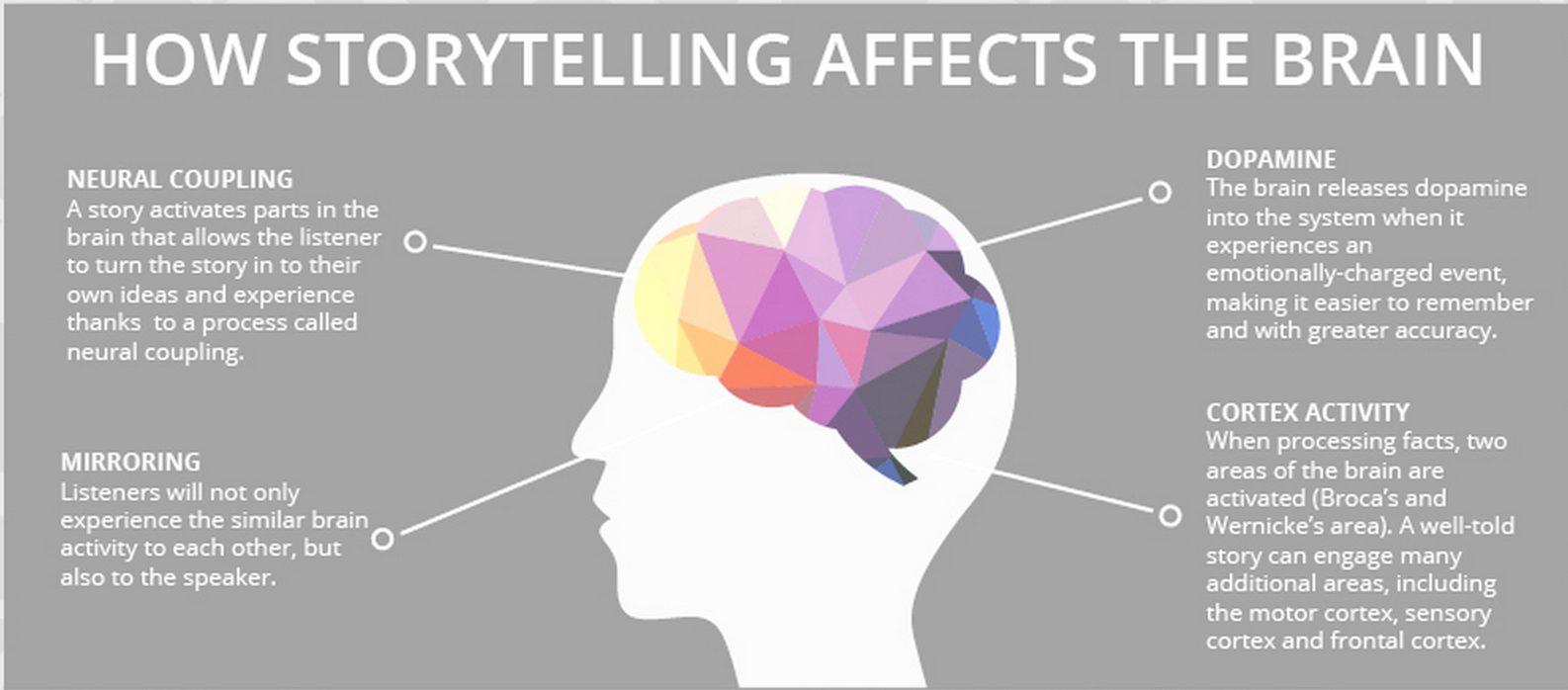
Stories are powerful tools for bringing people and ideas together. Great stories persuade and inform; the best stories inspire and stay with us. But we don’t often see this happening enough in the boardroom.
Stats and numbers are important for supporting claims, but if you want to inspire your audience, you need to weave those stats into a story. T he truth is, most stories are formulaic, so once you’ve chosen your formula, filling in the blanks is pretty easy.
Let’s look at a few popular story structure formulas below.
1. Fact and story
Mixing storytelling with facts works in a kind of mutually supportive cycle. Facts add substance to the story; the story adds interest to the facts.
In this structure, you weave the two together and move back and forth between the two.
- Start with a ‘what if’ question. For example, if you were pitching a vacuum cleaner, your initial sales pitch might be ‘what if you didn’t have to lose suction?’
- Add facts that illustrate the current state of things. To continue with our example, it might be current stats on traditional vacuums losing suction. Keep alternating facts with fiction throughout the body of your presentation.
- End on a high note that makes the listeners feel like they learned something and want to move to action because of it. For example, to invest in your new product, or to sponsor your new app .
2. The hero’s journey
From Odysseus to Chihiro , adventure stories typically feature a hero who goes on a journey fraught with peril and learns a vital lesson at the end of it. It’s a formula employed by thousands of writers — and you can draw from it to add some drama to your presentation.
This structure works really well for inspirational personal stories, or tales about a company from its humble beginnings to the success it is today.
- Begin somewhere neutral. The situation is neither ideal nor unbearable.
- Introduce a challenge — one that needs to be solved.
- Present a worsening situation. The problem is being addressed, but things are still getting worse.
- Define rock bottom. The situation seems impossible; there is apparently no way forward and all seems lost. Until…
- Introduce a new discovery that offers hope.
- Show your work. Armed with your new abilities, you tackle the issue head-on.
- Resolve the problem, but instead of returning to the way things were before, the hero (you) discovers an even better way of living.
- Finish with a lesson, which you can share to inspire your audience.
3. The pitch
The ‘pitch’ style of presentation is commonly used by salespeople. The goal is to show how a product or idea can help an individual overcome a hurdle toward a positive outcome. The story should be relatable, so the audience can picture themselves in the situation and, therefore, benefitting from the solution.
- Start with a summary of the way things are in simple terms.
- Introduce the problem or hurdle that needs solving. Make it relatable to help your audience put themselves in the situation.
- Introduce a solution: give your audience a glimpse into a possible solution.
- Create a fork in the road: Give your audience a couple of options for solving the problem. Offer an average option first, then follow up with a better one.
- Close: Choose the better option and explain why that’s the best one (and only real suitable choice).
- Finish up by telling the audience exactly how to solve the problem , step by step.
- Talk about extra benefits that extend beyond simply solving the problem. Finish on an uplifting high.
4. The explanation
This presentation format is for when you want to teach your audience something — whether that’s a process, a new skill, or a way to overcome a problem. It has similarities with the fact and story structure, insomuch as facts should weave into the story.
- Explain how things are at the moment , what the goal looks like, and how you plan to get there. You can even start with a story to add emotional interest from the get-go.
- Take your first step on the journey toward the final destination.
- Add more steps that build on this.
- Take a moment to recap the points you’ve covered so far while tying them to the main point. This will help your audience visualize the ground you’ve covered and see where you’re heading.
- Add the finishing pieces to the puzzle and lead your audience to the end.
- End your journey so your audience feels as though they’ve learned something new.
5. The opportunity
A close relative of the pitch, this three-part structure swaps a hurdle for an opportunity. Here, you want to show your audience that a problem they thought they had actually had an easy fix.
- Start with the situation as it is now.
- Next, add a ‘but’ — this could be a small hiccup that stops things from being as good as they could be. For example, our chocolate pudding company is doing really well. But we could be doing better if we changed supplier.
- Talk about the opportunity, with as many facts and stats as possible to make it feel achievable and real.
- Add a conclusion.
- Explain why the product or service meets the challenges raised. Add more stats and facts to support your point.
Storyboarding your presentation outline
Now you’ve worked out your structure, it’s time to start building your presentation. Storyboarding is the best way to do this. In the same way that directors use storyboards to map out their films scene-by-scene, you’re going to use it to map out your presentation slide-by-slide.

(Don’t worry, you can do stick people and squiggles if drawing isn’t your strong point.) Image Source
The trick here is to avoid adding too much detail too quckly. Ideally, have one or two sentences on each slide summarizing what each one will address. Stick to one main point per slide and no more than 3 subpoints.
You can do this with pen and paper, but since you’ll likely end up going digital eventually, you might as well start there. It looks far neater, and it means that if you need to change something, it’s as simple as deleting or editing a cell or slide rather than starting over.
If you don’t want to start from scratch, a business presentation template is a great place to start. You can storyboard directly on the template, and then flesh out each of the slides in more detail once you’re ready.
Once you’ve got your storyboard mostly ready, all that’s left is to fill in the details! And of course: make it look great.
Formatting your presentation
Proper formatting is crucial to ensuring your presentation is visually appealing and easy to follow. Effective formatting helps to highlight key points, maintain audience engagement, and enhance overall comprehension. Here are some guidelines and best practices for formatting your presentation:
Choose a consistent theme
- Use a professional and clean template that aligns with your topic and brand.
- Ensure the template is consistent throughout the presentation to maintain a cohesive look.
- Choose a color scheme that is visually appealing and easy on the eyes.
- Stick to 2-3 primary colors to avoid visual clutter.
Organize your slides
- Include a title slide with the presentation topic, your name, and date.
- Add a relevant image or graphic to set the tone.
- Provide an agenda or outline slide to give the audience an overview of what to expect.
- Use section divider slides to clearly separate different parts of your presentation.
- Include a brief title for each section.
Keep text clear and concise
- Use easy-to-read fonts such as Arial, Helvetica, or Calibri.
- Avoid overly decorative fonts that can be hard to read.
- Ensure the font size is large enough to be readable from a distance.
- Titles should be at least 24-30 points, and body text should be 18-24 points.
- Use bullet points to break down information into digestible chunks.
- Keep each bullet point concise, ideally one line each.
Visual elements
- Include high-quality images, charts, and infographics to illustrate key points.
- Ensure visuals are relevant and add value to the content.
- Maintain consistency in the style and size of images and graphics.
- Align visuals properly to avoid a cluttered appearance.
- Use white space effectively to prevent slides from looking overcrowded.
- White space helps to highlight key elements and improves readability.
Multimedia and animation
- Embed short videos to demonstrate concepts or provide visual examples.
- Ensure videos are of high quality and relevant to the content.
- Use animations sparingly to emphasize important points without distracting the audience.
- Stick to simple transitions and avoid overly complex animations.
Data presentation
- Use charts and graphs to present data clearly and concisely.
- Label axes and include legends for clarity.
- Avoid overwhelming the audience with too much data.
- Highlight key data points and trends.
Final touches
- Review the presentation for spelling and grammatical errors.
- Ensure all information is accurate and up-to-date.
- Rehearse your presentation multiple times to ensure smooth delivery.
- Check the flow of slides and the timing of animations and transitions.
By following these formatting guidelines, you can create a presentation that is not only visually appealing but also effective in communicating your message. Proper formatting helps to keep the audience engaged and ensures that your key points are clearly conveyed.
Presentation tools
For those looking for an intuitive and efficient way to create professional presentations, consider using Cacoo , our online diagramming tool. Cacoo allows you to collaborate in real time, offering a variety of templates and design tools that make planning, designing, and presenting a breeze. Whether you’re working solo or with a team, Cacoo helps you streamline the presentation creation process, ensuring that your final product is polished and impactful.
Ready to take your presentations to the next level? Try Cacoo for free today and experience the difference it can make in your workflow.
This post was originally published on April 07, 2021, and updated most recently on May 24, 2024.

5 ways to use diagrams to visualize your ideas

How to create an amazing elevator pitch using mind maps
Subscribe to our newsletter.
Learn with Nulab to bring your best ideas to life
A comprehensive guide on creating an effective presentation outline
Master the skill of outlining presentations with these insightful tips for creating an impactful presentation structure.
Supriya Sarkar
Building presentations

A well-organized presentation serves as a powerful tool in the realm of effective communication. A presentation outline acts as the backbone of a successful presentation, providing a roadmap for the presenter and ensuring that key points are delivered clearly. In this article, we will examine the intricacies of presentation outlines, explore their significance, and some tips for crafting an effective outline to enhance the presentation process.
What is a Presentation Outline?
A presentation outline is a structured framework that organizes the content of a presentation by highlighting key points and supporting details. It serves as a guide for the presenter, helping to maintain a logical flow and ensuring that the audience can easily follow and understand the information being presented. Research shows that structured presentations with a clear outline led to a 40% improvement in information retention compared to unstructured presentations.
Why is it important to have a Presentation Outline?
A presentation outline serves as the backbone for a well-organized and effective presentation. Here are some key reasons why having a presentation outline is important:
Clarity and structure:
An outline provides a structured framework for your presentation, helping you organize your thoughts and ideas in a logical order. It plays an important role in ensuring a seamless flow of information from the introduction to the conclusion. This structured approach allows you to prioritize key information, guaranteeing that your audience understands the central message of your presentation with clarity and focus.
Prevention of information overload:
A well-structured outline helps in avoiding information overload. It encourages you to prioritize essential points and discard unnecessary details, keeping your presentation focused and engaging.
Time management:
Time is of the essence in any presentation. An outline assists in managing your time effectively during the presentation. It helps you allocate appropriate time to each section, preventing you from running over the allotted time and ensuring a well-paced delivery.
Audience engagement:
With a clear and organized outline, you can maintain audience engagement more effectively. The structured format helps keep the audience's attention and makes it easier to follow and understand your presentation.
Message retention:
An outline helps your audience to retain the shared information. Its logical flow reduces your dependency on written notes as you remember the content and as a result, you establish a meaningful connection with your audience.
What to consider before working on an outline?
Before you create a presentation outline, several crucial factors must be considered to make your presentation truly impactful. These considerations will help you create a well-organized and effective outline tailored to your audience and goals:
Know your audience:
Understanding your audience is extremely important to make business communication a success. Tailor your presentation outline to the needs and expectations of your audience. To better understand your audience, consider taking these actions.
• First, conduct thorough research on their demographics, interests, seniority level, and data consumption preferences. The more you know, the better you can tailor your messaging for a diverse audience.
• Analyze their communication styles to identify effective approaches. Apply these insights to refine your messaging and improve your business writing skills.
• Lastly, invest time in building personal connections with your key audience. Learn about their hobbies, interests, and unique preferences to demonstrate a genuine understanding in your written and verbal communications.
Define clear objectives:
Defining clear presentation objectives is crucial for guiding your content creation and engaging your audience effectively. These objectives outline the purpose of your presentation, whether it's to inform, persuade, educate, or inspire. Consider the following points before working on your presentation objectives:
• Reflect on the "why" by answering questions like why the presentation matters to the audience and why they should dedicate their time and attention to it.
• Consider what you want the audience to learn, feel, and do because of your presentation. This includes the information they gather, the emotions they experience, and the actions you hope they take afterward.
• Keep each slide focused by including no more than three key points, promoting clarity in your presentation.
Structure content logically:
Without a well-defined structure in your presentation, there's a risk of losing your audience's attention, leading to communication breakdown and potential damage to your reputation.
Different types of structures serve different purposes, and before deciding, consider two crucial factors:
The goal of your presentation:
Your presentation objective influences the approach you take. Therefore, the structure you choose should align with your presentation's purpose, whether it's to inspire, motivate, inform, persuade, or entertain.
Your audience:
Consider your audience's needs. Those unfamiliar with your topic may require more background information, impacting the structure to ensure clarity and reinforcement of key points.
Additionally, prioritize the use of a storyline to facilitate a smooth transition from one point to another. This ensures a cohesive and engaging presentation, enhancing the overall effectiveness of your message.
Storytelling provides a natural structure to convey information , making it more memorable and persuasive. Storytelling has five key parts- exposition, rising action, climax, falling action, and resolution. This approach not only engages the audience but also adds depth and impact to business presentations by providing context, direction, and value to the information.
Visual aids and data:
According to a study, visuals significantly improve information retention, with audiences recalling 65% of content from oral presentations with visuals compared to 10% from oral presentations alone. Effectively incorporating visuals into your presentation demands attention to two critical considerations:
• Ensure that visuals are strategically placed to reinforce your arguments. Thoughtfully integrate them at key points to enhance the narrative and reinforce your key points.
• Carefully choose visuals that align with the data you're presenting. Select the right graphs and charts that best illustrate your points.
When you correctly visualize the data you not only enhance understanding but also empower the audience to make informed decisions based on the presented data.
Choosing the right type of chart, graph, or map for data visualization depends on the nature of the information you aim to convey. When deciding on the most suitable visualization, consider the specific insights you want to present, understand, or prove. Aligning the visuals with the objectives of your presentation enhances clarity and ensures that your visual representation effectively communicates the intended message.

Effective time management is crucial for establishing yourself as a distinguished and well-versed presenter in your subject. Presentations that are either too short or too long can risk losing the audience's attention and may impact your reputation. Therefore, it's essential to determine the allocated time for your presentation and plan strategically.
Break down the time for each section of your outline to ensure comprehensive coverage of essential points without rushing or exceeding the time limit. This approach not only keeps your audience engaged but also reinforces your credibility as a skilled presenter.
Scheduling your presentation involves careful planning to ensure effective time management and audience engagement. Here's a step-by-step guide on how to schedule your presentation:
• Capture attention at the start: Allocate a couple of minutes at the beginning of the presentation to engage and captivate your audience. This sets the tone for an attentive audience throughout your presentation.
• Plan for a Q&A session at the end: Reserve a few minutes toward the end of your presentation to address questions from the audience. This ensures a smooth and uninterrupted flow of your main content.
• Include a Call to Action (CTA): Dedicate about 30-40 seconds for your call to action. Communicate the desired action you want your audience to take after the presentation.
• Divide time for each content section: Separate the remaining time into portions, allocating specific timeframes for each section of your content. This helps in maintaining a balanced and well-paced delivery.
• Maintain a strong finish: As you approach the end, ensure a strong and memorable finish to leave a lasting impact on your audience.
Engagement strategies:
Capturing and maintaining audience attention is crucial for a successful presentation, especially considering the diminishing attention spans in our digital age. Microsoft's study on digital attention spans reveals that the average attention span of humans has declined to approximately 8 seconds . This data underscores the importance of audience engagement to overcome shorter attention spans and ensure that the audience remains captivated throughout the presentation.
Here are some of the valuable insights on how to overcome the challenge of low attention span and deliver effective communication.
Emphasize conversation: Involving the audience in a conversation right from the beginning is a key strategy. Actively engaging with your audience and incorporating their perspectives creates a shared experience. This approach demonstrates that you value their input and care about what matters to them.
Bring in your authentic self: Embrace your authentic self by acknowledging the distinct qualities you bring to the table. Understand your personal story and communicate a compelling sense of purpose that deeply connects with your
Communicate confidently: Success in communication involves three key aspects: being clear with the objective of your presentation, sharing engaging and real stories to connect with your audience, and showing confidence by actively listening and asking interesting questions. Confidence is crucial for effective communication, ensuring your message is impactful and resonates with others.
Whether you plan audience engagement through questions, interactive elements, or storytelling, incorporating engagement strategies can enhance the overall experience. Keep the above insights in mind to ensure a more engaging and impactful delivery.
How does Prezent help in an effective presentation outline?
Prezent provides innovative solutions to streamline and enhance your presentation outline process by empowering you with the following features:
In-built storylines: Prezent simplifies the storytelling process by offering built-in storylines based on diverse business themes. This saves you valuable time in creating impactful presentations.
Hyper personalize with fingerprint: Prezent's Fingerprint feature analyzes your audience's communication style and preferences. This helps you to customize your content to align seamlessly with your audience's preferences, ensuring that your presentation resonates effectively and increases its impact.
Slide library: Prezent provides an extensive library of over 35,000 pre-designed slides , thoughtfully curated for effective communication. These slides are easily customizable, ensuring that your presentations not only convey information effectively but also align seamlessly with your brand guidelines.
Experience the power of Prezent in revolutionizing presentation creation by signing up for a free trial . Alternatively, opt for a comprehensive demo to delve into the tool's features and capabilities. Take your presentations to the next level – begin your free trial with Prezent today!
More zenpedia articles

Speak to their minds: Understand the psychology of the audience

The ultimate and effective presentation checklist: From planning to applause!

Best practices to create and deliver effective presentations
Get the latest from Prezent community
Join thousands of subscribers who receive our best practices on communication, storytelling, presentation design, and more. New tips weekly. (No spam, we promise!)
Practical Presentation Outline Examples For Success (+ 8 Must Have Elements)
Jane Ng • 05 April, 2024 • 8 min read
Looking for Presentation Outline Examples ? Do you want to take your presentations from mediocre to magnificent? The secret weapon in achieving that transformation is a well-crafted presentation outline. A clear and organized outline not only guides you through your content but also ensures your audience stays captivated throughout your talk.
In this blog post, we’re going to share practical presentation outline examples and 8 key elements for constructing your own outlines that will leave a lasting impression.
Table Of Contents
What is presentation outline, why is presentation outline important, 8 key elements of presentation outline , presentation outline examples, key takeaways , faqs about presentation outline examples.

Start in seconds.
Get free templates for your next interactive presentation. Sign up for free and take what you want from the template library!

A presentation outline is a plan or structure that helps you organize and deliver a presentation or speech. It’s like a map that guides you through your talk.
- It outlines the main points, ideas, and key elements you intend to cover during your presentation in a logical and organized sequence.
- It ensures that your presentation is clear, logical, and easy for your audience to follow.
In essence, it’s a tool that helps you stay on track and communicate your message effectively.
A presentation outline is a valuable tool that enhances both the organization and delivery of your presentation.
- It benefits you as a presenter by reducing stress and improving focus, while also benefiting your audience by making your message more accessible and engaging.
- If you’re using visual aids like slides, an outline helps you synchronize your content with your visuals, ensuring they support your message effectively.
- If you need to make last-minute changes or adapt your presentation, having an outline makes it easier to identify and adjust specific sections without overhauling the entire presentation.
Whether you’re giving a business presentation, a school lecture, or a public speech, an outline is a key element in ensuring your presentation’s success.

A well-structured presentation outline should include the following key elements:
1/ Title or Topic:
Begin your outline with a clear and concise title or topic that represents the subject of your presentation.
2/ Introduction:
- Hook or Attention-Grabber: Start with a compelling opening statement or question to engage your audience.
- Purpose or Objective: Clearly state the purpose of your presentation and what you aim to achieve.
- Main Points or Sections : Identify the major topics or sections that you will cover in your presentation. These are the core ideas that support your thesis statement.
3/ Subpoints or Supporting Details:
Under each main point, list the specific details, examples, statistics, anecdotes, or evidence that support and elaborate on that main point.
4/ Transition Statements:
Include transition phrases or sentences between each main point and subpoint to guide the flow of your presentation smoothly. Transitions help your audience follow your logic and connect the dots between ideas.
5/ Visual Aids:
If your presentation includes slides or other visual aids, indicate when and where you plan to use them to enhance your points.
6/ Conclusion:
- Summary: Recap the main points you’ve discussed during your presentation.
- Include any final thoughts, a call to action, or a closing statement that leaves a lasting impression.
7/ Q&A or Discussion:
If applicable, mention when you’ll open the floor for questions and discussion. Be sure to allocate time for this if it’s part of your presentation.
8/ References or Sources:
If you’re presenting information that requires citations or sources, include them in your outline. This ensures you give credit where it’s due and can reference them during your presentation if needed.
Here are some additional tips for creating a Presentation Outline
- Time Allocation: Estimate how much time you intend to spend on each section of your presentation. This helps you manage your time effectively during the actual presentation.
- Notes or Reminders: Add any reminders, cues, or notes to yourself that will help you deliver your presentation effectively. These can include tips on delivery, body language, or specific points to emphasize.

Here are a few presentation outline examples for different types of presentations:
Example 1: Sales Pitch Presentation – Presentation Outline Examples
Title: Introducing Our New Product: XYZ Tech Gadgets
Introduction
- Hook: Begin with a relatable customer problem.
- Purpose: Explain the presentation’s goal.
- Thesis: “Today, I’m excited to introduce our innovative XYZ Tech Gadgets designed to simplify your life.”
Main Points
A. Product Features
- Subpoints: Highlight key features and benefits.
B. Target Audience
- Subpoints: Identify potential customers.
C. Pricing and Packages
- Subpoints: Offer options and discounts.
Transition: “I’m glad you’re interested in our product. Let’s talk about the different ways you can purchase it.”
Purchase and Support
- a. Ordering Process
- b. Customer Support
- Recap product highlights and benefits.
- Call to action: “Visit our website or contact our sales team to get your XYZ Tech Gadgets today.”
Q&A Session.

Example 2: The Evolution of Jazz Music – Presentation Outline Examples
Title: The Evolution of Jazz Music
- Hook: Begin with a famous jazz quote or a snippet of iconic jazz music.
- Purpose: Explain the goal of the presentation.
- Thesis: “Today, we’ll take a journey through time to explore the fascinating evolution of jazz music.”
A. Early Origins of Jazz
- Subpoints: African roots, New Orleans as a melting pot.
B. The Jazz Age (1920s)
- Subpoints: Swing music, jazz legends like Louis Armstrong.
C. Bebop and Modern Jazz (1940s-1960s)
- Subpoints: Charlie Parker, Miles Davis, experimental jazz.
Transition : “Let’s now turn our attention to the diversity of jazz styles, which is as vast and complex as the history of the music itself.”
Different Styles of Jazz
- a. Cool Jazz
- b. Fusion Jazz
- c. Latin Jazz
- d. Contemporary Jazz
Influence of Jazz on Popular Music
- Subpoints: Jazz’s impact on rock, hip-hop, and other genres.
- Summary of the evolution of jazz music.
- Call to action: “Explore the world of jazz, attend live performances, or even pick up an instrument to contribute to this ever-evolving art form.”
Presentation outlines are indispensable tools that can elevate your presentations from good to great. They provide structure, organization, and clarity, ensuring that your message reaches your audience effectively. No matter if you’re delivering an educational presentation, a convincing sales pitch, or an interesting speech, these presentation outline examples aim to offer you valuable information.
To take your presentations to the next level, leverage AhaSlides. With AhaSlides , you can seamlessly integrate interactive features into your presentation, such as spinner wheel , live polls , surveys , quizzes , and audience feedback features.
These interactive features not only enhance audience engagement but also provide valuable insights and real-time interaction, making your presentations more dynamic and memorable.
So, let’s explore our template library !
📌 Tips: Asking open-ended questions help you to create an outline for presentation easier!
What should a presentation outline include?
Title, Introduction, Key points, subpoints, transitions, visuals, conclusion, Q&A , and time allocation.
What are the 5 parts of a presentation?
Introduction, main points, visuals, conclusion, and Q&A.
How do you outline a project presentation?
Define objectives, list key topics, organize content logically, and allocate time.
Do you need an outline for a presentation?
Yes, an outline helps structure and guide your presentation effectively.
Ref: Indeed | EdrawMind

A writer who wants to create practical and valuable content for the audience
Tips to Engage with Polls & Trivia
More from AhaSlides


An effective presentation starts with an effective presentation outline
Reading time: about 7 min
A presentation outline is an organizational tool that will help you organize your thoughts and summarize what you want to share in your presentation. A well-written outline can help you create a logical flow for the information you present and keep you on track as you present. This can also help you make your message more clear and keep your audience interested in what you have to say.
Chances are that at some point in your career, you will be asked to give a presentation to your team, department, or senior management. And that’s a good thing because presentations are a great way to share your ideas and communicate important information in a compelling, visual format.
An essential but sometimes overlooked part of an effective presentation is an effective presentation outline. A well-crafted outline can help you to:
- Organize your thoughts.
- Determine how information will flow.
- Keep your overall message clear and easy to understand.
Ultimately, an effective outline will help you create an effective presentation that will get the support you need from your intended audience.
What is a presentation outline?
Before a director shoots a frame of a movie, they first create a storyboard that outlines the sequence and flow of the movie’s story. In a similar way, you can create a presentation outline as a blueprint for the story you want to tell your audience. A presentation outline can help you to stay on message during your presentation, keep your audience engaged, and make the information you share easier to understand.
Why is it important to create a presentation outline?
Some people don’t like to create outlines because they think of them as time-consuming and tedious, but taking the time to create a well-structured presentation outline is important. An outline can help you:
- Brainstorm ideas : Quickly gather and prioritize ideas that you want to share with your audience.
- Organize content : Create a sequential flow that helps you to clearly present your ideas in a logical order.
- Manage time: Estimate how long your presentation will last during the outlining phase. You might want to assign a specific amount of time to each section. This can help you spend enough time on more important or complex ideas while not spending too much time on easy-to-understand concepts.
- Engage your audience : A good presentation outline helps you create a good presentation, which is more likely to keep your audience engaged.
How to write an outline for a presentation
The following steps can help you to create a presentation that will keep your audience engaged and informed.
Step 1: Define the purpose and the audience
It’s hard to create an outline for a presentation if you don’t understand why you are making the presentation, what it’s about, or who your audience is. To understand the presentation’s purpose and its audience, answer these questions:
- What is the main message you want to convey?
- What is your goal for this presentation? This is the outcome you expect, which can include entertaining, educating, informing, persuading, motivating, or inspiring an action.
- Who is your target audience? Knowing your target audience is critical to shaping the tone of your presentation. For example, a presentation to executives might have a more formal tone than a presentation to your team. Consider what your audience is interested in, their level of expertise, and their expectations.
Step 2: Choose a structure
A structure helps you determine how and where to present your key points. There are several different structures you can use in your presentation, including:
- Chronological : Information is presented in chronological order. This structure is good for presenting historical information and for listing step-by-step processes.
- Topical : Your information is organized by topic or theme. This is good for presenting different topics that are related to each other.
- Problem/solution : This structure lets you present and describe a problem followed by possible solutions. This structure can be helpful if your purpose is to persuade your audience to adopt specific solutions.
- Compare and contrast : Used to compare and contrast ideas, products, concepts, etc. This is good for discussions about the pros and cons of various items.
- Cause and effect : This structure helps you to explore the cause and effect of various events. It can help you to explain the impact that decisions or actions might have on the solutions you choose.
Choose the structure that works for your needs. You can also mix and match structures to customize your outline. It doesn’t matter which structure you choose. Just understand that the structure needs to include an introduction, main body, and conclusion.
Step 3: Use an attention grabber
This is where you consider how you want to start your presentation. Grabbing your audience’s attention will help them to engage early and remain interested in your presentation. For example, you can ask questions that lead into your subject, share a related story, or tell an amusing anecdote. Your opening can help to set the tone for the presentation.
Step 4: Use visuals
Step 5: include a call to action.
The goal of a call to action is to motivate the audience to take a particular action when your presentation is completed.
For example, if your presentation is about the importance of writing weekly progress reports, your call to action should motivate your audience to make the process of writing progress reports a standard procedure in their work week. The presentation itself should illustrate why you need their reports and help them understand what’s in it for them if they write their reports.
Step 6: Leave time for questions and answers
In a perfect world, your audience will understand everything in your presentation and there will be enthusiastic applause when you finish. But in case that doesn’t happen, make sure you include in your outline some time to address any questions your audience might have.

Step 7: Review and refine
After you’ve created your presentation outline, you might want to review it with other people to see if they catch something you missed.
Tips for creating an effective presentation
When your outline is completed, it’s time to create your presentation. Here are a few tips that can help you to make your presentation more effective.
- Incorporate storytelling elements : Telling a relevant story has the potential to connect with your audience on an emotional level. Indicate in your outline where you will tell stories that can make information more relatable and memorable.
- Practice, review, and refine : Practice your presentation, pay attention to its timing and flow, and identify areas that need to be refined. Get feedback from trusted co-workers or mentors who can help you to identify problem areas.
- Keep your outline separate from your presentation : The outline provides the structure of your presentation, but it is not the presentation itself. You should keep it separate from the presentation so you can refer to it as needed during the presentation.
- Be flexible : Expect the unexpected. Audience reactions and questions could lead your presentation down an unexpected path. Be adaptable and flexible to keep your presentation relevant.
Using a presentation outline template
Templates are a great starting point for creating documents like a presentation outline. You can create your own template or use an existing template. A basic presentation outline example is:
[Presentation Title]
- Attention grabber
- Purpose of presentation
- Subtopic 1.1
- Subtopic 1.2
- Subtopic 2.1
- Subtopic 2.2
- Summary to recap main points
- Question and answer session
- Call to action

Want to create even more engaging presentations? Lucid should be your go-to app rather than PowerPoint.
About Lucidspark
Lucidspark, a cloud-based virtual whiteboard, is a core component of Lucid Software's Visual Collaboration Suite. This cutting-edge digital canvas brings teams together to brainstorm, collaborate, and consolidate collective thinking into actionable next steps—all in real time. Lucid is proud to serve top businesses around the world, including customers such as Google, GE, and NBC Universal, and 99% of the Fortune 500. Lucid partners with industry leaders, including Google, Atlassian, and Microsoft. Since its founding, Lucid has received numerous awards for its products, business, and workplace culture. For more information, visit lucidspark.com.
Related articles
How to avoid death by powerpoint and create more engaging presentations.
Avoid death by PowerPoint by using these tips and tricks for more engaging, effective presentations.
3 steps to read the room when leading virtual meetings
In this blog post, we’ll teach you how to increase your awareness of your team members’ needs, build a better connection with those in attendance, and conduct a meaningful debrief—even if you’re physically far apart.
Bring your bright ideas to life.
or continue with
By registering, you agree to our Terms of Service and you acknowledge that you have read and understand our Privacy Policy .
How To Make an Effective Presentation Outline
Edraw content team, do you want to make presentation outline.
EdrawMind helps move ideas forward, faster and better. Learn from this complete guide to know how to make a perfect Presentation Outline. Just try it free now!
1. What is a Presentation Outline?
A presentation outline presents a comprehensive idea of what you plan to share with the audience. It is a synopsis of a talk, pitch, or subject matter under discussion. It serves as a guide for writing a paper, publishing a study, or building a presentation and enables you to structure your information in a way that is easy to understand. Making a presentation outline is similar to having all the necessary pieces in place before building a house. It may appear counter-productive to spend time and resources sorting things in the form of an outline. However, outlining saves time and gives clarity on a particular topic.
2. Why Should You Create a Presentation Outline?
A presentation outline assists you in preparing for your pitch or speech. It provides a clear path to take your audience from where it is to where you want it to be. It plays an important role in positively shaping people's perspectives about your planning and execution skills. There are several other advantages associated with creating a presentation outline which includes:
- It helps in brainstorming your presentation and saves time by giving a clear idea of what you need to focus on.
- It helps structure ideas so that they appear in a logical order.
- It enables you to determine the main points you need to keep in your presentation.
- You can categorize ideas into groups and create separate slides for each group for further clarity.
- It helps you rehearse your presentation while going over the important points.
- It provides a visual aid to help people understand your topic in a better way.
3. How to Create a Presentation Outline?
The following steps will help you create a presentation outline:
1 Considering the Purpose of Presentation
Determination of your presentation goal is fundamental to creating an outline. To find the purpose, you need to think about what you want from your audience. Finding this out will enable you to build your whole presentation. There are six purposes your presentation possibly have:
- Entertaining
- Inspiring to act
Considering the purpose will help you build an impressive presentation. The following few questions will enable you to figure this out:
- What do I want people to take away or understand from my presentation?
- How will my talk help those attending the presentation?
- What do I want people to do after the presentation is over?
Answers to these questions will help you create a summary of your presentation and will serve as a fine starting point.
2 Creating Structure
Creating a structure implies considering where different points belong in your discussion and where to use the supporting material. There are three main components of a presentation:
- Introduction
Structuring your points and arguments in these parts will enable you to transition from one part of the presentation to another without creating any trouble.
3 Using an Attention Grabber
Thinking about how you want to open your topic is an integral part of planning a presentation. If you want your audience to get engaged with what you are talking about, you can ask an interesting question, share a related story or quote something entertaining. It sets the tone for the rest of your discussion.
4 Considering Visual Content
You can add images, videos, or other visual content to your presentation to convey what you want to. It helps you to communicate emotions, excitement, passion, and experiences effectively. You can also focus on using different fonts and colors to make your presentation more interactive and interesting.
5 Including a Call to Action
A creative call to action will inspire your audience to take appropriate action. It will show what you want your audience to do after the presentation. Let your audience know what it will get from performing the required action.
4. How to Make a Presentation Outline?
You can make a presentation outline in the following two ways:
With PowerPoint and Word
1 creating an outline in word.
- Open Word document.
- Select View > Outline. This will automatically generate an outline and open the Outlining tools.
- If there are headings in your document, you will witness those headings organized by level (from H1 to H9). If there are no headings in the document, the outline will appear as a bullet list. You can assign or edit headings, and heading levels. You can also set up the structure of your document.
- Select a bullet item.
- Select a heading Level 1 for slide titles, Level 2 for bullet points on that slide from the Outline Level box.
- When the work is done, select Outline View to edit your document.
- Select Save to save your document, name your file, and then select Save once more.
- Select Close to close the document.
2 Importing a Word Outline into PowerPoint
- Open PowerPoint and select Home > New Slide.
- Select Slides from Outline.
- In the Insert Outline dialog box, find and select your Word outline. Select Insert.
With EdrawMind
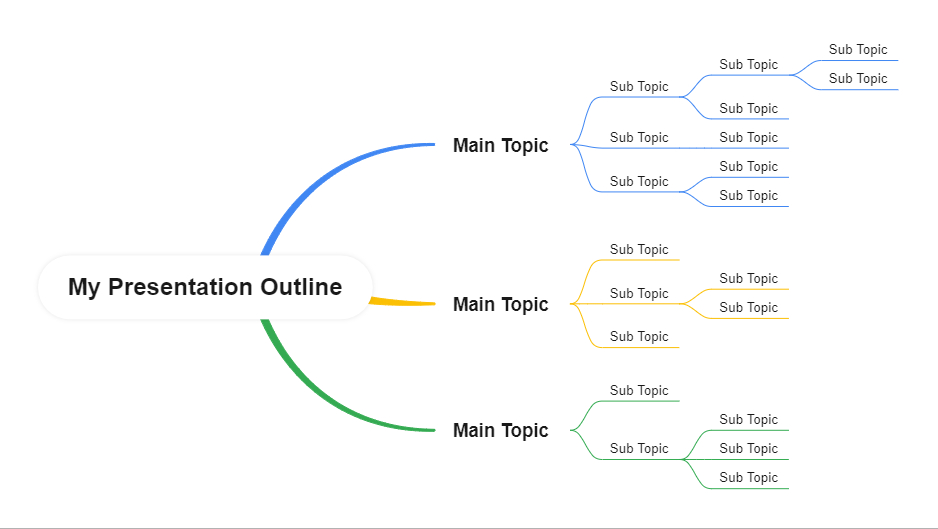
5. Presentation Outline Template
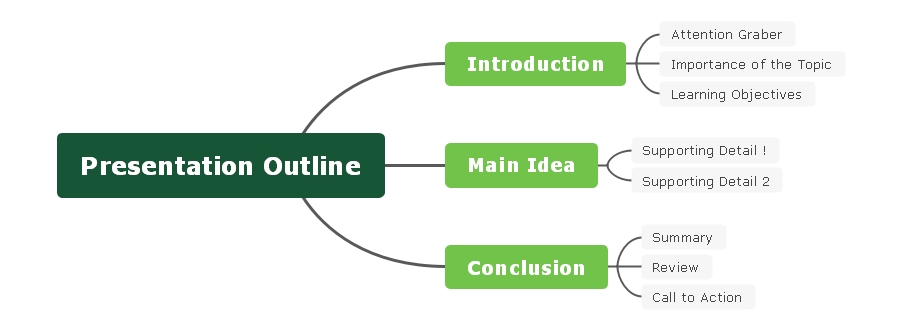
This presentation outline template describes three components of the outline: The introduction, the main body, and the conclusion. The introductory part opens the topic with an attention grabber and summarises the importance of the topic and its relevance of the topic to the audience. It also includes learning objectives that points out what the audience is going to learn from this presentation. The main body part constitutes the main idea of the topic. This idea is substantiated by supporting material. The concluding part constitutes a summary of the topic discussed and what the audience learned from it. It reviews the main points and calls the audience to take appropriate action.
6. Key Tips for Creating a More Effective Presentation
Here are some important points to consider to create an effective presentation:
- Know Your Audience. Get to know your audience by researching ahead of time so that you can make your presentation relatable.
- Add Quotes, Testimonials, or Data. Adding additional information to your presentation can help you engage your audience better.
- Visualize Your Ideas. The way you present your ideas is fundamental to the success of those ideas. EdrawMind helps you to create and present your ideas most effectively and efficiently.
- Identify Key Takeaways from Your Presentation. It will enable you to recall, review, and reassert what you want to communicate with your audience.
- Gather Feedback. Gathering honest feedback will help you make further improvements and adjustments to your presentation to make it more effective.
7. Key Takeaways
A presentation outline is a tool to communicate your ideas precisely. It helps you brainstorm and plan your presentation in a logical flow. Moreover, it helps to grab the attention of your audience by providing it with a visual depiction of what you are going to talk. If you want to create an impressive and creative presentation outline, EdrawMind will help you in this regard. It has a variety of functions and tools which enable you to create a dynamic outline suited to your topic. It enables you to brainstorm and present your ideas most effectively by using different diagrams, charts, graphs, clipart, etc. EdrawMind provides the best solution to your presentation problems.
You May Also Like
How to make a concept map.
HOW-TO & TIPS
How Do Humans Affect the Earth? Effective Ways to Save the Earth from Pollution
7 best earth day activities to enjoy | how to draw their mind map, get inspired: how to run a successful brainstorming session and boost your business, innovative solutions: learn how to brainstorm like a pro, how to make a creative mind map (with mind map templates).
Presentation Outline Example and Template
How to create a presentation Outline
A presentation outline is a roadmap to a more successful business pitch — a general plan that summarizes what you want to say to prospective customers, clients or investors. It lets you organize your thoughts, group ideas into main points and present your material logically. But what should you include in your slides?
We've compiled 11 tips for more effective pitch prep.
If you came here looking for presentation templates , here's an a couople of examples from of our most popular ones. If not, just carry on.

Browse our PRESENTATION TEMPLATES
What is a presentation outline.
An outline for a presentation is a helpful tool that organizes the main points and flow of the presentation. It acts as a guide for the presenter, outlining the order in which information will be presented and the main ideas that will be covered. A good outline should include headings and subheadings that outline the main topics and supporting details, ensuring a clear and logical arrangement of information. Creating a presentation outline helps the presenter stay organized and focused, and makes it easier for the audience to follow the content and understand the main concepts of the presentation.
11 tips to create more effective presentations
1. decide on a goal.

Before you brainstorm, and before you scribble down any notes, come up with a goal for your presentation. What do you want your pitch deck to say to your audience? What message do you want to convey? What do you want it to achieve?
Perhaps you want your pitch to raise seed funds. Maybe you want to introduce a new product or service to customers. Whatever the reason for creating your pitch, decide on a specific, measurable goal. This will guide the rest of your preparation.
2. Create a Structure for Your Presentation
Every good presentation includes an introduction, main body, and conclusion. These three components form the "skeleton" of your presentation — the bare bones of your pitch. You don't need to think about all the small details at this stage — you can flesh out your presentation slides at a later date.
Your introduction is probably the most important part of your pitch. After all, you only have seven seconds to make a good first impression, according to research. Use your intro to introduce your brand, greet your audience and give a taster of what's to come.
The body of your presentation includes your main ideas and any supporting ideas. Use it to feature testimonials, financials and fundraising info, traction and milestones, and, of course, your marketing plan.
Finally, your conclusion summarizes all your points in a few slides. This should leave your audience wanting more.
3. Think About Visual Content

Visual content is an essential ingredient. The human brain processes visuals 60,000 times faster than regular text, so including images in your pitch is a great idea. Don't forget about videos, either. Consumers are 64 percent more likely to purchase a product after watching an online video, making visual content a good choice if you want to generate leads and boost sign-ups.
The most successful pitch decks incorporate striking visuals. Others have fancy fonts and graphics. All of this visual content demands attention from your audience and creates a cool aesthetic that will help you outrank your rivals.
At this early stage of pitch deck preparation, you don't have to finalize the images you are going to include in your pitch. However, we think it's a good idea to point out where you are going to use images in your presentation. This way, you can organize your ideas and make sure everything flows properly.
4. Understand What Makes a Good Presentation — and a Bad One
No two presentations are the same. The most successful pitch decks, however, certainly have a lot in common. When creating your outline, discover what makes a brilliant pitch. The University of Hawaii says great presentations rarely cover more than five points. The University of Cambridge in England says there should be four key points in every 45-minute presentation.
Here at Slidebean, we think one idea per slide, good design, lots of images, and quotes all make presentations so much more interesting. We're not fans of the 'thank you' slide, though — the one that recognizes your audience for sitting through your presentation. It's completely unnecessary.
5. Include a Call-to-Action
A call-to-action is much better than a 'thank you' slide. This encourages your audience to take action after your presentation. When creating your outline, think of a short, snappy call-to-action that prompts a response. A call-to-action is your final chance to engage with your audience during your presentation. You might want to encourage people to sign up to your mailing list, for example. Alternatively, you can include a link to your website so people can download a trial version of your product.
"No matter what form your CTA takes, the most important aspect is the copy," says growth marketing expert Sujan Patel and Voila Norbert co-founder, writing for Forbes magazine . "You’re telling the visitor what you want them to do, so it needs to be persuasive. Remember, your audience is looking for an answer or a solution to a problem. Connect with them by telling them exactly what they’re going to get if they take action."
6. Identify a Solution to a Problem
Every day, more than 30 million presentations are created on PowerPoint alone. Then there are the hundreds of thousands of pitches designed in Keynote, Prezi, and Slidebean. With so many presentations out there, how do you inspire people to invest in your services? One way to create a successful pitch is to identify a solution to a problem that your audience might have.
Slidebean recently reviewed some of the best presentation examples from successful startups. Most of them provide solutions to common problems early on in their respective pitches. Customer messaging platform Intercom, for example, says analytics, customer base browsing, and customer research is the answer for businesses who find it hard to engage with customers. They include these solutions near the beginning of their pitch deck.
If you want to have a more successful presentation, think about solving problems in your niche when creating your outline.
7. Use Quotes, Testimonials and Statistics

Quotes from senior management help you convey abstract ideas and make your presentation more engaging. You should obtain any quotes you want to use in your presentation during the planning stage. Testimonials from customers and clients also prove popular. Research shows that positive reviews influence purchasing decisions and increase trust.
Finally, statistics add some depth to your presentation. Industry facts and figures back up any claims you make and increase engagement. Discover relevant statistics when creating your outline. You don't need to include any actual quotes, testimonials or statistics yet. Just jot down where you want to place them in your presentation.
8. Think About Color and Design
The way you present information in your pitch is just as important as the information itself. Now is the time to start thinking about the font/s you want to use or the color of your slides. Research shows that red conveys passion and excitement and catches the attention of your audience. White, on the other hand, conveys simplicity and purity.
Slidebean has a range of color palettes that transform the look of your slides. You can choose up to three color sets and play around with different text, backgrounds, and highlights.
9. Plan the Order of Your Slides
Think of your presentation outline template as a very rough first draft. Decide on what types of slides you want to use, and decide on a final running order. You might feature quotes early on in your presentation, for example, and leave testimonials until the end. Don't forget to include a slide with your contact details — website, phone number, address, etc. — and your brand values.
Your presentation outline should be a group effort, too. Ask your colleagues for input.
10. Identify Key Takeaways From Your Presentation
Your outline should include enough information so you can visualize what your final presentation will look like. Once you have finished your outline, read it back and identify the key takeaways from the document. Is the structure of your presentation clear, for example? Does it convey your brand message? Will it engage your audience?
Every slide in your presentation should achieve the goal you created at the beginning of your outline. If something isn't working, make changes. You might want to switch slides around or remove unnecessary information, for example.
11. Use a Presentation Template
Once you have completed your outline, it's time to start putting everything together. Yes, you could create a PowerPoint pitch deck from scratch, but this is often time-consuming and complicated. Instead, use a template, which provides you with all the presentation slides you need.
Here at Slidebean, we have presentation templates for business of all sizes, including startups and scaleups. You can create a professional pitch deck in just a few minutes by following the on-screen prompts. Everything's included — bullet points, graphics, headers, footers, and more. Take the time to plan your pitch to produce a powerful sales document that helps you communicate with your audience.
Once you have created your presentation outline template, sign up to Slidebean and design a pitch that provides you with a huge return on your investment.
Try Slidebean Templates
Popular articles.
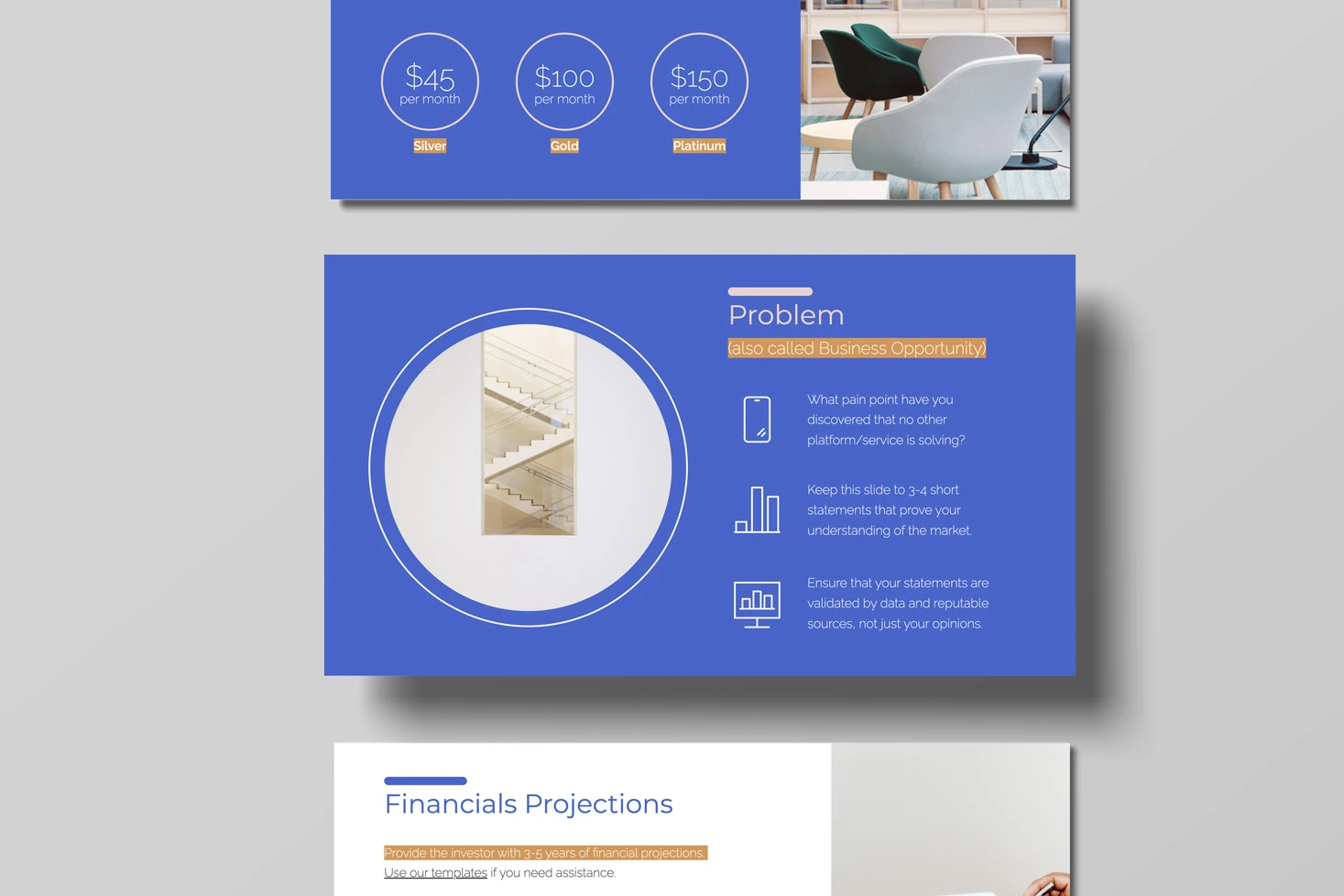
Pitch Deck Structure: What Investors Want To See

AirBnb Pitch Deck: Teardown and Redesign (FREE Download)
Upcoming events, financial modeling crash course.

Slidebean Helped USports Tackle A Complex Financial Model

Let’s move your company to the next stage 🚀
Ai pitch deck software, pitch deck services.

Financial Model Consulting for Startups 🚀

Raise money with our pitch deck writing and design service 🚀

The all-in-one pitch deck software 🚀
A pitch deck is the standard document used by startups to present their case to investors; it’s a brief deck of about 10 to 20 slides. See examples here.

Learn how to create a compelling slide deck for your startup. Explore how to use slide decks as aids for your presentation, and the most common uses for them.

This is a functional model you can use to create your own formulas and project your potential business growth. Instructions on how to use it are on the front page.

Book a call with our sales team
In a hurry? Give us a call at
- SUGGESTED TOPICS
- The Magazine
- Newsletters
- Managing Yourself
- Managing Teams
- Work-life Balance
- The Big Idea
- Data & Visuals
- Reading Lists
- Case Selections
- HBR Learning
- Topic Feeds
- Account Settings
- Email Preferences
What It Takes to Give a Great Presentation
- Carmine Gallo

Five tips to set yourself apart.
Never underestimate the power of great communication. It can help you land the job of your dreams, attract investors to back your idea, or elevate your stature within your organization. But while there are plenty of good speakers in the world, you can set yourself apart out by being the person who can deliver something great over and over. Here are a few tips for business professionals who want to move from being good speakers to great ones: be concise (the fewer words, the better); never use bullet points (photos and images paired together are more memorable); don’t underestimate the power of your voice (raise and lower it for emphasis); give your audience something extra (unexpected moments will grab their attention); rehearse (the best speakers are the best because they practice — a lot).
I was sitting across the table from a Silicon Valley CEO who had pioneered a technology that touches many of our lives — the flash memory that stores data on smartphones, digital cameras, and computers. He was a frequent guest on CNBC and had been delivering business presentations for at least 20 years before we met. And yet, the CEO wanted to sharpen his public speaking skills.
- Carmine Gallo is a Harvard University instructor, keynote speaker, and author of 10 books translated into 40 languages. Gallo is the author of The Bezos Blueprint: Communication Secrets of the World’s Greatest Salesman (St. Martin’s Press).
Partner Center

Improve your practice.
Enhance your soft skills with a range of award-winning courses.
How to Structure your Presentation, with Examples
August 3, 2018 - Dom Barnard
For many people the thought of delivering a presentation is a daunting task and brings about a great deal of nerves . However, if you take some time to understand how effective presentations are structured and then apply this structure to your own presentation, you’ll appear much more confident and relaxed.
Here is our complete guide for structuring your presentation, with examples at the end of the article to demonstrate these points.
Why is structuring a presentation so important?
If you’ve ever sat through a great presentation, you’ll have left feeling either inspired or informed on a given topic. This isn’t because the speaker was the most knowledgeable or motivating person in the world. Instead, it’s because they know how to structure presentations – they have crafted their message in a logical and simple way that has allowed the audience can keep up with them and take away key messages.
Research has supported this, with studies showing that audiences retain structured information 40% more accurately than unstructured information.
In fact, not only is structuring a presentation important for the benefit of the audience’s understanding, it’s also important for you as the speaker. A good structure helps you remain calm, stay on topic, and avoid any awkward silences.
What will affect your presentation structure?
Generally speaking, there is a natural flow that any decent presentation will follow which we will go into shortly. However, you should be aware that all presentation structures will be different in their own unique way and this will be due to a number of factors, including:
- Whether you need to deliver any demonstrations
- How knowledgeable the audience already is on the given subject
- How much interaction you want from the audience
- Any time constraints there are for your talk
- What setting you are in
- Your ability to use any kinds of visual assistance
Before choosing the presentation’s structure answer these questions first:
- What is your presentation’s aim?
- Who are the audience?
- What are the main points your audience should remember afterwards?
When reading the points below, think critically about what things may cause your presentation structure to be slightly different. You can add in certain elements and add more focus to certain moments if that works better for your speech.

What is the typical presentation structure?
This is the usual flow of a presentation, which covers all the vital sections and is a good starting point for yours. It allows your audience to easily follow along and sets out a solid structure you can add your content to.
1. Greet the audience and introduce yourself
Before you start delivering your talk, introduce yourself to the audience and clarify who you are and your relevant expertise. This does not need to be long or incredibly detailed, but will help build an immediate relationship between you and the audience. It gives you the chance to briefly clarify your expertise and why you are worth listening to. This will help establish your ethos so the audience will trust you more and think you’re credible.
Read our tips on How to Start a Presentation Effectively
2. Introduction
In the introduction you need to explain the subject and purpose of your presentation whilst gaining the audience’s interest and confidence. It’s sometimes helpful to think of your introduction as funnel-shaped to help filter down your topic:
- Introduce your general topic
- Explain your topic area
- State the issues/challenges in this area you will be exploring
- State your presentation’s purpose – this is the basis of your presentation so ensure that you provide a statement explaining how the topic will be treated, for example, “I will argue that…” or maybe you will “compare”, “analyse”, “evaluate”, “describe” etc.
- Provide a statement of what you’re hoping the outcome of the presentation will be, for example, “I’m hoping this will be provide you with…”
- Show a preview of the organisation of your presentation
In this section also explain:
- The length of the talk.
- Signal whether you want audience interaction – some presenters prefer the audience to ask questions throughout whereas others allocate a specific section for this.
- If it applies, inform the audience whether to take notes or whether you will be providing handouts.
The way you structure your introduction can depend on the amount of time you have been given to present: a sales pitch may consist of a quick presentation so you may begin with your conclusion and then provide the evidence. Conversely, a speaker presenting their idea for change in the world would be better suited to start with the evidence and then conclude what this means for the audience.
Keep in mind that the main aim of the introduction is to grab the audience’s attention and connect with them.
3. The main body of your talk
The main body of your talk needs to meet the promises you made in the introduction. Depending on the nature of your presentation, clearly segment the different topics you will be discussing, and then work your way through them one at a time – it’s important for everything to be organised logically for the audience to fully understand. There are many different ways to organise your main points, such as, by priority, theme, chronologically etc.
- Main points should be addressed one by one with supporting evidence and examples.
- Before moving on to the next point you should provide a mini-summary.
- Links should be clearly stated between ideas and you must make it clear when you’re moving onto the next point.
- Allow time for people to take relevant notes and stick to the topics you have prepared beforehand rather than straying too far off topic.
When planning your presentation write a list of main points you want to make and ask yourself “What I am telling the audience? What should they understand from this?” refining your answers this way will help you produce clear messages.
4. Conclusion
In presentations the conclusion is frequently underdeveloped and lacks purpose which is a shame as it’s the best place to reinforce your messages. Typically, your presentation has a specific goal – that could be to convert a number of the audience members into customers, lead to a certain number of enquiries to make people knowledgeable on specific key points, or to motivate them towards a shared goal.
Regardless of what that goal is, be sure to summarise your main points and their implications. This clarifies the overall purpose of your talk and reinforces your reason for being there.
Follow these steps:
- Signal that it’s nearly the end of your presentation, for example, “As we wrap up/as we wind down the talk…”
- Restate the topic and purpose of your presentation – “In this speech I wanted to compare…”
- Summarise the main points, including their implications and conclusions
- Indicate what is next/a call to action/a thought-provoking takeaway
- Move on to the last section
5. Thank the audience and invite questions
Conclude your talk by thanking the audience for their time and invite them to ask any questions they may have. As mentioned earlier, personal circumstances will affect the structure of your presentation.
Many presenters prefer to make the Q&A session the key part of their talk and try to speed through the main body of the presentation. This is totally fine, but it is still best to focus on delivering some sort of initial presentation to set the tone and topics for discussion in the Q&A.

Other common presentation structures
The above was a description of a basic presentation, here are some more specific presentation layouts:
Demonstration
Use the demonstration structure when you have something useful to show. This is usually used when you want to show how a product works. Steve Jobs frequently used this technique in his presentations.
- Explain why the product is valuable.
- Describe why the product is necessary.
- Explain what problems it can solve for the audience.
- Demonstrate the product to support what you’ve been saying.
- Make suggestions of other things it can do to make the audience curious.
Problem-solution
This structure is particularly useful in persuading the audience.
- Briefly frame the issue.
- Go into the issue in detail showing why it ‘s such a problem. Use logos and pathos for this – the logical and emotional appeals.
- Provide the solution and explain why this would also help the audience.
- Call to action – something you want the audience to do which is straightforward and pertinent to the solution.
Storytelling
As well as incorporating stories in your presentation , you can organise your whole presentation as a story. There are lots of different type of story structures you can use – a popular choice is the monomyth – the hero’s journey. In a monomyth, a hero goes on a difficult journey or takes on a challenge – they move from the familiar into the unknown. After facing obstacles and ultimately succeeding the hero returns home, transformed and with newfound wisdom.
Storytelling for Business Success webinar , where well-know storyteller Javier Bernad shares strategies for crafting compelling narratives.
Another popular choice for using a story to structure your presentation is in media ras (in the middle of thing). In this type of story you launch right into the action by providing a snippet/teaser of what’s happening and then you start explaining the events that led to that event. This is engaging because you’re starting your story at the most exciting part which will make the audience curious – they’ll want to know how you got there.
- Great storytelling: Examples from Alibaba Founder, Jack Ma
Remaining method
The remaining method structure is good for situations where you’re presenting your perspective on a controversial topic which has split people’s opinions.
- Go into the issue in detail showing why it’s such a problem – use logos and pathos.
- Rebut your opponents’ solutions – explain why their solutions could be useful because the audience will see this as fair and will therefore think you’re trustworthy, and then explain why you think these solutions are not valid.
- After you’ve presented all the alternatives provide your solution, the remaining solution. This is very persuasive because it looks like the winning idea, especially with the audience believing that you’re fair and trustworthy.
Transitions
When delivering presentations it’s important for your words and ideas to flow so your audience can understand how everything links together and why it’s all relevant. This can be done using speech transitions which are words and phrases that allow you to smoothly move from one point to another so that your speech flows and your presentation is unified.
Transitions can be one word, a phrase or a full sentence – there are many different forms, here are some examples:
Moving from the introduction to the first point
Signify to the audience that you will now begin discussing the first main point:
- Now that you’re aware of the overview, let’s begin with…
- First, let’s begin with…
- I will first cover…
- My first point covers…
- To get started, let’s look at…
Shifting between similar points
Move from one point to a similar one:
- In the same way…
- Likewise…
- Equally…
- This is similar to…
- Similarly…
Internal summaries
Internal summarising consists of summarising before moving on to the next point. You must inform the audience:
- What part of the presentation you covered – “In the first part of this speech we’ve covered…”
- What the key points were – “Precisely how…”
- How this links in with the overall presentation – “So that’s the context…”
- What you’re moving on to – “Now I’d like to move on to the second part of presentation which looks at…”
Physical movement
You can move your body and your standing location when you transition to another point. The audience find it easier to follow your presentation and movement will increase their interest.
A common technique for incorporating movement into your presentation is to:
- Start your introduction by standing in the centre of the stage.
- For your first point you stand on the left side of the stage.
- You discuss your second point from the centre again.
- You stand on the right side of the stage for your third point.
- The conclusion occurs in the centre.
Key slides for your presentation
Slides are a useful tool for most presentations: they can greatly assist in the delivery of your message and help the audience follow along with what you are saying. Key slides include:
- An intro slide outlining your ideas
- A summary slide with core points to remember
- High quality image slides to supplement what you are saying
There are some presenters who choose not to use slides at all, though this is more of a rarity. Slides can be a powerful tool if used properly, but the problem is that many fail to do just that. Here are some golden rules to follow when using slides in a presentation:
- Don’t over fill them – your slides are there to assist your speech, rather than be the focal point. They should have as little information as possible, to avoid distracting people from your talk.
- A picture says a thousand words – instead of filling a slide with text, instead, focus on one or two images or diagrams to help support and explain the point you are discussing at that time.
- Make them readable – depending on the size of your audience, some may not be able to see small text or images, so make everything large enough to fill the space.
- Don’t rush through slides – give the audience enough time to digest each slide.
Guy Kawasaki, an entrepreneur and author, suggests that slideshows should follow a 10-20-30 rule :
- There should be a maximum of 10 slides – people rarely remember more than one concept afterwards so there’s no point overwhelming them with unnecessary information.
- The presentation should last no longer than 20 minutes as this will leave time for questions and discussion.
- The font size should be a minimum of 30pt because the audience reads faster than you talk so less information on the slides means that there is less chance of the audience being distracted.
Here are some additional resources for slide design:
- 7 design tips for effective, beautiful PowerPoint presentations
- 11 design tips for beautiful presentations
- 10 tips on how to make slides that communicate your idea
Group Presentations
Group presentations are structured in the same way as presentations with one speaker but usually require more rehearsal and practices. Clean transitioning between speakers is very important in producing a presentation that flows well. One way of doing this consists of:
- Briefly recap on what you covered in your section: “So that was a brief introduction on what health anxiety is and how it can affect somebody”
- Introduce the next speaker in the team and explain what they will discuss: “Now Elnaz will talk about the prevalence of health anxiety.”
- Then end by looking at the next speaker, gesturing towards them and saying their name: “Elnaz”.
- The next speaker should acknowledge this with a quick: “Thank you Joe.”
From this example you can see how the different sections of the presentations link which makes it easier for the audience to follow and remain engaged.
Example of great presentation structure and delivery
Having examples of great presentations will help inspire your own structures, here are a few such examples, each unique and inspiring in their own way.
How Google Works – by Eric Schmidt
This presentation by ex-Google CEO Eric Schmidt demonstrates some of the most important lessons he and his team have learnt with regards to working with some of the most talented individuals they hired. The simplistic yet cohesive style of all of the slides is something to be appreciated. They are relatively straightforward, yet add power and clarity to the narrative of the presentation.
Start with why – by Simon Sinek
Since being released in 2009, this presentation has been viewed almost four million times all around the world. The message itself is very powerful, however, it’s not an idea that hasn’t been heard before. What makes this presentation so powerful is the simple message he is getting across, and the straightforward and understandable manner in which he delivers it. Also note that he doesn’t use any slides, just a whiteboard where he creates a simple diagram of his opinion.
The Wisdom of a Third Grade Dropout – by Rick Rigsby
Here’s an example of a presentation given by a relatively unknown individual looking to inspire the next generation of graduates. Rick’s presentation is unique in many ways compared to the two above. Notably, he uses no visual prompts and includes a great deal of humour.
However, what is similar is the structure he uses. He first introduces his message that the wisest man he knew was a third-grade dropout. He then proceeds to deliver his main body of argument, and in the end, concludes with his message. This powerful speech keeps the viewer engaged throughout, through a mixture of heart-warming sentiment, powerful life advice and engaging humour.
As you can see from the examples above, and as it has been expressed throughout, a great presentation structure means analysing the core message of your presentation. Decide on a key message you want to impart the audience with, and then craft an engaging way of delivering it.
By preparing a solid structure, and practising your talk beforehand, you can walk into the presentation with confidence and deliver a meaningful message to an interested audience.
It’s important for a presentation to be well-structured so it can have the most impact on your audience. An unstructured presentation can be difficult to follow and even frustrating to listen to. The heart of your speech are your main points supported by evidence and your transitions should assist the movement between points and clarify how everything is linked.
Research suggests that the audience remember the first and last things you say so your introduction and conclusion are vital for reinforcing your points. Essentially, ensure you spend the time structuring your presentation and addressing all of the sections.
We use essential cookies to make Venngage work. By clicking “Accept All Cookies”, you agree to the storing of cookies on your device to enhance site navigation, analyze site usage, and assist in our marketing efforts.
Manage Cookies
Cookies and similar technologies collect certain information about how you’re using our website. Some of them are essential, and without them you wouldn’t be able to use Venngage. But others are optional, and you get to choose whether we use them or not.
Strictly Necessary Cookies
These cookies are always on, as they’re essential for making Venngage work, and making it safe. Without these cookies, services you’ve asked for can’t be provided.
Show cookie providers
- Google Login
Functionality Cookies
These cookies help us provide enhanced functionality and personalisation, and remember your settings. They may be set by us or by third party providers.
Performance Cookies
These cookies help us analyze how many people are using Venngage, where they come from and how they're using it. If you opt out of these cookies, we can’t get feedback to make Venngage better for you and all our users.
- Google Analytics
Targeting Cookies
These cookies are set by our advertising partners to track your activity and show you relevant Venngage ads on other sites as you browse the internet.
- Google Tag Manager
- Infographics
- Daily Infographics
- Popular Templates
- Accessibility
- Graphic Design
- Graphs and Charts
- Data Visualization
- Human Resources
- Beginner Guides
Blog Data Visualization 18 Presentation Design Tips For Success
18 Presentation Design Tips For Success
Written by: Midori Nediger May 15, 2023

Bad presentations. We’ve all had to sit through them. Heck, we’ve probably all given one or two. I know I have.
You know the type: twice as long as they need to be, slides chock-full of text, no visuals in sight.
How can you ensure you don’t fall victim to these presentation faux-pas when designing your next presentation for your team, class, or clients?
In this blog, I’ll walk you through tips on how to design an impactful presentation along with presentation templates that can help you deliver it with style to leave a lasting impression.
Tips for designing and delivering an impactful presentation
What makes a presentation memorable?
It usually comes down to three things:
- The main idea.
- The presenter.
- The visuals.
All three elements work together to create a successful presentation. Just like how different presentation styles serve different purposes, having a good presentation idea will give the audience a purpose for listening.
Here are some top tips to consider to help you design and deliver an impactful presentation:
- Include less text and more visuals in your presentation design
- Identify one core message to center your presentation design around
- Eliminate any information that doesn’t immediately support the core message
- Create a strong presentation outline to keep you focused
- Use text to reinforce, not repeat, what you’re saying
- Design your presentation with one major takeaway per slide
- Use visuals to highlight the key message on each slide
- Use scaffolding slides to orient your audience and keep them engaged
- Use text size, weight, and color for emphasis
- Apply design choices consistently to avoid distraction
- Split a group presentation by topic
- Use a variety of page layouts to maintain your audience’s interest
- Use presentation templates to help you get started
- Include examples of inspiring people
- Dedicate slides to poignant questions
- Find quotes that will inspire your audience
- Emphasize key points with text and images
- Label your slides to prompt your memory
1. Include less text and more visuals in your presentation design
According to David Paradi’s annual presentation survey , the 3 things that annoy audiences most about presentations are:
- Speakers reading their slides
- Slides that include full sentences of text
- Text that is too small to read
The common thread that ties all of these presentation annoyances is text. Audiences are very picky about the text found in presentation slide decks .
In my experiences speaking at conferences and in webinars over the past few years, audiences respond much more positively to presentations that use visuals in place of text.
Audiences are more engaged, ask more questions, and find my talks more memorable when I include lots of visual examples in my slide decks.
I’m not the only one who has found this. We recently surveyed nearly 400 conference speakers about their presentation designs and found that 84.3% create presentations that are highly visual.
A great example of a high visual presentation is the iconic AirBnB pitch deck design , which includes no more than 40 words per slide. Instead of repeating the speaker’s script on the slides, it makes an impact with keywords, large numbers, and icons:

Learn how to customize this presentation template:
To help you take your presentations to the next level, I’d like to share my process for creating a visually-focused presentation like the one above. I’ll give you my top presentation design tips that I’ve learned over years of presenting:
- Class presentations
- Online courses
You can then apply this process to our professional presentation templates or pitch decks , creating unique presentation decks with ease! Our user-friendly editor tools make customizing these templates a breeze.
To leave a lasting impression on your audience, consider transforming your slides into an interactive presentation. Here are 15 interactive presentation ideas to enhance interactivity and engagement.
We’ll cover the most important steps for summarizing lengthy text into a presentation-friendly format. Then we’ll touch on some presentation design tips to help you get visual with your slide decks. Read on for the best creative presentation ideas .
2. Identify one core message to center your presentation design around
We know from David Paradi’s survey that audiences are easily overwhelmed with lots of text and data, especially when presentations are long.

(You when you see a presentation with lots of text and data and it’s long)
So unlike in a white paper , report , or essay , you can’t expect to tackle many complex ideas within a single presentation.
That would be a recipe for disaster.
Instead, identify a single central message that you would like to communicate to your audience. Then build your presentation around that core message.
By identifying that core message, you can ensure that everything you include in your presentation supports the goal of the presentation .
As seen below, a great presentation tells you exactly what you’re going to learn (the core message), then gets right to the facts (the supporting information).

To ensure you create an asset that’s clear, concise, impactful, and easy to follow, design your presentation around a single core message.
3. Create a strong presentation outline to keep you focused
Think of your outline as a roadmap for your presentation. Creating a strong presentation outline straight away helps make sure that you’re hitting all of the key points you need to cover to convey a persuasive presentation .
Take this presentation outline example:
- Introduction and hellos
- Vision and value proposition
- Financial profit
- Your investment
- Thanks and questions
These are all things that we know we need to talk about within the presentation.
Creating a presentation outline makes it much easier to know what to say when it comes to creating the actual presentation slides.
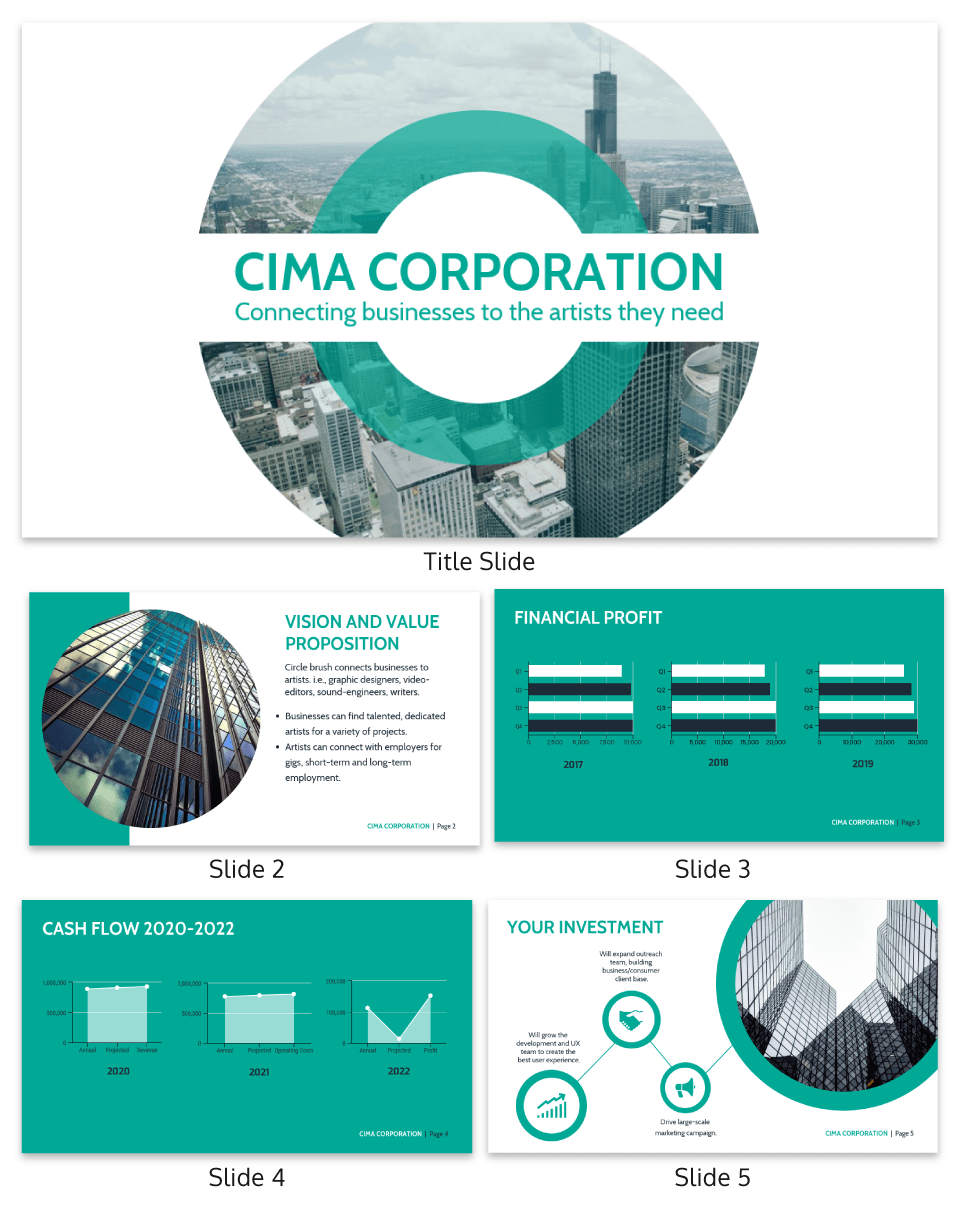
You could even include your presentation outline as a separate slide so that your audience knows what to expect:
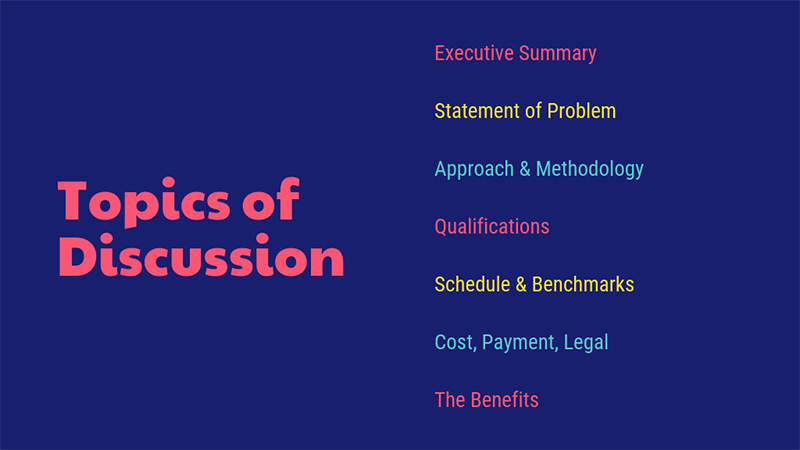
The opening moments of your presentation hold immense power – check out these 15 ways to start a presentation to set the stage and captivate your audience.
4. Eliminate any information that doesn’t support the core message
Next, use that core message to identify everything that doesn’t belong in the presentation.
Aim to eliminate everything that isn’t immediately relevant to the topic at hand, and anything remotely redundant. Cut any information that isn’t absolutely essential to understanding the core message.
By cutting these extra details, you can transform forgettable text-heavy slides:
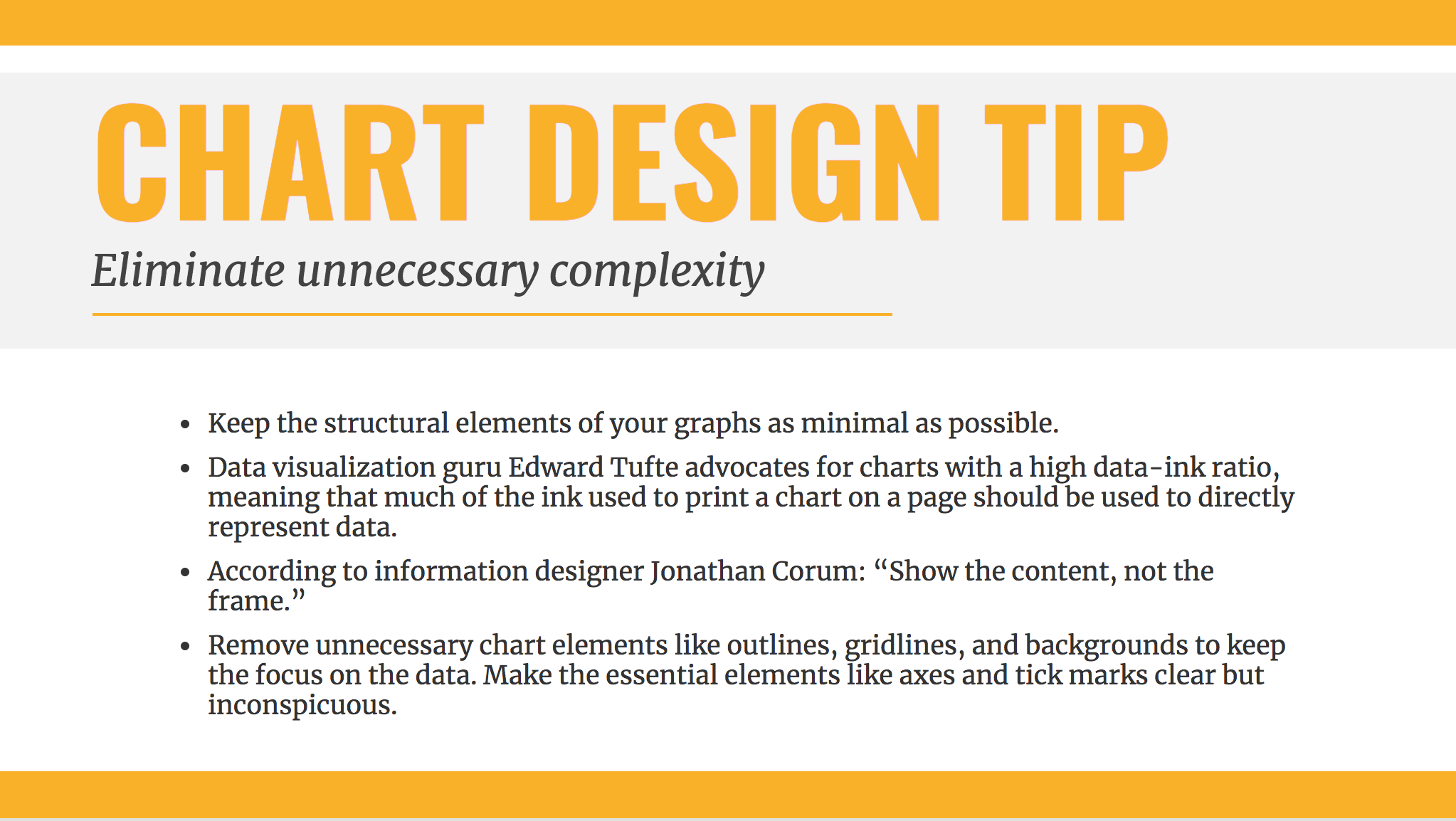
Into memorable slides with minimal text:
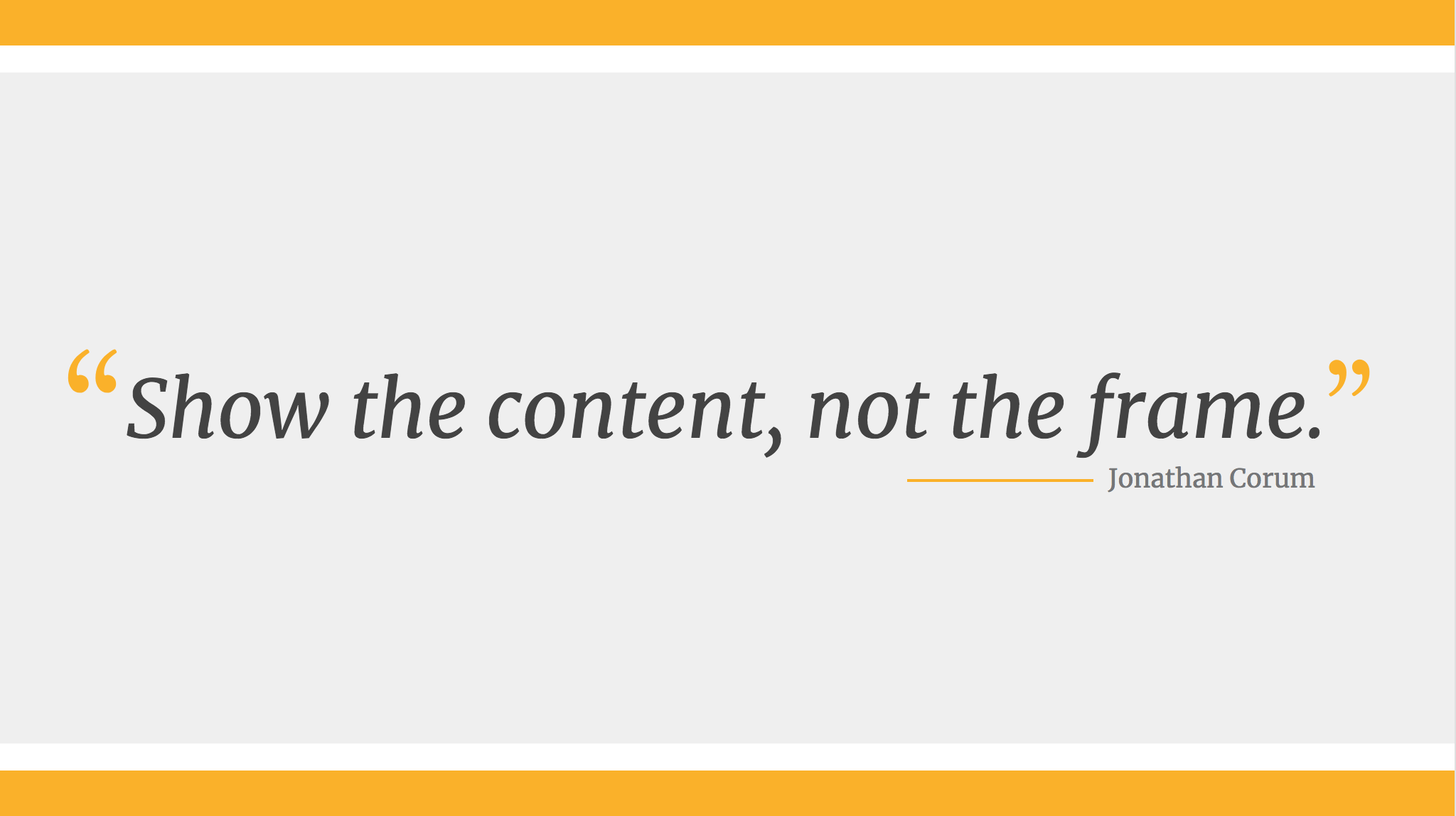
Here’s a quick checklist to help you cut out any extra detail:
Get rid of:
- Detailed descriptions
- Background information
- Redundant statements
- Explanations of common knowledge
- Persuasive facts and figures
- Illustrative examples
- Impactful quotes
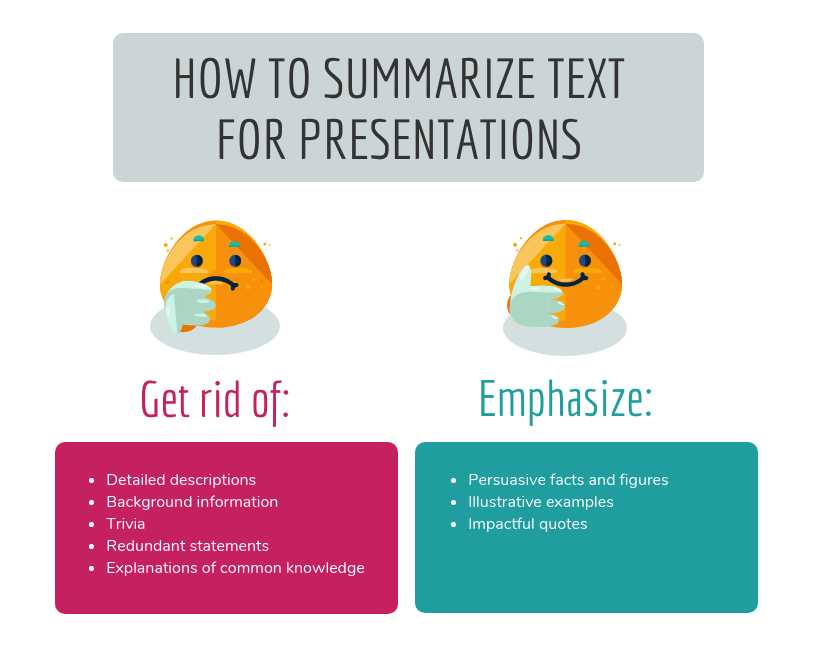
This step may seem obvious, but when you’re presenting on a topic that you’re passionate about, it’s easy to get carried away with extraneous detail. Use the recommendations above to keep your text in check.
Clarity is key, especially if you’re presenting virtually rather than in-person. However, Lisa Schneider (Chief Growth Officer at Merriam-Webster) has had plenty of experience making that adjustment. She recently shared her tips for adapting in-person presentations into virtual presentations on Venngage that you can check out.
Watch: How to design a presentation [10 ESSENTIAL TIPS]
5. Use text to reinforce, not repeat, what you’re saying
According to presentation guru Nancy Duarte , your audience should be able to discern the meaning of your slides in 6 seconds or less.
Since your audience will tend to read every word you place on each slide, you must keep your text to an absolute minimum. The text on your slides should provide support for what you’re saying without being distracting.
Never write out, word for word, what you’re going to be saying out loud. If you’re relying on text to remember certain points, resist the urge to cram them into your slides. Instead, use a tool like Venngage’s speaker notes to highlight particular talking points. These can be imported into PowerPoint — along with the rest of your presentation — and will only be viewable to you, not your audience.
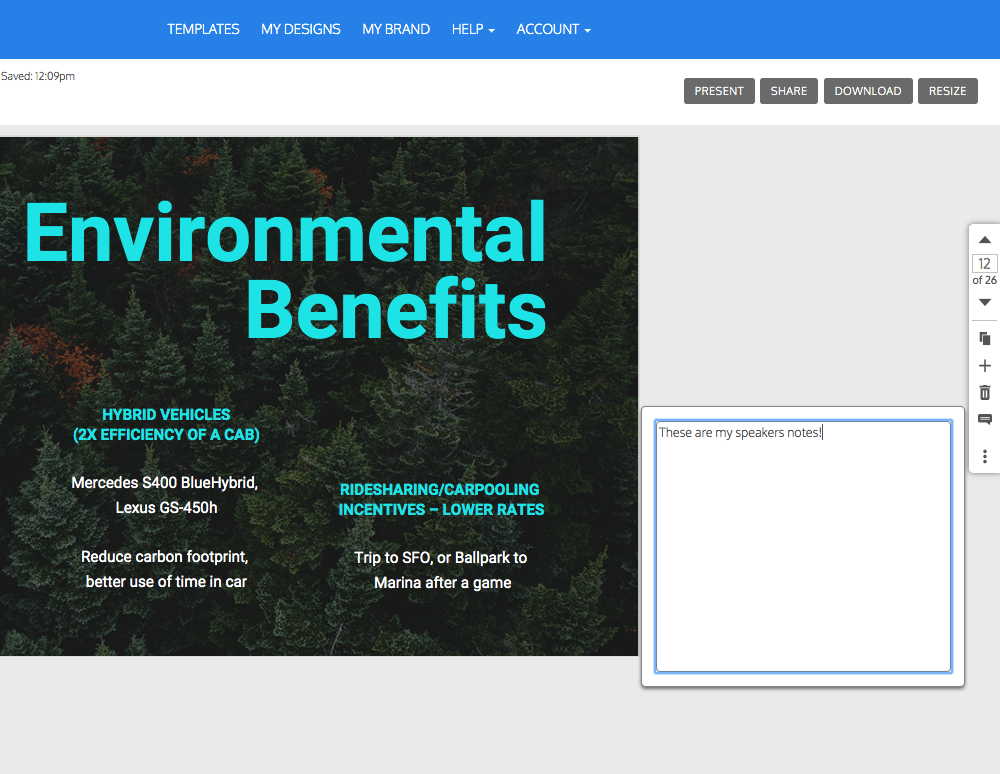
For the actual slides, text should only be used to reinforce what you’re saying. Like in the presentation design below, paraphrase long paragraphs into short bulleted lists or statements by eliminating adjectives and articles (like “the” and “a”).
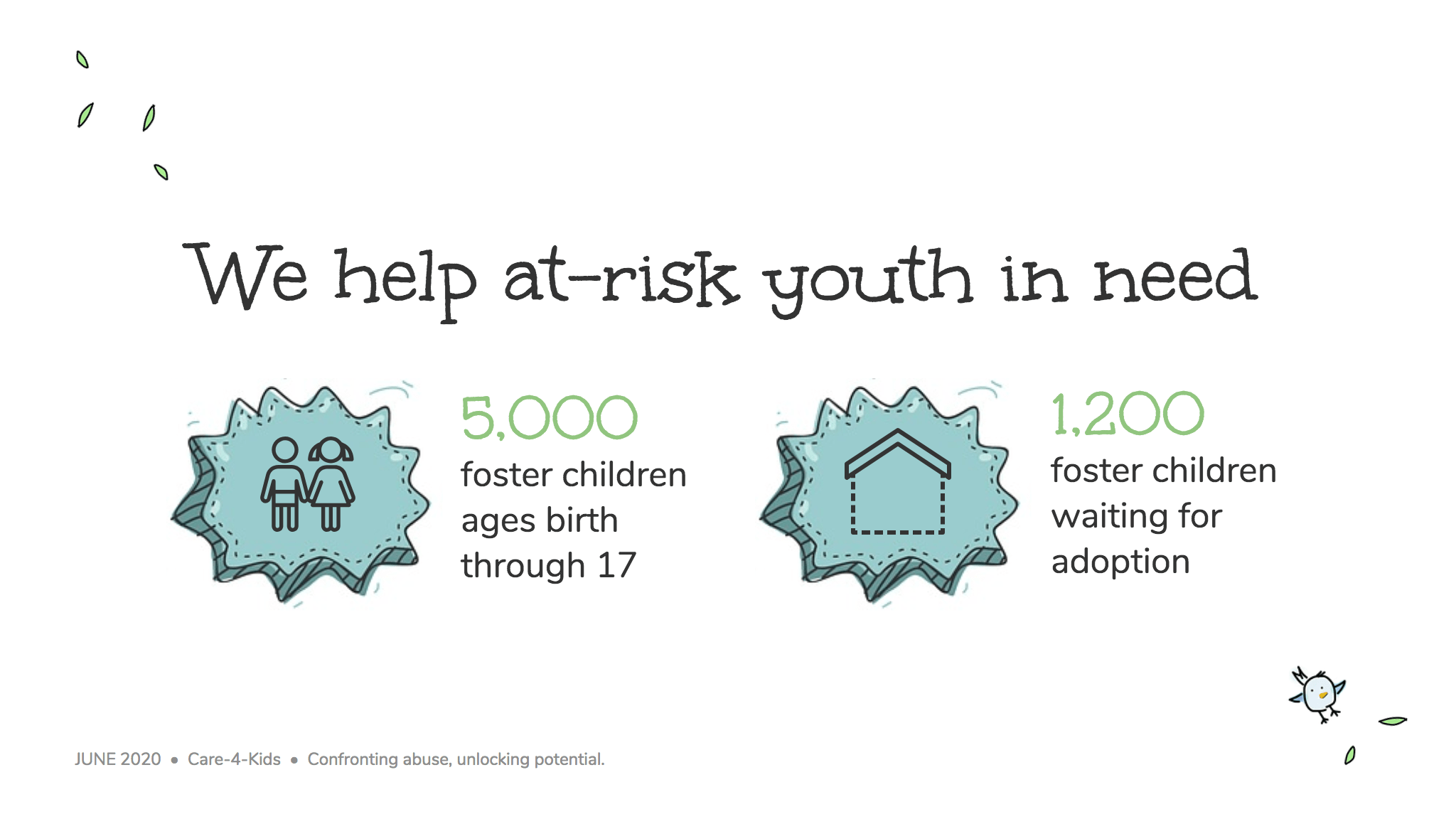
Pull out quotes and important numbers, and make them a focus of each slide.
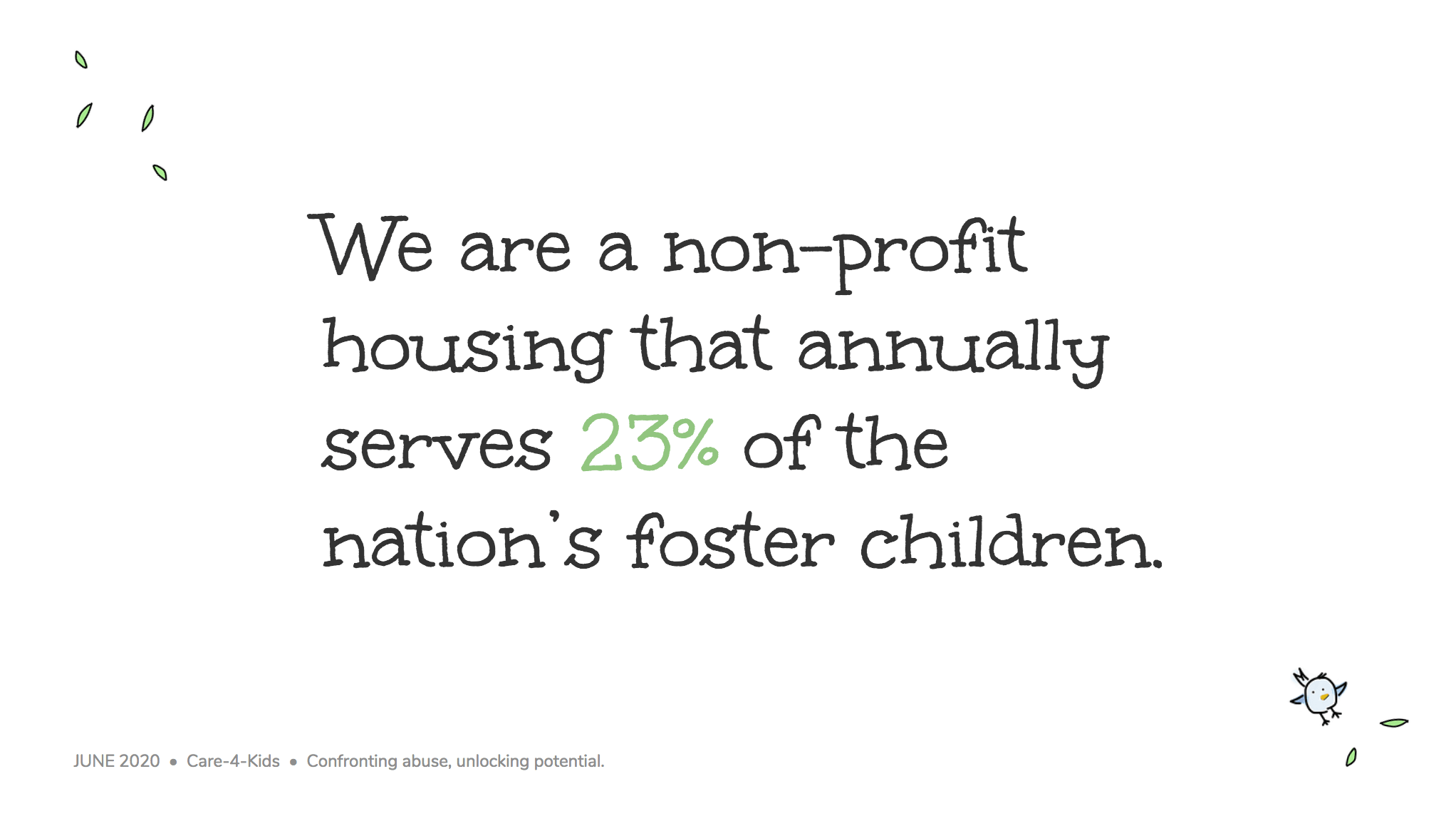
6. Design your presentation with one major takeaway per slide
As I mentioned above, audiences struggle when too much information is presented on a single slide.
To make sure you don’t overwhelm your audiences with too much information, spread out your content to cover one major takeaway per slide.
By limiting each slide to a single simple statement, you focus your audience’s attention on the topic at hand.
My favorite way to do this is to pick out the core message of whatever I’m talking about and express it in a few keywords, as seen in this presentation slide below.
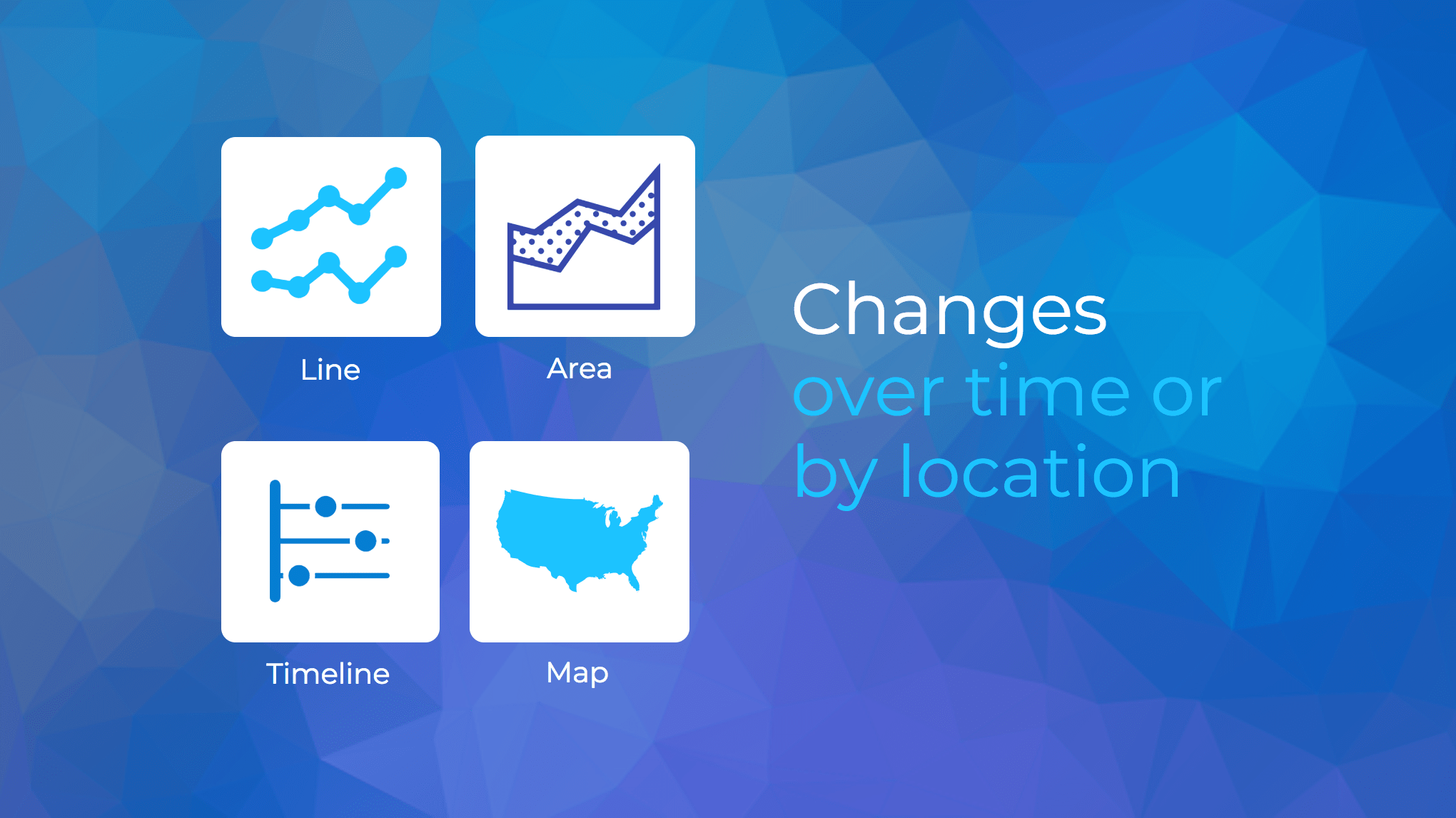
This helps ensure that the visuals remain the focus of the slide.
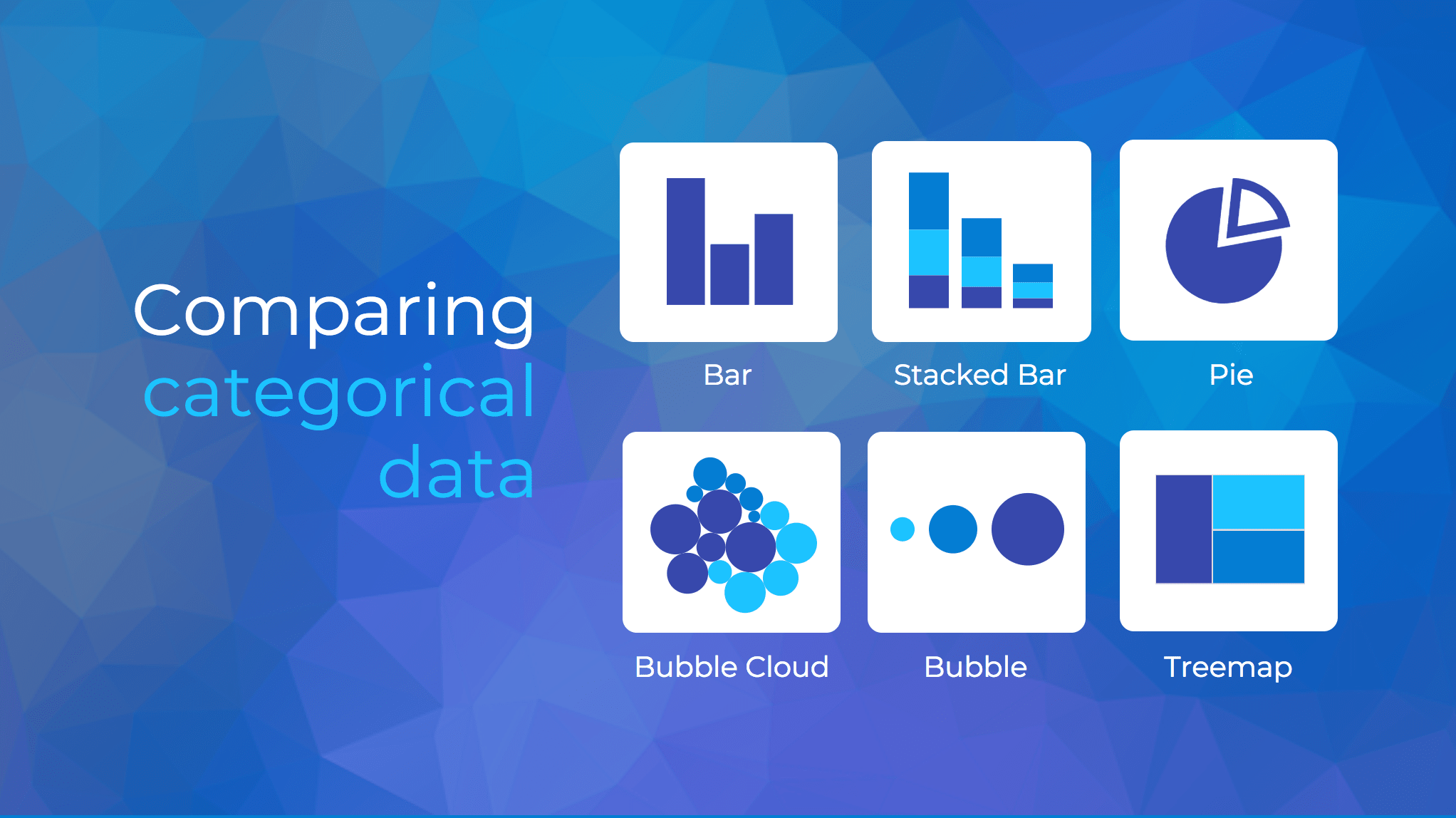
Using the text in this way, to simply state a single fact per slide, is a sure-fire way to make an impact in your presentation.
Alternatively, pull out a significant statistic that you want to stick in your audience’s minds and make it a visual focus of the slide, as seen in this popular presentation by Officevibe .
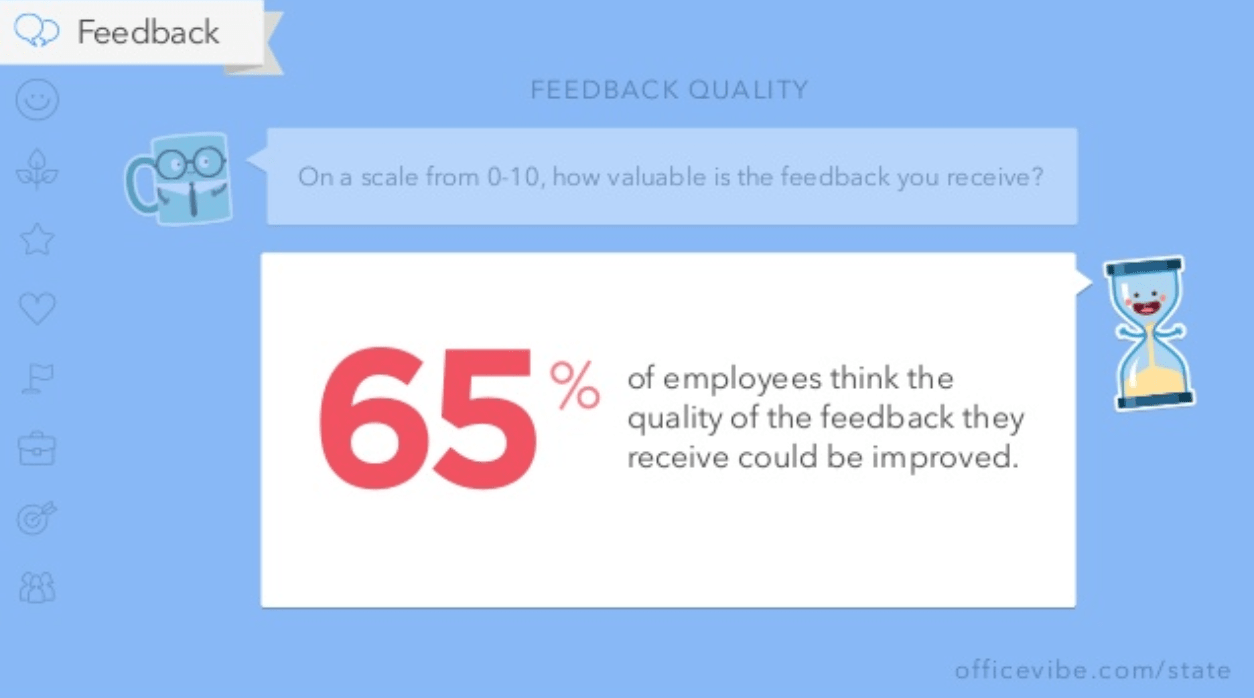
This might mean you end up with a slide deck with a ton of slides. But that’s totally ok!
I’ve talked to many professionals who are pressured by their management teams to create presentations with a specific number of slides (usually as few as 10 or 15 slides for a 30-minute presentation).
If you ask me, this approach is completely flawed. In my mind, the longer I spend sitting on a single slide, the more likely I am to lose the interest of my audience.
How many slides should I use for a 10 minute presentation?
A good rule of thumb is to have at least as many slides as minutes in your presentation. So for a 10 minute presentation you should have at least 10 slides .
Use as many slides as you need, as long as you are presenting a single message on each slide, (as seen in the lengthy presentation template below). This is especially important if you’re presenting your business, or delivering a product presentation. You want to wow your audience, not bore them.
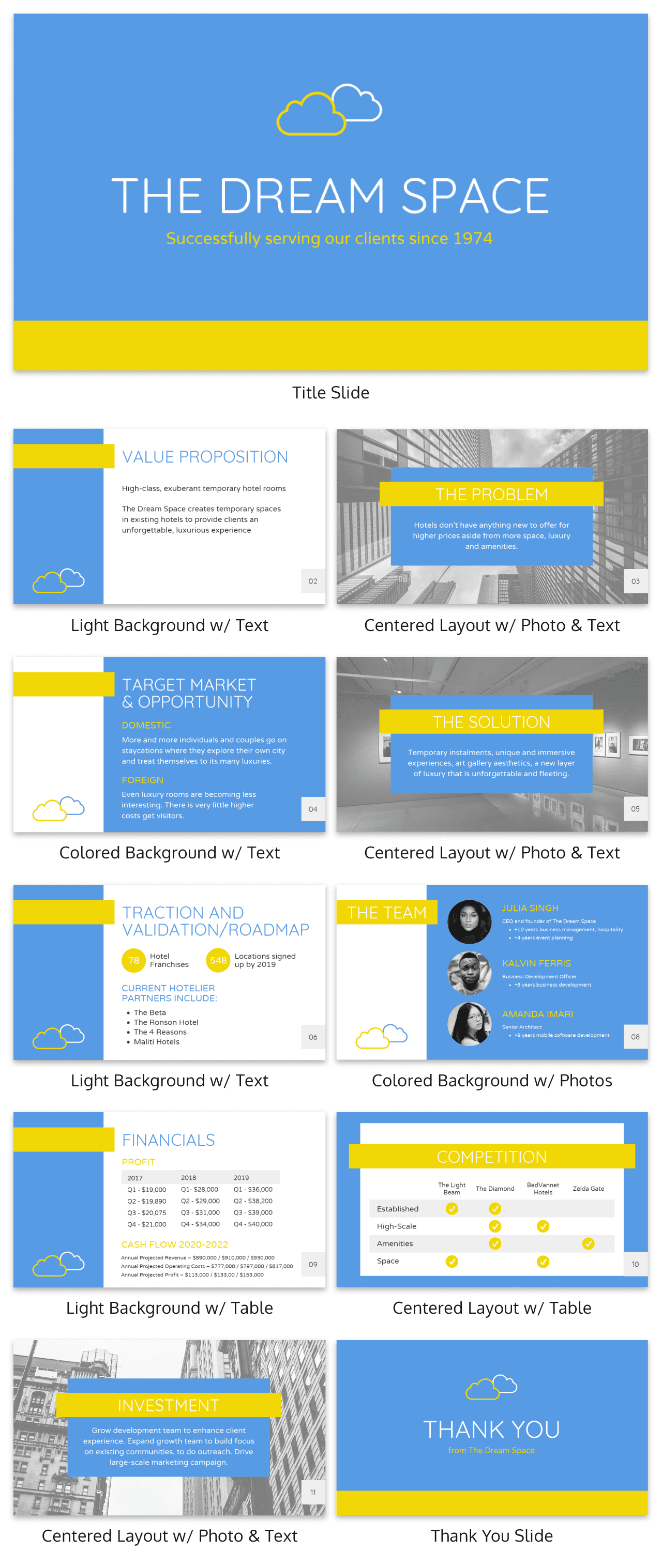
7. Use visuals to highlight the key message on each slide
As important as having one major takeaway per slide is having visuals that highlight the major takeaway on each slide.
Unique visuals will help make your message memorable.
Visuals are a great way to eliminate extra text, too.
You can add visuals by creating a timeline infographic to group and integrate information into visual frameworks like this:
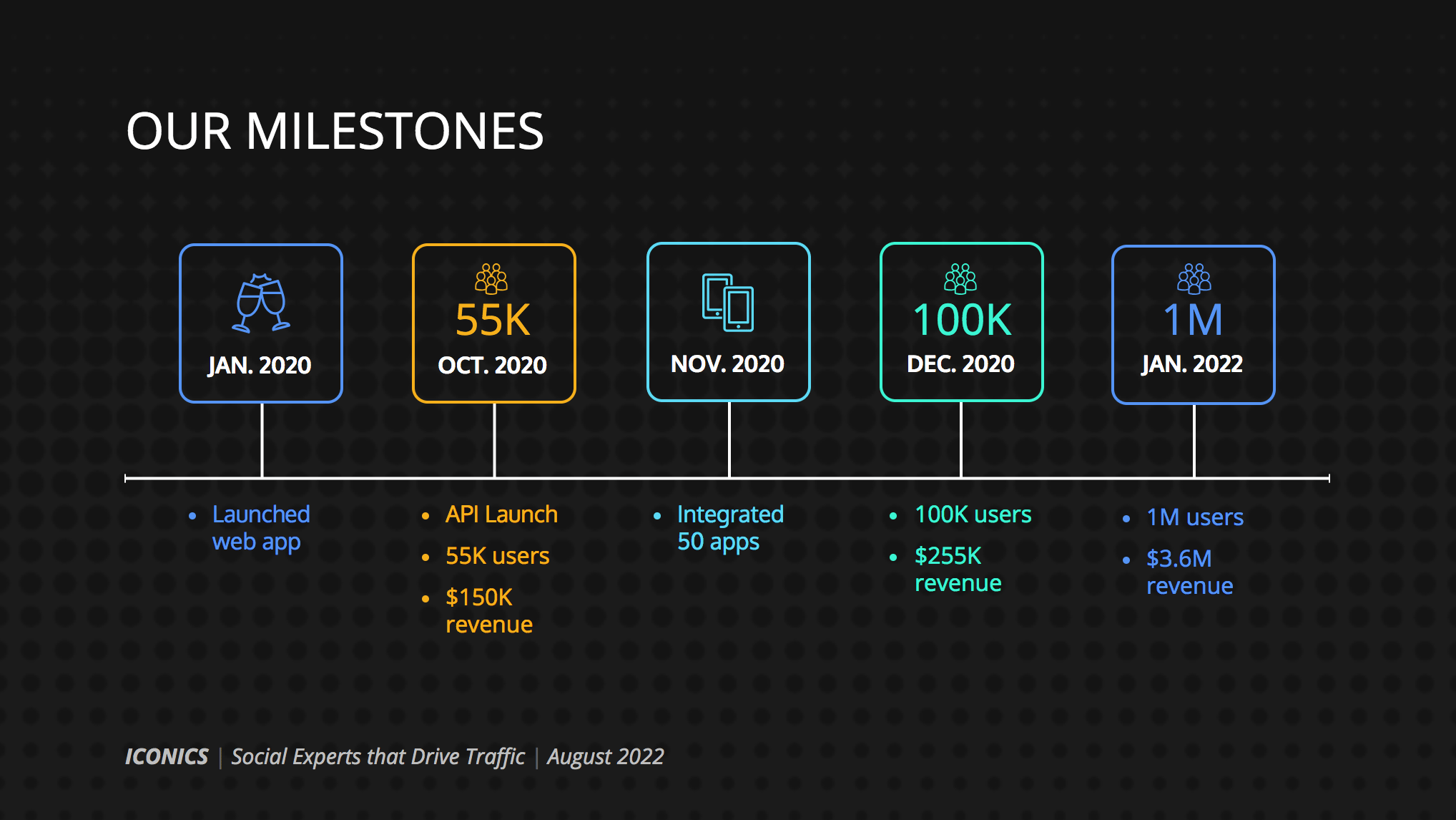
Or create a flowchart and funnels:
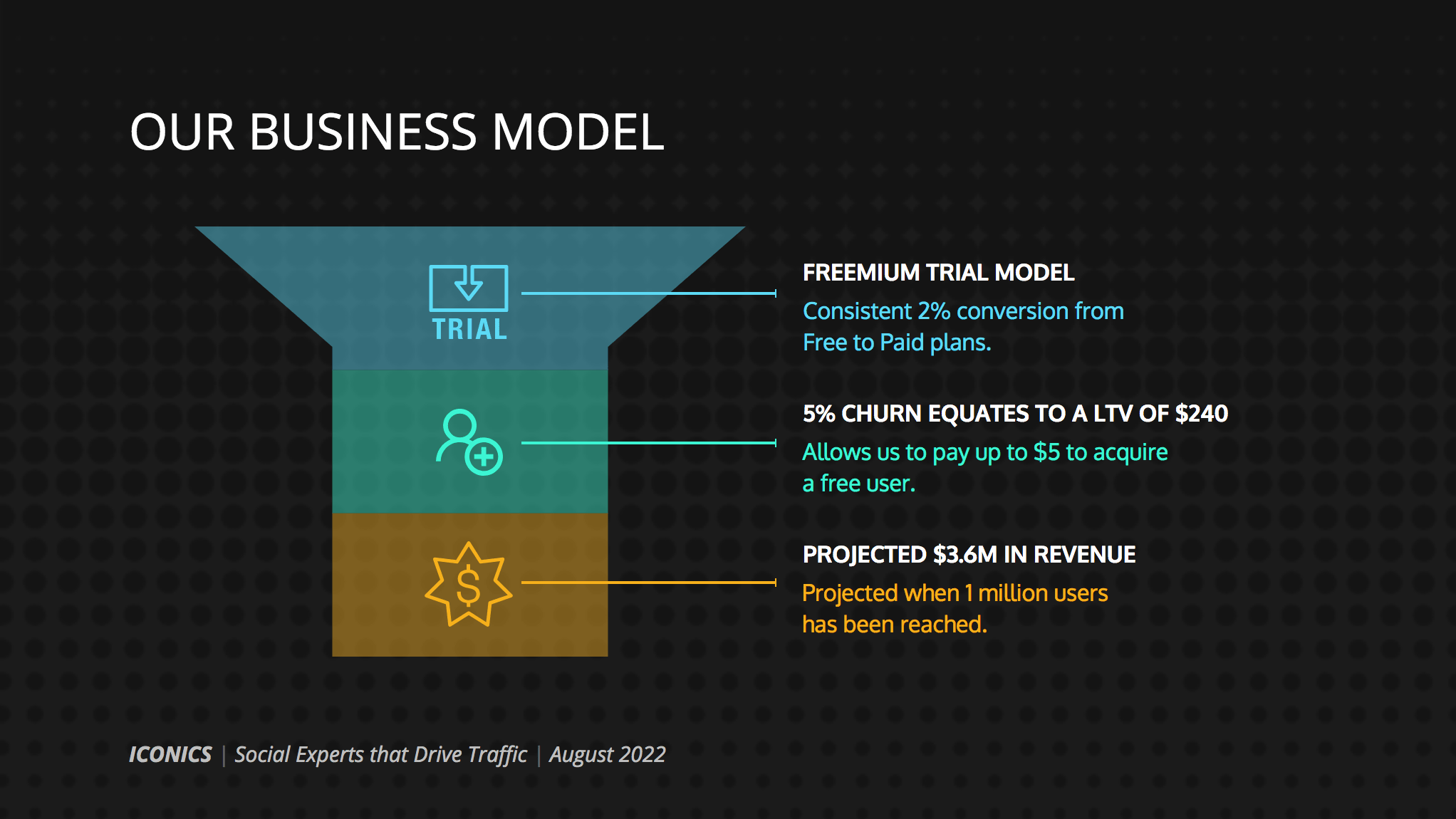
Or by representing simple concepts with icons, as seen in the modern presentation design below. Using the same color for every icon helps create a polished look.
Using visuals in this way is perfect for when you have to convey messages quickly to audiences that you aren’t familiar with – such as at conferences. This would also make the ideal interview presentation template.
You can alternatively use icons in different colors, like in the presentation templates below. Just make sure the colors are complimentary, and style is consistent throughout the presentation (i.e. don’t use sleek, modern icons on one slide and whimsically illustrated icons on another). In this example, presentation clipart style icons have been used.
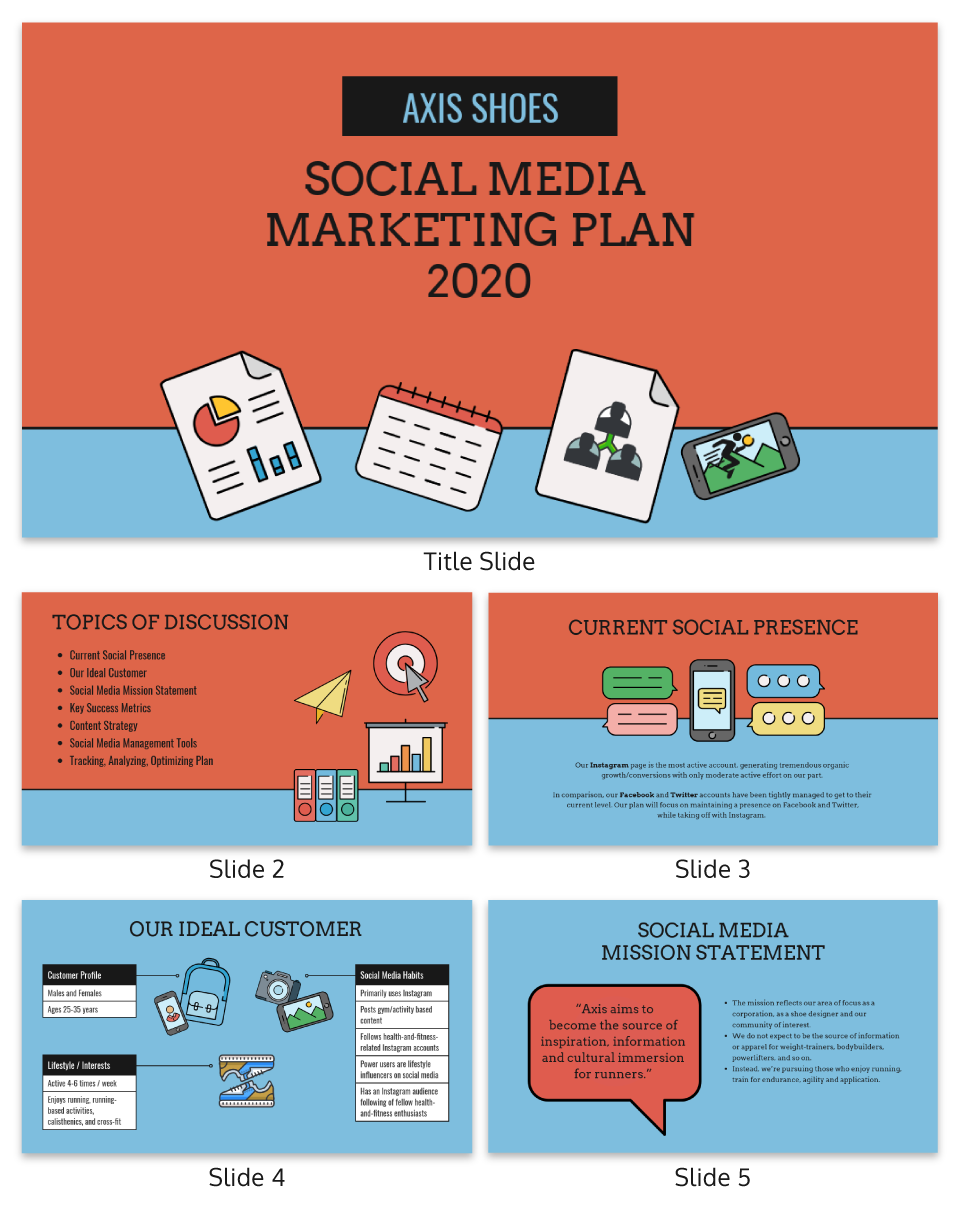
Any time you have important stats or trends you want your audience to remember, consider using a chart or data visualization to drive your point home. Confident public speaking combined with strong visualizations can really make an impact, encouraging your audience to act upon your message.
One of my personal favorite presentations (created by a professional designer) takes this “key message plus a visual” concept to the extreme, resulting in a slide deck that’s downright irresistible.
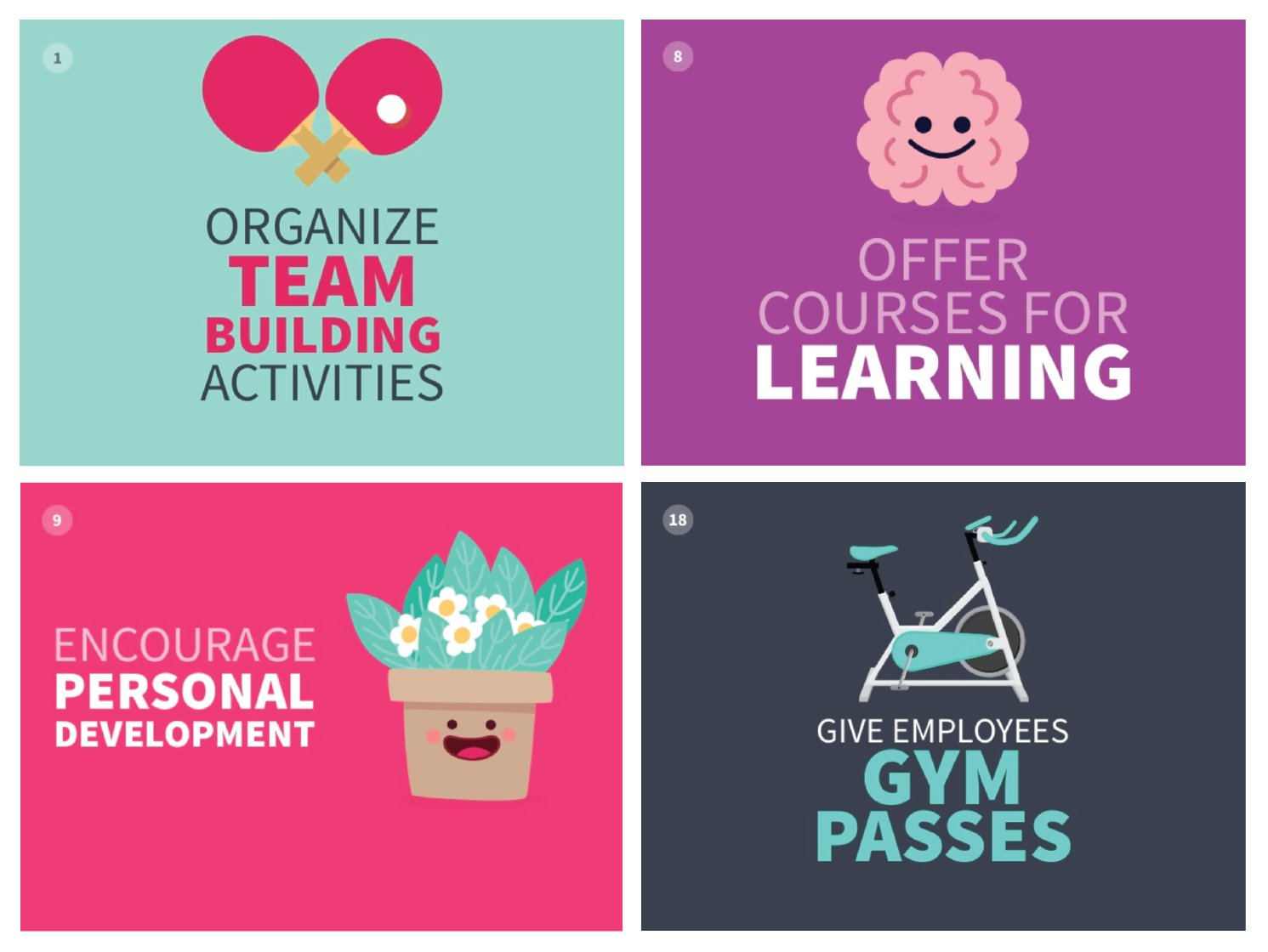
When applying this concept, don’t fall into the trap of using bad stock photos . Irrelevant or poorly chosen visuals can hurt you as much as they help you.
Below is an example of how to use stock photos effectively. They are more thematic than literal and are customized with fun, bright icons that set a playful tone.
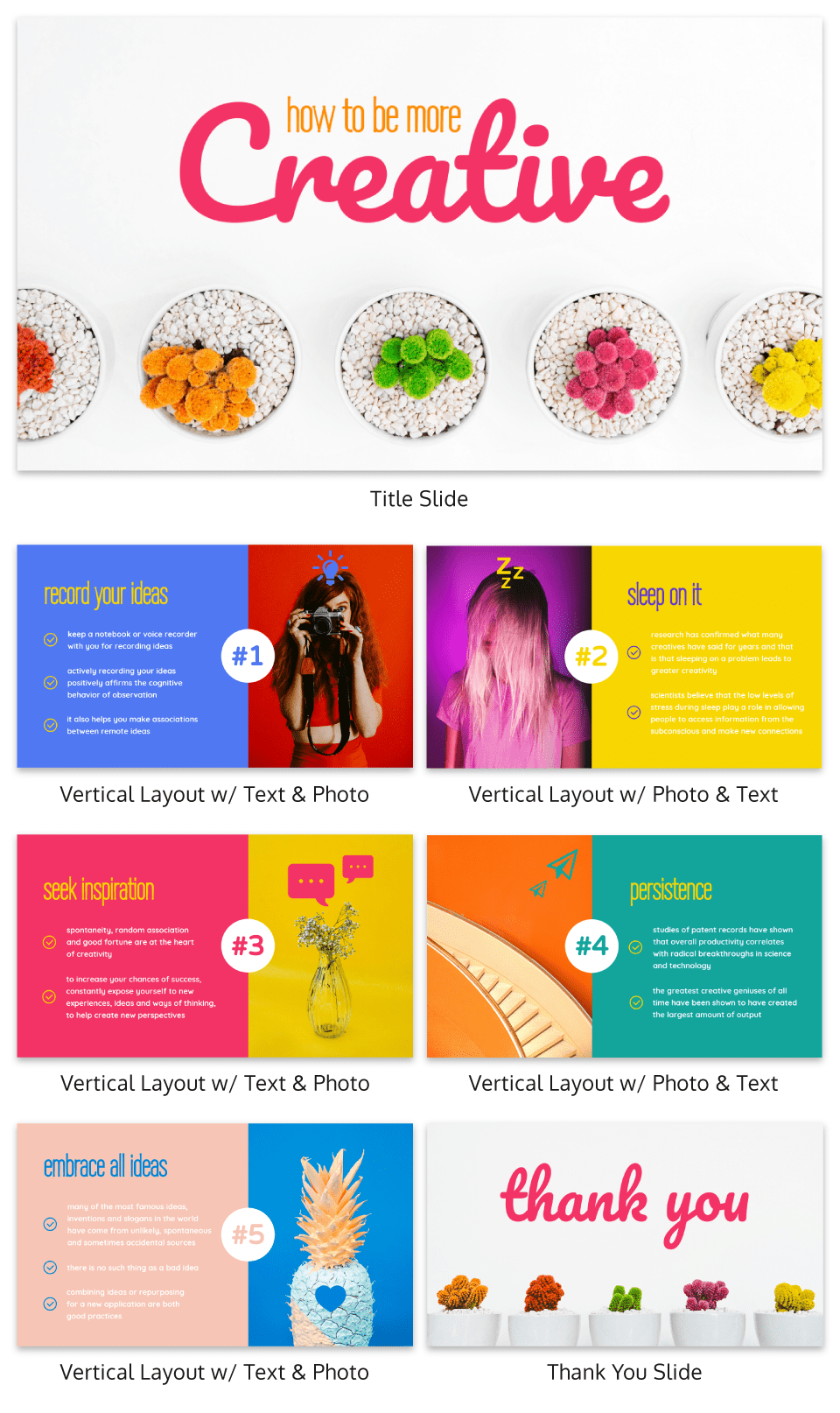
The content and visual design of a presentation should be seamless.
It should never seem like your text and visuals are plopped onto a template. The format and design of the slides should contribute to and support the audience’s understanding of the content.

8. Use scaffolding slides to orient your audience and keep them engaged
It’s easy for audiences to get lost during long presentations, especially if you have lots of slides. And audiences zone out when they get lost.
To help reorient your audience every once in a while, you can use something I like to call scaffolding slides. Scaffolding slides appear throughout a presentation to denote the start and end of major sections.
The core scaffolding slide is the agenda slide, which should appear right after the introduction or title slide. It outlines the major sections of the presentation.
At the beginning of each section, you should show that agenda again but highlight the relevant section title, as seen below.
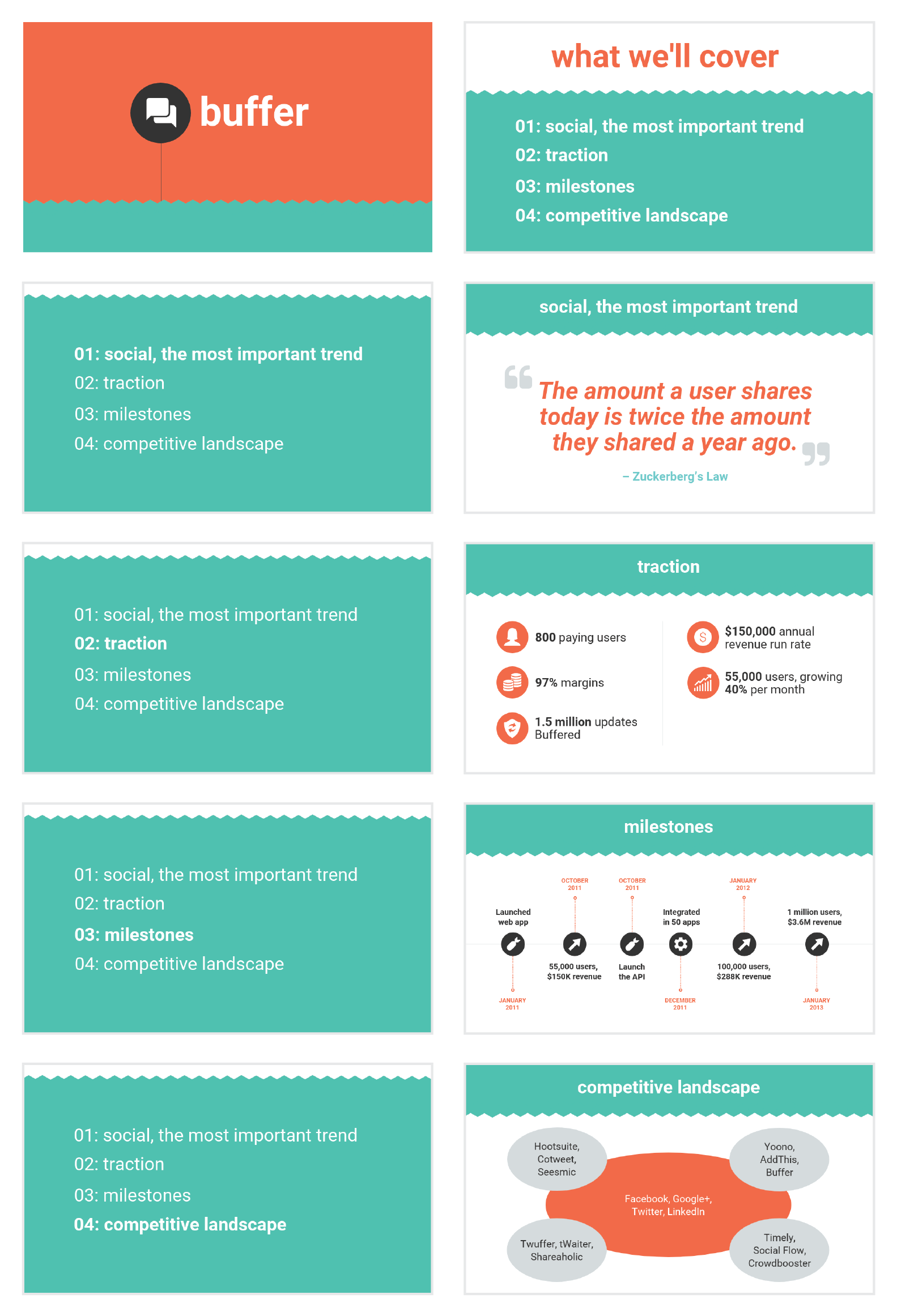
This gives audiences the sense that you’re making progress through the presentation and helps keep them anchored and engaged.
Alternatively, you can achieve a similar effect by numbering your sections and showing that number on every slide. Or use a progress bar at the bottom of each slide to indicate how far along you are in your presentation. Just make sure it doesn’t distract from the main content of the slides.

You can imagine using this “progress bar” idea for a research presentation, or any presentation where you have a lot of information to get through.
Leila Janah, founder of Sama Group, is great at this. Her Innovation and Inspire talk about Sama Group is an example of a presentation that is well organized and very easy to follow.
Her presentation follows a logical, steady stream of ideas. She seems comfortable talking in front of a crowd but doesn’t make any attempts to engage directly with them.
9. Use text size, weight and color for emphasis
Every slide should have a visual focal point. Something that immediately draws the eye at first glance.
That focal point should be whatever is most important on that slide, be it an important number, a keyword, or simply the slide title.
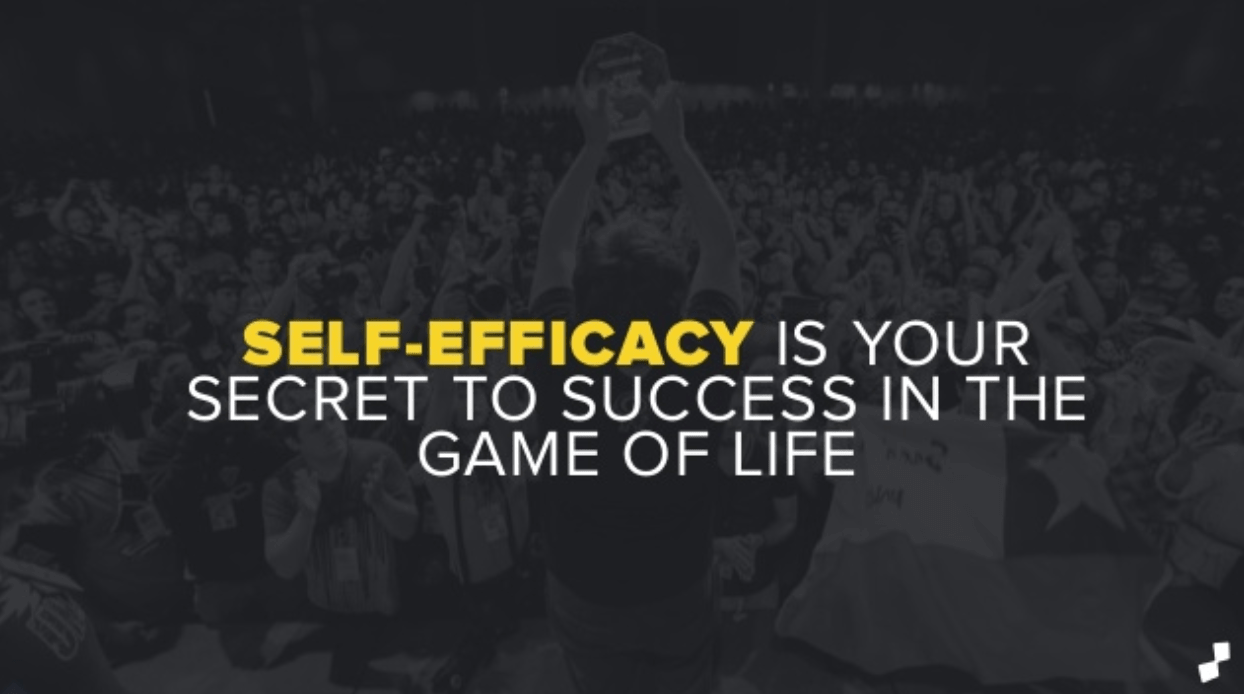
We can create visual focal points by varying the size, weight, and color of each element on the slide. Larger, brighter, bolder elements will command our audience’s attention, while smaller, lighter elements will tend to fade into the background.
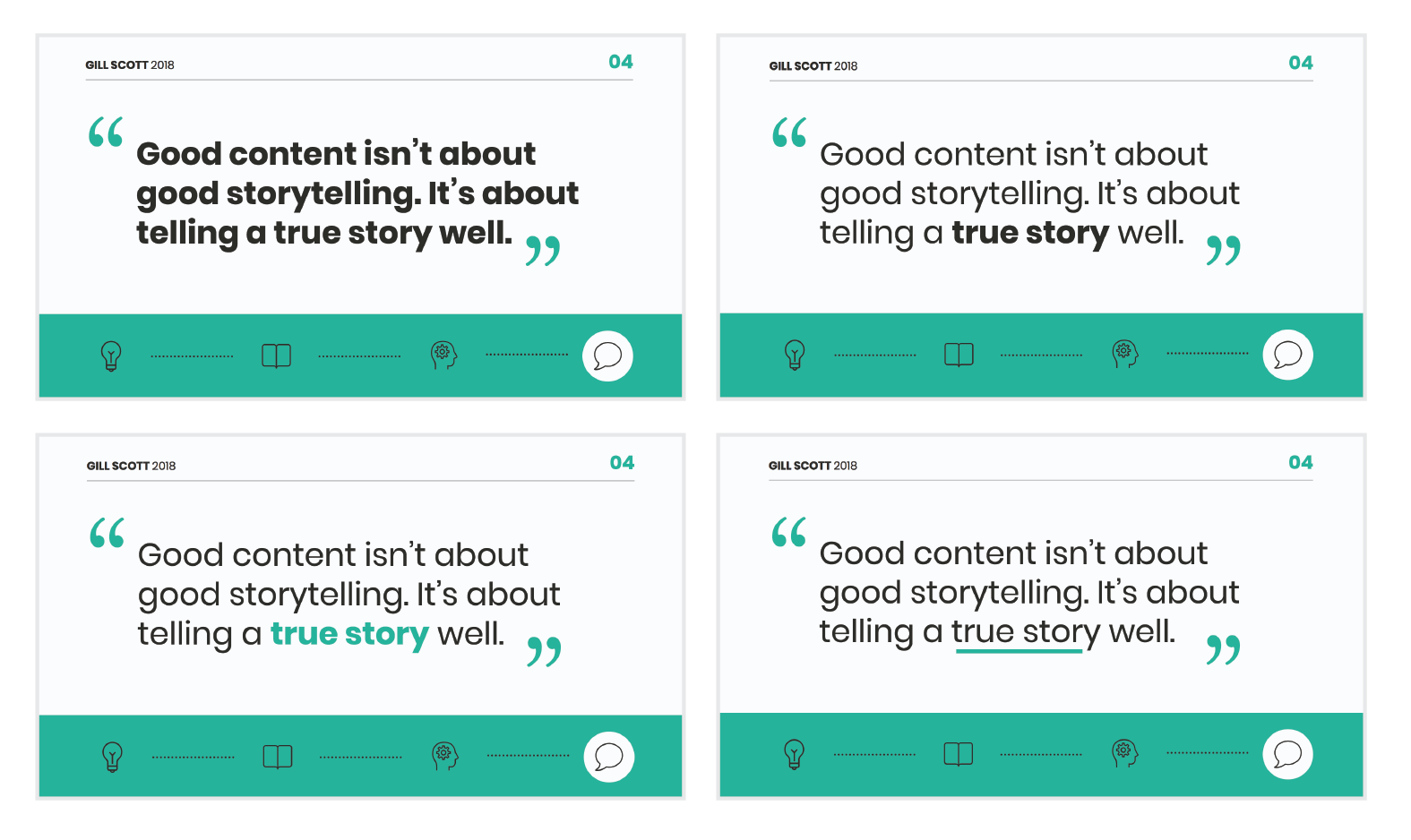
As seen in the presentation template above, this technique can be especially useful for drawing attention to important words within a long passage of text. Consider using this technique whenever you have more than 5 words on a slide.
And if you really want your audience to pay attention, pick a high-contrast color scheme like the one below.
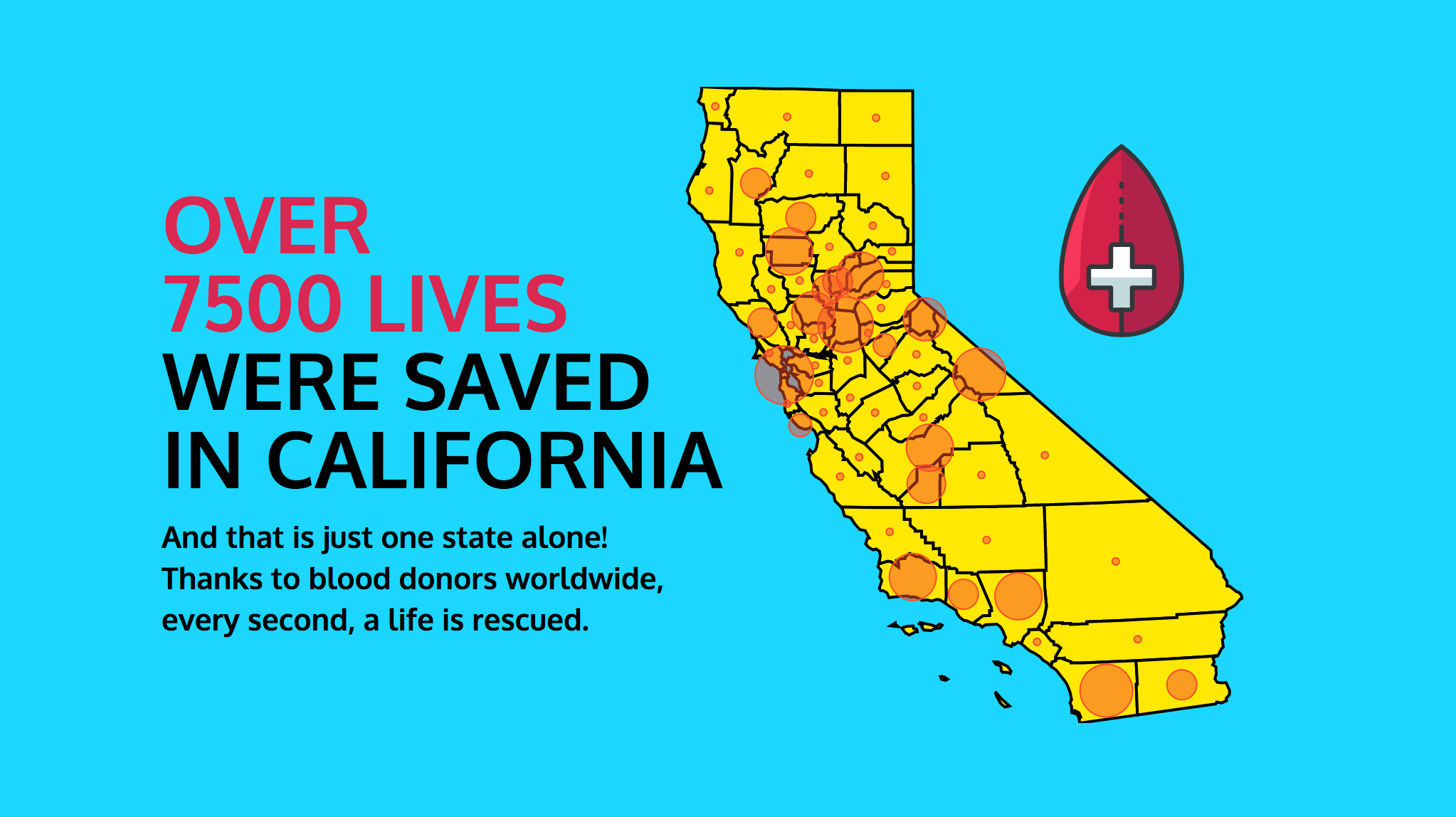
When picking fonts for your presentation, keep this technique in mind. Pick a font that has a noticeable difference between the “bold” font face and the “regular” font face. Source Sans Pro, Times New Roman, Montserrat, Arvo, Roboto, and Open Sans are all good options.
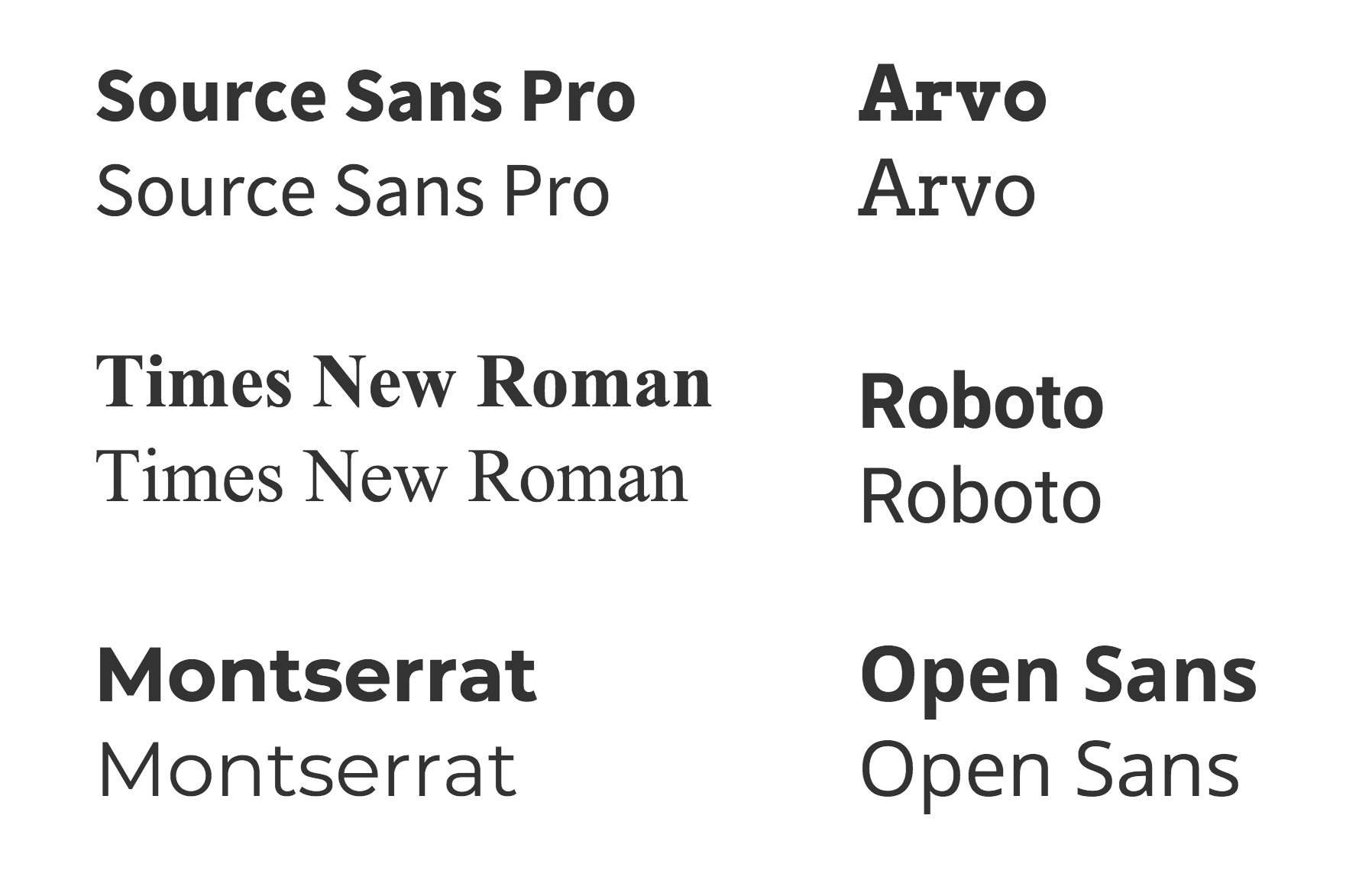
The last thing to remember when using size, weight, and color to create emphasis on a slide: don’t try to emphasize too many things on one slide.
If everything is highlighted, nothing is highlighted.
10. Apply design choices consistently to avoid distraction
Audiences are quick to pick out, and focus on, any inconsistencies in your presentation design. As a result, messy, inconsistent slide decks lead to distracted, disengaged audiences.
Design choices (fonts and colors, especially), must be applied consistently across a slide deck. The last thing you want is for your audience to pay attention to your design choices before your content.
To keep your design in check, it can be helpful to create a color palette and type hierarchy before you start creating your deck, and outline it in a basic style guide like this one:

I know it can sometimes be tempting to fiddle around with text sizes to fit longer bits of text on a slide, but don’t do it! If the text is too long to fit on a slide, it should be split up onto multiple slides anyway.
And remember, a consistent design isn’t necessarily a boring one. This social media marketing presentation applies a bright color scheme to a variety of 3-column and 2-column layouts, remaining consistent but still using creative presentation ideas.

11. Split a group presentation by topic
When giving a group presentation it’s always difficult to find the right balance of who should present which part.
Splitting a group presentation by topic is the most natural way to give everybody the chance to attempt without it seeming disjointed.
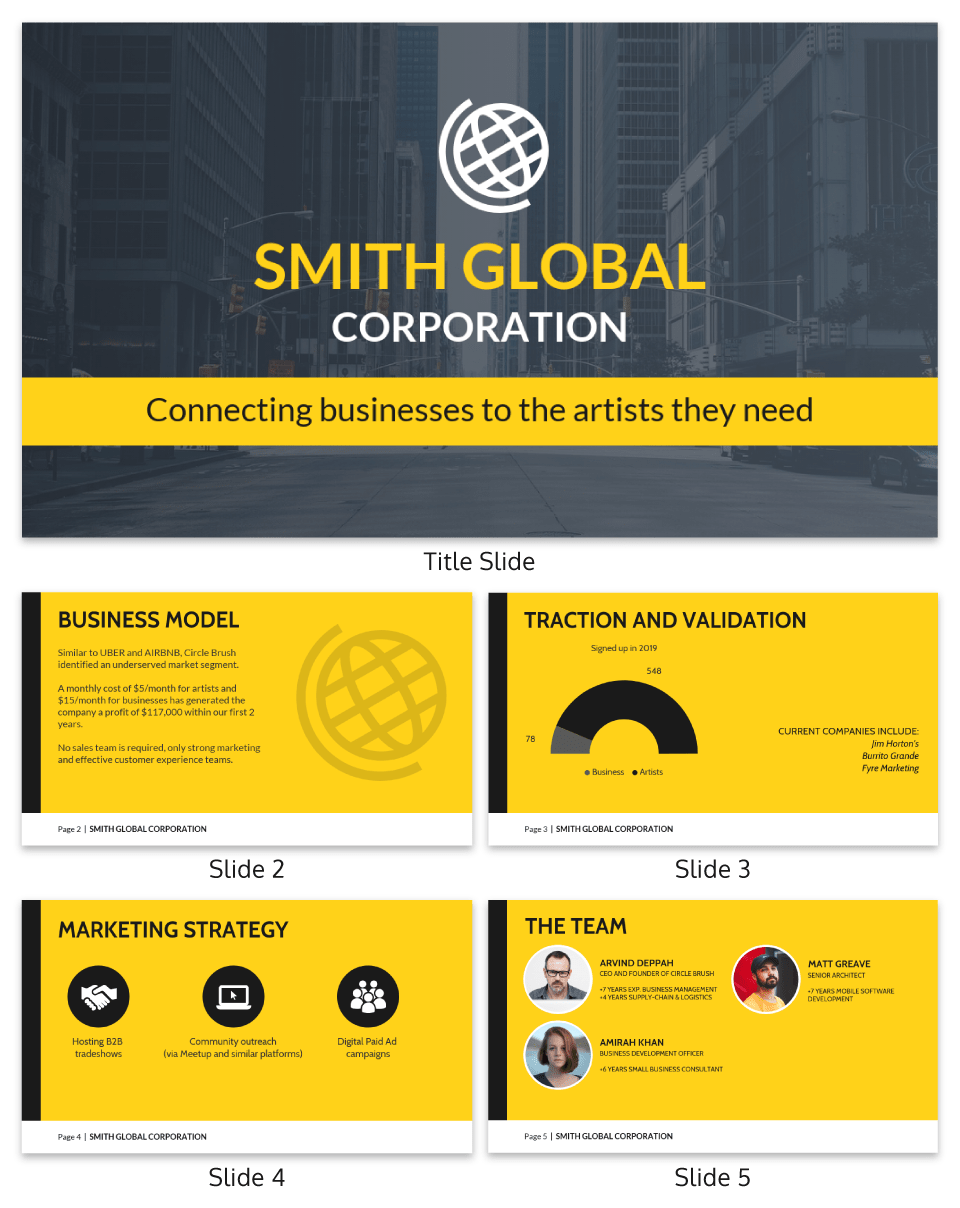
When presenting this slide deck to investors or potential clients, the team can easily take one topic each. One person can discuss the business model slide, and somebody else can talk about the marketing strategy.
Top tips for group presentations:
- Split your group presentation by topic
- Introduce the next speaker at the end of your slide
- Become an ‘expert’ in the slide that you are presenting
- Rehearse your presentation in advance so that everybody knows their cue to start speaking
12. Use a variety of page layouts to maintain your audience’s interest
Page after page of the same layout can become repetitive and boring. Mix up the layout of your slides to keep your audience interested.
In this example, the designer has used a variety of combinations of images, text, and icons to create an interesting and varied style.
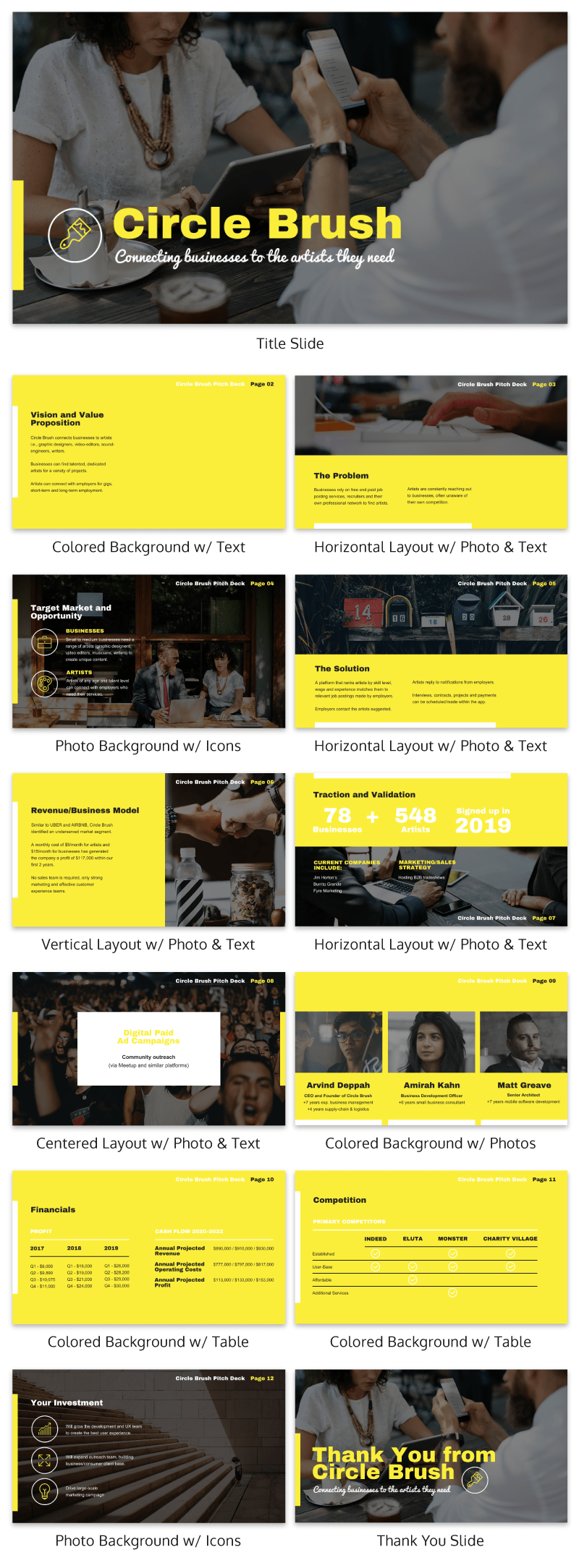
There are hundreds of different combinations of presentation layers and presentation styles that you can use to help create an engaging presentation . This style is great for when you need to present a variety of information and statistics, like if you were presenting to financial investors, or you were giving a research presentation.
Using a variety of layouts to keep an audience engaged is something that Elon Musk is an expert in. An engaged audience is a hyped audience. Check out this Elon Musk presentation revealing a new model Tesla for a masterclass on how to vary your slides in an interesting way:
13. Use presentation templates to help you get started
It can be overwhelming to build your own presentation from scratch. Fortunately, my team at Venngage has created hundreds of professional presentation templates , which make it easy to implement these design principles and ensure your audience isn’t deterred by text-heavy slides.
Using a presentation template is a quick and easy way to create professional-looking presentation skills, without any design experience. You can edit all of the text easily, as well as change the colors, fonts, or photos. Plus you can download your work in a PowerPoint or PDF Presentation format.
After your presentation, consider summarizing your presentation in an engaging manner to r each a wider audience through a LinkedIn presentation .
14. Include examples of inspiring people
People like having role models to look up to. If you want to motivate your audience, include examples of people who demonstrate the traits or achievements, or who have found success through the topic you are presenting.
15. Dedicate slides to poignant questions
While you might be tempted to fill your slides with decorative visuals and splashes of color, consider that sometimes simplicity is more effective than complexity. The simpler your slide is, the more you can focus on one thought-provoking idea.

16. Find quotes that will inspire your audience
A really good quote can stick in a person’s mind for weeks after your presentation. Ending your presentation with a quote can be a nice way to either begin or finish your presentation.
A great example of this is Tim Ferriss’ TED talk:
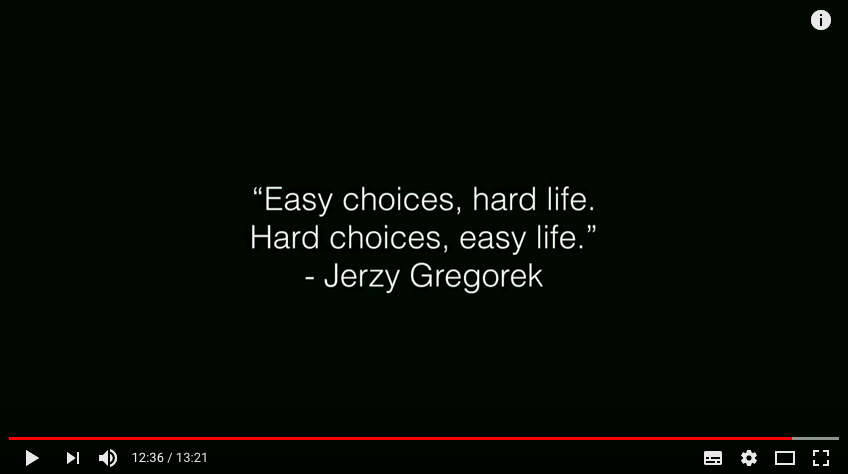
Check out the full talk below.
17. Emphasize key points with text and images
When you pair concise text with an image, you’re presenting the information to your audience in two simultaneous ways. This can make the information easier to remember, and more memorable.
Use your images and text on slides to reinforce what you’re saying out loud.
Doing this achieves two things:
- When the audience hears a point and simultaneously read it on the screen, it’s easier to retain.
- Audience members can photograph/ screencap the slide and share it with their networks.
Don’t believe us? See this tip in action with a presentation our Chief Marketing Officer Nadya gave recently at Unbounce’s CTA Conference . The combination of text and images on screen leads to a memorable presentation.

18. Label your slides to prompt your memory
Often, presenters will write out an entire script for their presentation and read it off a teleprompter. The problem is, that can often make your presentation seem too rehearsed and wooden.
But even if you don’t write a complete script, you can still put key phrases on your slides to prompt jog your memory. The one thing you have to be wary of is looking back at your slides too much.
A good presentation gets things moving! Check out the top qualities of awesome presentations and learn all about how to make a good presentation to help you nail that captivating delivery.
Audiences don’t want to watch presentations with slide decks jam-packed with text. Too much text only hurts audience engagement and understanding. Your presentation design is as important as your presentation style.
By summarizing our text and creating slides with a visual focus, we can give more exciting, memorable and impactful presentations.
Give it a try with one of our popular presentation templates:

Discover popular designs

Infographic maker

Brochure maker

White paper online

Newsletter creator

Flyer maker

Timeline maker

Letterhead maker

Mind map maker

Ebook maker

5 Tips for Creating a Presentation Outline
I like building and growing simple yet powerful products for the world and the worldwide web.
Published Date : December 4, 2020
Reading Time :
An excessive number of moderators begin making an introduction in one of two ways: a) they take a seat at their PC, open PowerPoint, and start creating slides, or b) they open a past PowerPoint introduction, duplicate a portion of the slides into another record, and add new ones that will finish their message.
Neither of these techniques is exceptionally powerful. Why? Since PowerPoint won’t assist you with making a reasonable directive for your crowd. It is just a tool to create visual help.
So, where would it be a good idea for you to begin instead? By creating a PowerPoint presentation outline. The diagram spreads out a way to help you move the crowd from where they are from the beginning of the presentation to where you need them to be toward the end. Here are tips to get your customers hooked to your material, allowing an increase in leads in the following months.
Choose a Goal
The initial phase in making a presentation outline is to settle on the objective of your introduction. Would it be that you need the crowd to know, do, comprehend, consent to, support, and so on toward the introduction’s finish? Ensure your objective is specific and attainable in the period and circumstance you have been given.
Before conceptualizing and writing down any notes, consider an objective for your presentation outline example. What message would you like to pass on ? What do you need to accomplish?
Maybe you need your pitch to raise reserves. Perhaps you opt to present another item or service to clients. Whatever the purpose behind making your pitch, choose a particular, quantifiable objective. It will control the remainder of your presentation outline.
Plan Your Presentation
At the point when you plan, it helps to take a gander at the bigger picture. Try not to consider the subtleties now! Consider the primary theme and the subject you need to cover. Be aimless towards thoughts that visit you. They’re all similarly legitimate and deserve to get noticed at this stage!
When you finish the objective and crowd investigation, you can begin content planning. I propose you consider your presentation outline’s three levels. The most significant group comprises the themes you need to cover; typically, three to five points are everything you can cover in many introductions. Separate every topic into the facts you need for that subject. After choosing what supporting data you will use to back up or demonstrate each point.
One great approach to sort out this content’s entirety is to utilize sticky notes on a whiteboard. It permits you to see the complete introduction and ensures you have no holes. It helps to move the crowd from where they are currently to where you need them toward the presentation’s finish.
Brainstorm
Brainstorming is, by a wide margin, the most famous approach to design substance. It’s the essential piece of each inventive cycle. Moreover, it’s fundamental to figuring out how to make a presentation outline. During this piece of your arranging cycle, release your psyche wild! You ought to consistently know your subject before you conceptualize it! It guides your musings to discover the arrangements and thoughts identified with your presentation!
Since this part is tied to producing thoughts concerning where your introduction will go, be creative! There are no poorly conceived notions at this stage. Record everything that rings a bell, and try not to stress over planning. Using a presentation outline template can be helpful, as well.
Ask for Feedback
It will be smart to include your loved ones as you brainstorm. If you don’t work in an office with a group to skip ideas off, get some information about your presentation’s content from the people around you. Briefly tell them about your point , and ask what appears to be generally intriguing. Understanding what individuals need to hear about your theme can help you plan an excellent presentation outline. Take note that you’re the person who knows the point best. Don’t merely request input – lead the discussion. Use methods like “brainwriting” to get the best out of everybody in the group.
1. Incorporate Visual Content
The visual substance is a fundamental fixing. The human mind measures visuals multiple times quicker than ordinary content, so having pictures for your pitch is a good thought. Remember about recordings as well. Buyers are 64 percent bound to buy an item after viewing an online video, making visual substance a decent decision on the off chance you need to create leads and boost recruits.
The best pitch decks fuse striking visuals . Others have extravagant textual styles and illustrations. The entirety of this visual content requests consideration from your crowd and makes a soothing aesthetic that will help you outclass your opponents.
At this beginning phase of pitch deck planning, you don’t need to finish the pictures you will have for your pitch. In any case, I believe it’s smart to bring up where you will utilize images in your presentation outline. You can also put together your ideas and ensure everything streams appropriately.
2. Consider Color and Design
The way you present data in your pitch is as significant as the data itself. Now is an ideal opportunity to begin pondering the text style/s you need to utilize or your slides’ shade. Research shows that red passes on passion and enthusiasm and grabs the eye of your crowd. White, then again, gives on straightforwardness and virtue.
3. Use Quotes, Testimonials, and Statistics
Quotes from senior administration assist you with passing on theoretical thoughts and make your introduction additionally captivating. You ought to acquire any ideas you need to use in your introduction during the planning stage.
Testimonials from clients and customers also demonstrate famously. Research shows that positive audits impact buying choices and increment trust.
Statistics add some profundity to your presentation. Figures and facts in the industry back up any cases you make and improve engagement. Find significant insights while making your outline. You don’t have to incorporate any real quotes, testimonials, or statistics. Simply write down where you need to put them in your presentation outline.
4. Outlining Your Presentation
Since you’ve planned and brainstormed your presentation, it’s an ideal opportunity to manage all the points in your content . The primary thing you have to do is think of your presentation’s central themes. A theme is an enormous point that you’ll be attempting to contend for. Your topics are categorized into issues or themes. There are generally three or four fundamental themes for every presentation outline. Make an effort not to have more; you genuinely need to devote sufficient opportunity to each one.
After choosing your themes, it’s finally time to put them together. To do this, you’ll have to decide what your main topic is among them. Envision you’re giving a presentation about the current leads. You aim to introduce another, more consumer-friendly approach to producing leads. Your three principle topics are the morals of change, web-based media, and client experience.
Preferably, you’d need to present the principal subject for some essential hypothesis of customer morals. Afterward, proceed to the field of utilization in the online media and then discuss the client experience as a potential solution. Your last point should consistently be the apparent ‘solution’ of the current issue or your ‘main’ theme. You should, in every case, close with the most grounded point you have!
Get a Software for Organizing
When you finish the themes, put them all on paper and leave some space in the middle of each point. It doesn’t generally need to be a bit of paper!
You can practically compose your outline anyplace you want. If you need to make plenty of presentation outlines, getting some authoritative programming to assist you with organizing and planning is a brilliant venture. In case you’re uncertain about paying, there are a lot of free outliners to browse, too. These tools are useful for making a visual presentation of your ideas.
They help you sort out the theoretical ideas by placing them into spatial connections you can notice. It helps put every one of your thoughts into the setting. Individuals who use Outliners state they assist them with seeing the full image of their content. It allows planning to be substantially more effective and straightforward.
Use Presentation Outline Templates
An extraordinary method to make your outline without using software is utilizing the intensity of PowerPoint layouts! Perhaps the best approach to managing your content is to discover the presentation outline template that suits it perfectly. You can peruse various websites with the expectation of complimentary designs, and perhaps you’ll find what you need.
There are a lot of presentation outline templates zeroing in on specialties, topics, and subjects. Discover the layouts with classifications that suit your theme the most. Continue to fill the forms with your substance, and take a gander at the structure of your whole presentation in a solitary outline or slide!
Differentiate Between Arguments and Statements
Central matters are your reference key points in the outline, like asserting something about an item, service, business thought, etc. Whatever your PowerPoint presentation outline is about – you’re discussing a specific theme.
Also, at whatever point you’re doing that – you’re coming from the spot of power. You’ll need to argue for your position to demonstrate your passion and the legitimacy of your primary concern. Every presentation outline should have close to four central matters or points.
Make sure to support your statements with multiple arguments. There are typically 3-4 opinions for every primary point. Ideas are your exploration; they’re the rationale behind your assertions. They’re all you need to state for your assertion. So better ensure you arrange it well.
The overall guidance is to begin with your most vulnerable argument and end with the most grounded. It applies to every primary point independently, yet you can utilize this rationale for the primary issues and apply them in your presentation outline template.
Continuously Pre-Draft
Pre-drafting is a fascinating process of figuring out how to make an outlined presentation. It’s intriguing because it consolidates brainstorming and planning. This progression is recording whichever data you realize you’ll include in your ideas. If you already have a perception of your arguments, odds are you understand the issue here. If you think of an account, a joke, a decent sentence, or a bit of research – narrow it down to where it has a place in your diagram.
For a presentation outline example, you realize you will refer to it someplace since it piqued your interest in the subject by ongoing research. Regardless of whether you haven’t wrapped up the study, you can securely expect to use this research as an argument. Write it down under the primary subject you’ll use to help, and your work will be much simpler when you start drafting!
5. Present a call to action
A call-to-action is superior to a ‘thank you’ slide. It urges your crowd to make a move after your presentation. While making your presentation outline, think about a short, smart source of inspiration that prompts a reaction. A call-to-action is your last opportunity to draw in your crowd as you present. For instance, it would help if you urged individuals to join your mailing list. You can then incorporate a connection to your site so individuals can download a demo version of your item.
Flesh Out The Body Of Your Presentation
Anyway, you have your start and finishing in order, yet how else do you manage your outline? It is where you chip away at the body of your discourse. You must consider what you need to state before your start and end. Here are some speech -composing tips I have expounded on before.
1. Compose the Main Points of Your Outline in Order
It might be simpler to compose list items or even a numbered list. Rundown your primary concerns arranged by what you need to discuss . If the subjects don’t appear to flow from the start, it is all right to re-organize them in your presentation outline template.
You can likewise choose now if there is anything you need to add or deduct. If you have an inclination that you’ve committed an error, don’t stress! It is all right to roll out any improvements en route.
2. Add Sub-Points and Transitions to Your Topics
Add sub-focuses to your central matters to add tissue to your presentation outline template. Regardless of whether you need to keep it straightforward, sub-focuses may help you remain on target and recollect what you plan to state.
You can likewise add to the thoughts that your central matters present. Ensure that the advances start with one point, then onto the next stream, quickly starting with one thing and then onto the next.
3. Remember the Essential Details!
Are there any uncommon subtleties that you need to recall for your introduction? Put these in your framework so you remember them. You can incorporate significant names, dates, and areas you must recollect.
Why is a Presentation Outline So Important, Anyway?
While perusing this article, you might ask why you need a blueprint for your presentation. It might be incredibly perplexing to you if you intend to give a discourse without notes. However, a presentation outline can be beneficial regardless of the introduction you plan to provide for your crowd.
As I said previously, the central matter of a blueprint is to improve the primary motivation behind your speech further. But at the same time, I will give you a rundown of some more reasons why I suggest an outline is significant.
- An outline rather than full content will give you more opportunities to extemporize during your introduction. That is why making a presentation outline template is an incredible first methodology if you are talking without notes or attempting to remember a discourse in a brief timeframe.
- Outlining encourages you to see whether your primary concerns and sub-focuses stream efficiently. If you make your blueprint and understand that some of your focus doesn’t flow, you can re-compose vital parts without much stretch.
- If you don’t know where to begin planning for your speech , at that point, composing a presentation outline template is a decent initial step to get you out.
- You will have the option to take a gander at the associations between your thoughts. It may even help you acknowledge the need to add or remove certain things from your discourse.
Regardless of what introduction you intend to give, a vital outline will prepare you, and you will be all set.
How should group presentations be structured to ensure smooth transitions between speakers?
Smooth group presentations rely on structure: clear transitions, delivery, and speaker handoffs. Summarize past points, introduce the next speaker and their topic, and visually acknowledge them to maintain flow and engage the audience. Remember, practice makes perfect!
What are some guidelines for effectively using slides in a presentation?
Captivate your audience with impactful slides, not information overload. Keep them concise with minimal text, leverage visuals for quick understanding, ensure clarity with large fonts, pace yourself to let them absorb content, and follow the 10-20-30 rule for focus and engagement. Your message will shine through!
What are key slides that should be included in a presentation?
Hook your audience with an introduction slide, guide them with key points, and solidify their understanding with a summary slide. Image slides are your secret weapon for engagement, so sprinkle them throughout! These essentials will keep your presentation focused and impactful.
How can physical movement be incorporated into a presentation to enhance audience engagement?
On the stage! Strategic movement can transform your presentation. Start center, move left for point 1, back to center for emphasis, then right for point 2. Keep them visually engaged and your message crystal clear. End back center for a powerful finish!
How can I structure a presentation using the remaining method when presenting a controversial topic?
Controversial topic? Conquer it with the “remaining” method! Start by clearly framing the issue, then dive deep with logic and emotion. Acknowledge and dismantle opposing solutions, paving the way for your unique answer – the “remaining” solution. Boom! Persuasive, engaging, and audience-approved.
Presently, you have all you require to design your next presentation outline. Hopefully, you comprehend why layouts are significant. They’re the very establishment of your PowerPoint presentation outline. So next time, before you begin scripting, think about planning. Commit some ideal opportunity to the inventive piece of the cycle and conceptualize.
Brainstorming is tied in with creating as many thoughts and ideas as possible, so include your family and friends along the way and go insane! Consider putting resources into outliners, or get some perfect free presentation outline templates to arrange the information for you. Keep in mind that all you say requires backup and content planning.
Another thing, if you propel yourself somewhat more, is to become familiar with the specialty of theme sentences. Your presentation will probably outline itself if you figure out how to utilize them astutely.
Download the Orai app today for a free trial to get the best for your next presentation.

You might also like

How Many Words is a 5-Minute Speech

Good Attention Getters for Speeches with 10+ Examples!
Quick links.
- Presentation Topics
Useful Links
- Start free trial
- The art of public speaking
- improve public speaking
- mastering public speaking
- public speaking coach
- professional speaking
- public speaking classes - Courses
- public speaking anxiety
- © Orai 2023

- PRESENTATION SKILLS
Top Tips for Effective Presentations
Search SkillsYouNeed:
Presentation Skills:
- A - Z List of Presentation Skills
- General Presentation Skills
- What is a Presentation?
- Preparing for a Presentation
- Organising the Material
- Writing Your Presentation
- Deciding the Presentation Method
- Managing your Presentation Notes
- Working with Visual Aids
- Presenting Data
- Managing the Event
- Coping with Presentation Nerves
- Dealing with Questions
- How to Build Presentations Like a Consultant
- 7 Qualities of Good Speakers That Can Help You Be More Successful
- Self-Presentation in Presentations
- Specific Presentation Events
- Remote Meetings and Presentations
- Giving a Speech
- Presentations in Interviews
- Presenting to Large Groups and Conferences
- Giving Lectures and Seminars
- Managing a Press Conference
- Attending Public Consultation Meetings
- Managing a Public Consultation Meeting
- Crisis Communications
- Elsewhere on Skills You Need:
- Communication Skills
- Facilitation Skills
- Teams, Groups and Meetings
- Effective Speaking
- Question Types
Subscribe to our FREE newsletter and start improving your life in just 5 minutes a day.
You'll get our 5 free 'One Minute Life Skills' and our weekly newsletter.
We'll never share your email address and you can unsubscribe at any time.
How can you make a good presentation even more effective?
This page draws on published advice from expert presenters around the world, which will help to take your presentations from merely ‘good’ to ‘great’.
By bringing together advice from a wide range of people, the aim is to cover a whole range of areas.
Whether you are an experienced presenter, or just starting out, there should be ideas here to help you to improve.
1. Show your Passion and Connect with your Audience
It’s hard to be relaxed and be yourself when you’re nervous.
But time and again, the great presenters say that the most important thing is to connect with your audience, and the best way to do that is to let your passion for the subject shine through.
Be honest with the audience about what is important to you and why it matters.
Be enthusiastic and honest, and the audience will respond.
2. Focus on your Audience’s Needs
Your presentation needs to be built around what your audience is going to get out of the presentation.
As you prepare the presentation, you always need to bear in mind what the audience needs and wants to know, not what you can tell them.
While you’re giving the presentation, you also need to remain focused on your audience’s response, and react to that.
You need to make it easy for your audience to understand and respond.
3. Keep it Simple: Concentrate on your Core Message
When planning your presentation, you should always keep in mind the question:
What is the key message (or three key points) for my audience to take away?
You should be able to communicate that key message very briefly.
Some experts recommend a 30-second ‘elevator summary’, others that you can write it on the back of a business card, or say it in no more than 15 words.
Whichever rule you choose, the important thing is to keep your core message focused and brief.
And if what you are planning to say doesn’t contribute to that core message, don’t say it.
4. Smile and Make Eye Contact with your Audience
This sounds very easy, but a surprisingly large number of presenters fail to do it.
If you smile and make eye contact, you are building rapport , which helps the audience to connect with you and your subject. It also helps you to feel less nervous, because you are talking to individuals, not to a great mass of unknown people.
To help you with this, make sure that you don’t turn down all the lights so that only the slide screen is visible. Your audience needs to see you as well as your slides.
5. Start Strongly
The beginning of your presentation is crucial. You need to grab your audience’s attention and hold it.
They will give you a few minutes’ grace in which to entertain them, before they start to switch off if you’re dull. So don’t waste that on explaining who you are. Start by entertaining them.
Try a story (see tip 7 below), or an attention-grabbing (but useful) image on a slide.
6. Remember the 10-20-30 Rule for Slideshows
This is a tip from Guy Kawasaki of Apple. He suggests that slideshows should:
- Contain no more than 10 slides;
- Last no more than 20 minutes; and
- Use a font size of no less than 30 point.
This last is particularly important as it stops you trying to put too much information on any one slide. This whole approach avoids the dreaded ‘Death by PowerPoint’.
As a general rule, slides should be the sideshow to you, the presenter. A good set of slides should be no use without the presenter, and they should definitely contain less, rather than more, information, expressed simply.
If you need to provide more information, create a bespoke handout and give it out after your presentation.
7. Tell Stories
Human beings are programmed to respond to stories.
Stories help us to pay attention, and also to remember things. If you can use stories in your presentation, your audience is more likely to engage and to remember your points afterwards. It is a good idea to start with a story, but there is a wider point too: you need your presentation to act like a story.
Think about what story you are trying to tell your audience, and create your presentation to tell it.
Finding The Story Behind Your Presentation
To effectively tell a story, focus on using at least one of the two most basic storytelling mechanics in your presentation:
Focusing On Characters – People have stories; things, data, and objects do not. So ask yourself “who” is directly involved in your topic that you can use as the focal point of your story.
For example, instead of talking about cars (your company’s products), you could focus on specific characters like:
- The drivers the car is intended for – people looking for speed and adventure
- The engineers who went out of their way to design the most cost-effective car imaginable
A Changing Dynamic – A story needs something to change along the way. So ask yourself “What is not as it should be?” and answer with what you are going to do about it (or what you did about it).
For example…
- Did hazardous road conditions inspire you to build a rugged, all-terrain jeep that any family could afford?
- Did a complicated and confusing food labelling system lead you to establish a colour-coded nutritional index so that anybody could easily understand it?
To see 15 more actionable storytelling tips, see Nuts & Bolts Speed Training’s post on Storytelling Tips .
8. Use your Voice Effectively
The spoken word is actually a pretty inefficient means of communication, because it uses only one of your audience’s five senses. That’s why presenters tend to use visual aids, too. But you can help to make the spoken word better by using your voice effectively.
Varying the speed at which you talk, and emphasising changes in pitch and tone all help to make your voice more interesting and hold your audience’s attention.
For more about this, see our page on Effective Speaking .
9. Use your Body Too
It has been estimated that more than three quarters of communication is non-verbal.
That means that as well as your tone of voice, your body language is crucial to getting your message across. Make sure that you are giving the right messages: body language to avoid includes crossed arms, hands held behind your back or in your pockets, and pacing the stage.
Make your gestures open and confident, and move naturally around the stage, and among the audience too, if possible.
10. Relax, Breathe and Enjoy
If you find presenting difficult, it can be hard to be calm and relaxed about doing it.
One option is to start by concentrating on your breathing. Slow it down, and make sure that you’re breathing fully. Make sure that you continue to pause for breath occasionally during your presentation too.
For more ideas, see our page on Coping with Presentation Nerves .
If you can bring yourself to relax, you will almost certainly present better. If you can actually start to enjoy yourself, your audience will respond to that, and engage better. Your presentations will improve exponentially, and so will your confidence. It’s well worth a try.
Improve your Presentation Skills
Follow our guide to boost your presentation skills learning about preparation, delivery, questions and all other aspects of giving effective presentations.
Start with: What is a Presentation?
Continue to: How to Give a Speech Self Presentation
See also: Five Ways You Can Do Visual Marketing on a Budget Can Presentation Science Improve Your Presentation? Typography – It’s All About the Message in Your Slides

Microsoft 365 Life Hacks > Presentations > How to create an inspirational PowerPoint presentation
How to create an inspirational PowerPoint presentation
Creating an inspirational PowerPoint presentation involves more than just putting together slides; it’s about crafting a moving story that resonates with your audience and leaves a lasting impact. See how you can elevate your material to truly call your audience to agree with you or ask for action.

What is an inspirational presentation?
Easy and effective PowerPoint tools make it simple to assemble a compelling slideshow. You can choose from creative templates , make animated shorts , or implement video clips via Clipchamp .
However, PowerPoint works the best when you imbue it with a narrative that has the power to captivate. Whether you’re trying to motivate and uplift your audience, offer encouraging advice, or ask them to act or change their perspective, an inspirational presentation carries the same motivational speaking skills as a sales pitch.
Therefore, the key to a successful inspirational presentation is to deliver a clear, impactful message that is both engaging and memorable. Structure your presentation as a narrative, with a clear beginning, middle, and end. To elevate the storytelling qualities of your presentation, introduce a conflict or challenge and describe the journey of overcoming it. While not every topic that you choose to inspire others will involve a conflict, an inspirational presentation will nonetheless conclude with a resolution that leaves your audience inspired.

Tell your story with captivating presentations
Powerpoint empowers you to develop well-designed content across all your devices
How to inspire others with your presentational skills
Any good presentation begins with a strong outline . The outline of your presentation should adhere to your goals:
- To persuade people to share your point of view.
- To present something new or give a new perspective on something old.
- To inspire, motivate, and call for action or change.
Keep these goals in mind when you begin outlining. Start your outline with a strong theme that aligns with the message you want to convey. This should be relevant to your audience and your objectives and serve as the backbone of your presentation in guiding the narrative and supporting your message.
Use motivational quotes and visuals
Sprinkle your presentation with quotes from leaders and famous thinkers that align you’re your theme. Pair these quotes with compelling visuals to enhance their impact. Keep in mind that in a presentation that uses visual aids, these quotes are the “icing on the cake” of the message you’re trying to convey; they can serve as powerful reminders of the key points you want your audience to remember.
Share success stories
Incorporating success stories that are related to your topic can convey a sense of success to your audience. Stories of achievable potential can provide examples on how the concepts or strategies you’re sharing can help benefit your audience. This can make otherwise abstract ideas more tangible—and therefore achievable.
Engage your audience
Audience interaction—in the form of quizzes, can make your presentation more memorable. Include questions to ponder, prompt discussions, or incorporate quick activities that reinforce the message. This engagement makes the experience more dynamic and personal for the audience, increasing the impact of your presentation.
Brush up on presentation skills
The key to an inspirational presentation is to balance the use of visual aids and public speaking skills. This can be easier said than done, of course—which is why it’s vital to learn how to practice your presentations , incorporate humor and wit into your speech, or overcome the fear of public speaking that plagues an estimated 73% of the population.
Creating an inspirational presentation requires thoughtful preparation, a balance of visual aids and speaking, as well as a creative approach. By following these guidelines, you can develop a presentation that not only informs but also inspires and motivates your audience.
Get started with Microsoft 365
It’s the Office you know, plus the tools to help you work better together, so you can get more done—anytime, anywhere.
Topics in this article
More articles like this one.

How to create an educational presentation
Use PowerPoint to create dynamic and engaging presentations that foster effective learning.

Five tips for choosing the right PowerPoint template
Choose an appropriate PowerPoint template to elevate your presentation’s storytelling. Consider time length, audience and other presentation elements when selecting a template.

How you can use AI to help you make the perfect presentation handouts
Learn how AI can help you organize and create handouts for your next presentation.

How to use AI to help improve your presentations
Your PowerPoint presentations are about to get a boost when you use AI to improve a PowerPoint presentation.

Everything you need to achieve more in less time
Get powerful productivity and security apps with Microsoft 365

Explore Other Categories
Purdue Online Writing Lab Purdue OWL® College of Liberal Arts
Welcome to the Purdue Online Writing Lab

Welcome to the Purdue OWL
This page is brought to you by the OWL at Purdue University. When printing this page, you must include the entire legal notice.
Copyright ©1995-2018 by The Writing Lab & The OWL at Purdue and Purdue University. All rights reserved. This material may not be published, reproduced, broadcast, rewritten, or redistributed without permission. Use of this site constitutes acceptance of our terms and conditions of fair use.
The Online Writing Lab at Purdue University houses writing resources and instructional material, and we provide these as a free service of the Writing Lab at Purdue. Students, members of the community, and users worldwide will find information to assist with many writing projects. Teachers and trainers may use this material for in-class and out-of-class instruction.
The Purdue On-Campus Writing Lab and Purdue Online Writing Lab assist clients in their development as writers—no matter what their skill level—with on-campus consultations, online participation, and community engagement. The Purdue Writing Lab serves the Purdue, West Lafayette, campus and coordinates with local literacy initiatives. The Purdue OWL offers global support through online reference materials and services.
A Message From the Assistant Director of Content Development
The Purdue OWL® is committed to supporting students, instructors, and writers by offering a wide range of resources that are developed and revised with them in mind. To do this, the OWL team is always exploring possibilties for a better design, allowing accessibility and user experience to guide our process. As the OWL undergoes some changes, we welcome your feedback and suggestions by email at any time.
Please don't hesitate to contact us via our contact page if you have any questions or comments.
All the best,
Social Media
Facebook twitter.

IMAGES
VIDEO
COMMENTS
Here are the steps to follow: Provide a Prompt: Enter a brief description of your presentation topic into the AI tool. Customize the Output: Examine the generated outline. You may need to modify the titles of the slides and their order to better suit your needs.
Follow these steps when creating an outline for your presentation: 1. Consider the purpose of your presentation. When creating a presentation outline, determine your goal. To find this, think about what you want your audience to obtain or support after your discussion. For example, a nonprofit that builds wells for impoverished communities may ...
Enhance with Quotes, Testimonials, or Data. Make your presentation more interesting by adding extra info like quotes, testimonials, or data. It can make your audience more engaged and reinforce your message. 3. Visualize Your Concepts. How you show your ideas matters a lot.
Tips for Creating a Compelling Presentation Outline Crafting a presentation outline requires careful consideration of various elements. To enhance your outline and ensure a compelling presentation, it's important to organize your ideas effectively, incorporate visual content strategically, and engage your audience from start to finish.
Method 2: Create a presentation outline using an AI presentation maker. If you're short on time or looking for a quick way to get a first draft of a presentation outline that you can then refine, using an AI presentation maker is a great option. ... Tips for newcomers; V. Conclusion. Summarize key points; Call to action;
Flesh out the points and sub-points from your outline. Decide very early on if you want to give your speech with or without notes. Revise your drafts as much as possible until you have created a full speech. If you are going to speak with notes, write some of the information from your outline onto cue cards.
Organize your slides. Include a title slide with the presentation topic, your name, and date. Add a relevant image or graphic to set the tone. Provide an agenda or outline slide to give the audience an overview of what to expect. Use section divider slides to clearly separate different parts of your presentation.
A presentation outline acts as the backbone of a successful presentation, providing a roadmap for the presenter and ensuring that key points are delivered clearly. In this article, we will examine the intricacies of presentation outlines, explore their significance, and some tips for crafting an effective outline to enhance the presentation ...
Presentation Outline. Introduction. Keep it under 5 minutes. Introduce yourself, your company, and the topic of discussion. Explain the significance and topic relevance. Specify your approach to the topic. Preview the main points or key idea. Make a transition to the main points. Main Body.
This helps you manage your time effectively during the actual presentation. Notes or Reminders: Add any reminders, cues, or notes to yourself that will help you deliver your presentation effectively. These can include tips on delivery, body language, or specific points to emphasize. Presentation Outline Examples. Image: freepik.
Here is a step-by-step guide to creating the outline for your presentation: 1. Know the Purpose of Your Presentation. The essential part of creating a presentation outline is to determine the goal of your presentation. To find this, consider what you want your audience to learn or support following your talk.
5 More Powerful Presentation Writing Tips. Before writing your presentation outline think consider the following: 1. Have One Idea Per Slide The minimal design in the Grey PowerPoint template make it easy to keep text minimal on your slide. Your slides should just have your main points. If there's too much on your slide, it can be overwhelming ...
Using a presentation outline template. Templates are a great starting point for creating documents like a presentation outline. You can create your own template or use an existing template. A basic presentation outline example is: [Presentation Title] Introduction Attention grabber; Purpose of presentation; Main topic 1 Subtopic 1.1; Subtopic 1.2
Open Word document. Select View > Outline. This will automatically generate an outline and open the Outlining tools. If there are headings in your document, you will witness those headings organized by level (from H1 to H9). If there are no headings in the document, the outline will appear as a bullet list.
Structure Your Outline: Organize your main points into a logical flow. This typically follows a three-act structure: Introduction: Grab your audience's attention, introduce yourself and the topic, and clearly state your objective. Main Body: Present your key points in a clear and concise manner. Use storytelling techniques and visuals to ...
Apply the 10-20-30 rule. Apply the 10-20-30 presentation rule and keep it short, sweet and impactful! Stick to ten slides, deliver your presentation within 20 minutes and use a 30-point font to ensure clarity and focus. Less is more, and your audience will thank you for it! 9. Implement the 5-5-5 rule. Simplicity is key.
Creating a presentation outline helps the presenter stay organized and focused, and makes it easier for the audience to follow the content and understand the main concepts of the presentation. 11 tips to create more effective presentations 1. Decide on a Goal
Presentation skills are the abilities and qualities necessary for creating and delivering a compelling presentation that effectively communicates information and ideas. They encompass what you say, how you structure it, and the materials you include to support what you say, such as slides, videos, or images. You'll make presentations at various ...
Here are a few tips for business professionals who want to move from being good speakers to great ones: be concise (the fewer words, the better); never use bullet points (photos and images paired ...
This clarifies the overall purpose of your talk and reinforces your reason for being there. Follow these steps: Signal that it's nearly the end of your presentation, for example, "As we wrap up/as we wind down the talk…". Restate the topic and purpose of your presentation - "In this speech I wanted to compare…". 5.
Emphasize key points with text and images. Label your slides to prompt your memory. 1. Include less text and more visuals in your presentation design. According to David Paradi's annual presentation survey, the 3 things that annoy audiences most about presentations are: Speakers reading their slides.
Perhaps the best approach to managing your content is to discover the presentation outline template that suits it perfectly. You can peruse various websites with the expectation of complimentary designs, and perhaps you'll find what you need. There are a lot of presentation outline templates zeroing in on specialties, topics, and subjects.
Try a story (see tip 7 below), or an attention-grabbing (but useful) image on a slide. 6. Remember the 10-20-30 Rule for Slideshows. This is a tip from Guy Kawasaki of Apple. He suggests that slideshows should: Contain no more than 10 slides; Last no more than 20 minutes; and. Use a font size of no less than 30 point.
To inspire, motivate, and call for action or change. Keep these goals in mind when you begin outlining. Start your outline with a strong theme that aligns with the message you want to convey. This should be relevant to your audience and your objectives and serve as the backbone of your presentation in guiding the narrative and supporting your ...
Step #4: Add multimedia content. At this stage, your presentation probably looks good-looking, but static. Let's make it interactive by adding unique multimedia presentation tools. Start adding multimedia content to the slides that need it.
Mission. The Purdue On-Campus Writing Lab and Purdue Online Writing Lab assist clients in their development as writers—no matter what their skill level—with on-campus consultations, online participation, and community engagement. The Purdue Writing Lab serves the Purdue, West Lafayette, campus and coordinates with local literacy initiatives.
Prepare your Presentation (PowerPoint) We suggest using PowerPoint for your presentation slides, but if you are more comfortable with a different presentation platform (i.e. Canva, Keynote, Google Slides) you may do so. • Use the EMDRIA template. Choose one of the EMDRIA-provided templates. • Focus on Learning Objectives. Attendees will ...